ASUSTeK Computer P505 PDA phone User Manual Appendix 1 P505 UserMan
ASUSTeK Computer Inc PDA phone Appendix 1 P505 UserMan
Contents
Manual 1
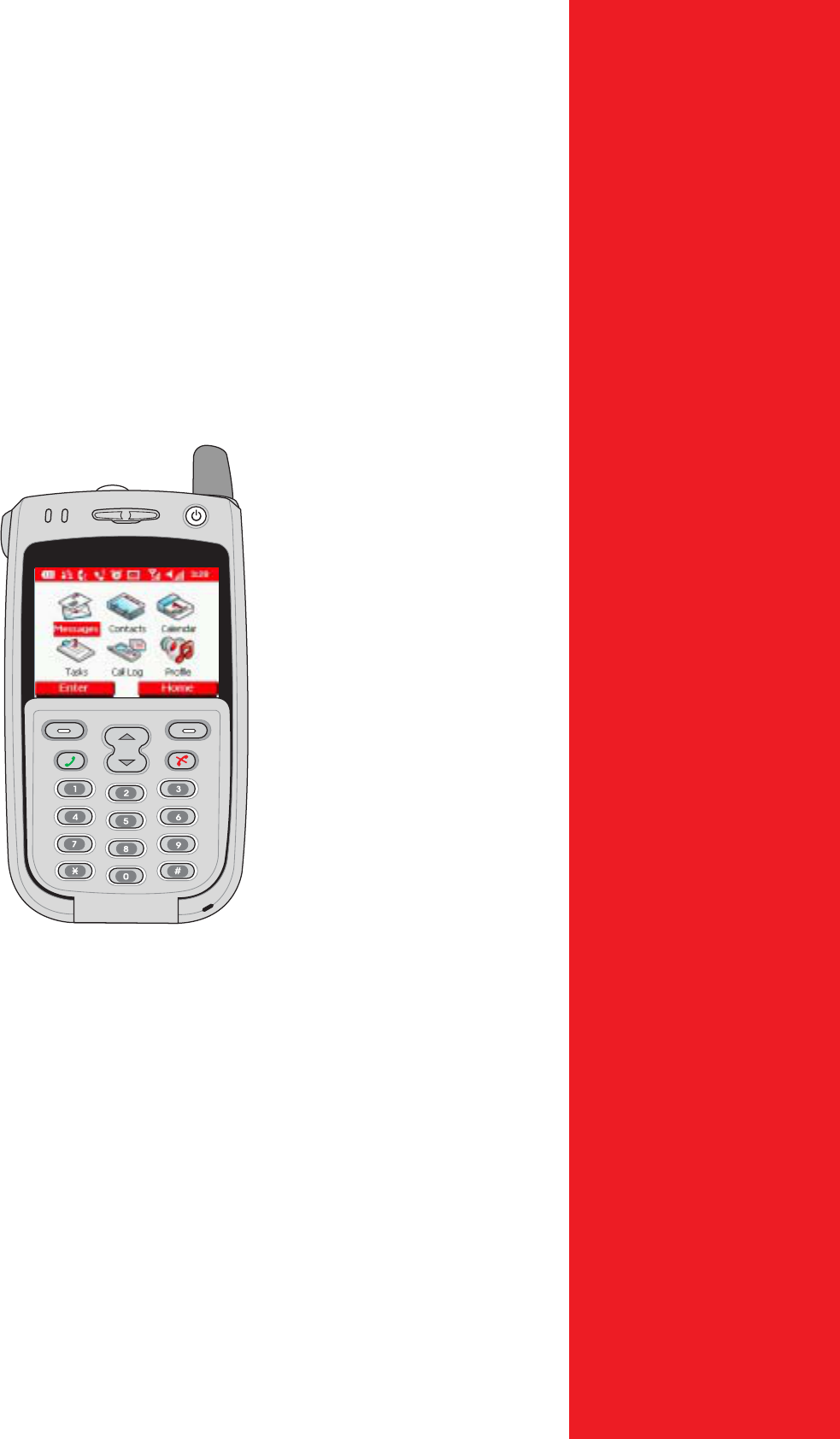
Pocket PCPocket PC
Pocket PCPocket PC
Pocket PC
P505P505
P505P505
P505
User handbookUser handbook
User handbookUser handbook
User handbook

iiii
iiii
ii
E1658E1658
E1658E1658
E1658
First edition V1First edition V1
First edition V1First edition V1
First edition V1
November 2004November 2004
November 2004November 2004
November 2004
Copyright © 2004 ASUSTeK COMPUTER INC. All Rights Reserved.
No part of this manual, including the products and software described in it, may be reproduced,
transmitted, transcribed, stored in a retrieval system, or translated into any language in any form
or by any means, except documentation kept by the purchaser for backup purposes, without the
express written permission of ASUSTeK COMPUTER INC. (“ASUS”).
Product warranty or service will not be extended if: (1) the product is repaired, modified or
altered, unless such repair, modification of alteration is authorized in writing by ASUS; or (2)
the serial number of the product is defaced or missing.
ASUS PROVIDES THIS MANUAL “AS IS” WITHOUT WARRANTY OF ANY KIND, EITHER
EXPRESS OR IMPLIED, INCLUDING BUT NOT LIMITED TO THE IMPLIED WARRANTIES
OR CONDITIONS OF MERCHANTABILITY OR FITNESS FOR A PARTICULAR PURPOSE.
IN NO EVENT SHALL ASUS, ITS DIRECTORS, OFFICERS, EMPLOYEES OR AGENTS BE
LIABLE FOR ANY INDIRECT, SPECIAL, INCIDENTAL, OR CONSEQUENTIAL DAMAGES
(INCLUDING DAMAGES FOR LOSS OF PROFITS, LOSS OF BUSINESS, LOSS OF USE
OR DATA, INTERRUPTION OF BUSINESS AND THE LIKE), EVEN IF ASUS HAS BEEN
ADVISED OF THE POSSIBILITY OF SUCH DAMAGES ARISING FROM ANY DEFECT OR
ERROR IN THIS MANUAL OR PRODUCT.
SPECIFICATIONS AND INFORMATION CONTAINED IN THIS MANUAL ARE FURNISHED
FOR INFORMATIONAL USE ONLY, AND ARE SUBJECT TO CHANGE AT ANY TIME
WITHOUT NOTICE, AND SHOULD NOT BE CONSTRUED AS A COMMITMENT BY ASUS.
ASUS ASSUMES NO RESPONSIBILITY OR LIABILITY FOR ANY ERRORS OR
INACCURACIES THAT MAY APPEAR IN THIS MANUAL, INCLUDING THE PRODUCTS
AND SOFTWARE DESCRIBED IN IT.
Products and corporate names appearing in this manual may or may not be registered
trademarks or copyrights of their respective companies, and are used only for identification or
explanation and to the owners’ benefit, without intent to infringe.

iiiiii
iiiiii
iii
User handbook topicsUser handbook topics
User handbook topicsUser handbook topics
User handbook topics
This user handbook contains the information you need to efficiently
use the Pocket PC.
••
••
•Chapter 1 - Getting startedChapter 1 - Getting started
Chapter 1 - Getting startedChapter 1 - Getting started
Chapter 1 - Getting started..........................................................
..........................................................
............................. 1-11-1
1-11-1
1-1
This chapter introduces the physical features of the Pocket
PC and tells you how to set up and power up the device.
••
••
•Chapter 2 - Learning the basicsChapter 2 - Learning the basics
Chapter 2 - Learning the basicsChapter 2 - Learning the basics
Chapter 2 - Learning the basics ..............................................
..............................................
....................... 2-12-1
2-12-1
2-1
This chapter teaches you the basic Pocket PC functions. You
will learn how to enter text, find and organise information,
customise the device, and know the bundled utilities.
••
••
•Chapter 3 - Synchronising dataChapter 3 - Synchronising data
Chapter 3 - Synchronising dataChapter 3 - Synchronising data
Chapter 3 - Synchronising data................................................
................................................
........................ 3-13-1
3-13-1
3-1
This chapter tells you how to use the Microsoft
®
ActiveSync
®
application that synchronises data between
your Pocket PC and your desktop or notebook computer.
••
••
•Chapter 4 - Using Pocket OutlookChapter 4 - Using Pocket Outlook
Chapter 4 - Using Pocket OutlookChapter 4 - Using Pocket Outlook
Chapter 4 - Using Pocket Outlook ........................................
........................................
.................... 4-14-1
4-14-1
4-1
This chapter details the procedures in using the Microsoft
®
Pocket Outlook Calendar, Tasks, Notes, and Contacts.
••
••
•Chapter 5 - Phone featuresChapter 5 - Phone features
Chapter 5 - Phone featuresChapter 5 - Phone features
Chapter 5 - Phone features ..........................................................
..........................................................
............................. 5-15-1
5-15-1
5-1
This chapter provides information on how to use the Pocket
PC phone features using the Vodafone Menu and
Phone applications.
••
••
•Chapter 6 - Messaging featuresChapter 6 - Messaging features
Chapter 6 - Messaging featuresChapter 6 - Messaging features
Chapter 6 - Messaging features ..............................................
..............................................
....................... 6-16-1
6-16-1
6-1
This chapter teaches you how to send MMS, SMS, and e-mail
messages using the Pocket PC phone and WAP features.
••
••
•Chapter 7 - Multimedia featuresChapter 7 - Multimedia features
Chapter 7 - Multimedia featuresChapter 7 - Multimedia features
Chapter 7 - Multimedia features..............................................
..............................................
....................... 7-17-1
7-17-1
7-1
This chapter introduces the multimedia features of the
Pocket PC including sections on Camera, Photo Album, and
Pictures applications.
••
••
•Chapter 8 - Using companion applicationsChapter 8 - Using companion applications
Chapter 8 - Using companion applicationsChapter 8 - Using companion applications
Chapter 8 - Using companion applications ..................
..................
......... 8-18-1
8-18-1
8-1
This chapter includes basic information on how to use
Pocket Word, Pocket Excel, MSN Messenger, and Windows
Media Player for Pocket PC.

iviv
iviv
iv
••
••
•Chapter 9 - Using Pocket Internet ExplorerChapter 9 - Using Pocket Internet Explorer
Chapter 9 - Using Pocket Internet ExplorerChapter 9 - Using Pocket Internet Explorer
Chapter 9 - Using Pocket Internet Explorer ..............
..............
....... 9-19-1
9-19-1
9-1
This chapter gives information on using Pocket Internet
Explorer and the Mobile Favorites folder.
••
••
•Chapter 10 - Getting connectedChapter 10 - Getting connected
Chapter 10 - Getting connectedChapter 10 - Getting connected
Chapter 10 - Getting connected ..........................................
..........................................
.....................10-110-1
10-110-1
10-1
This chapter provides the procedures for connecting to the
Internet, intranet, and for transferring data using infrared (IR).
••
••
•Chapter 11 - BluetoothChapter 11 - Bluetooth
Chapter 11 - BluetoothChapter 11 - Bluetooth
Chapter 11 - Bluetooth
®®
®®
®....................................................................................
....................................................................................
..........................................
11-111-1
11-111-1
11-1
This chapter provides information on how to use the Pocket
PC Bluetooth
®
features.
••
••
•Appendix - NoticesAppendix - Notices
Appendix - NoticesAppendix - Notices
Appendix - Notices
This part includes the safety notices and regulations.

vv
vv
v
P505 Pocket PC specificationsP505 Pocket PC specifications
P505 Pocket PC specificationsP505 Pocket PC specifications
P505 Pocket PC specifications
ProcessorsProcessors
ProcessorsProcessors
Processors
Operating systemOperating system
Operating systemOperating system
Operating system
MemoryMemory
MemoryMemory
Memory
DisplayDisplay
DisplayDisplay
Display
Frequency bandFrequency band
Frequency bandFrequency band
Frequency band
GPRSGPRS
GPRSGPRS
GPRS
CameraCamera
CameraCamera
Camera
InterfacesInterfaces
InterfacesInterfaces
Interfaces
RemovableRemovable
RemovableRemovable
Removable
batterybattery
batterybattery
battery
ExpansionExpansion
ExpansionExpansion
Expansion
AudioAudio
AudioAudio
Audio
ApplicationsApplications
ApplicationsApplications
Applications
Unique featuresUnique features
Unique featuresUnique features
Unique features
LEDsLEDs
LEDsLEDs
LEDs
Side keysSide keys
Side keysSide keys
Side keys
SizeSize
SizeSize
Size
WeightWeight
WeightWeight
Weight
Application : Intel
®
PXA270 416 MHz
Baseband : Infineon E-Gold+
Microsoft
®
Windows Mobile™ 2003
64 Mb Flash ROM
64 Mb SDRAM*
6 cm, brilliant transflective TFT LCD
65,536 colors, 240x320 resolution
Tri-band GSM (900/1800/1900 MHz)
Class B, Multislot class 10
1.3 million pixels CMOS with still/video capture support
Built-in flash
Bluetooth
®
: Bluetooth 1.1
Infrared : Low power Serial Infrared (SIR)
USB : 1.1
1050 mAH Lithium Ion
Up to 4 hours of talktime and 100 hours standby time**
Up to 15 hours of operation time
SD/MMC card slot
2.5 mm audio port
Built-in microphone and speaker
Polyphonic ringtone support
Microsoft
®
Pocket Internet Explorer, Microsoft
®
Pocket
Word, Microsoft
®
Pocket Excel, Microsoft
®
Pocket
Outlook, Windows
®
Media Player, Microsoft
®
ActiveSync, MSN Messenger,
Vodafone menu (mobile phone application)
Launcher (quick launcher application)
Power (inside the power button), GSM/GPRS, and
Bluetooth
5-way Joystick, Voice Record, and Camera Capture
108 mm x 60 mm x 22.5 mm (L x W x H)
170 grams
**
**
*9 Mb/11 Mb allocated for Western/Eastern language support)9 Mb/11 Mb allocated for Western/Eastern language support)
9 Mb/11 Mb allocated for Western/Eastern language support)9 Mb/11 Mb allocated for Western/Eastern language support)
9 Mb/11 Mb allocated for Western/Eastern language support)
****
****
** According to Microsoft Logo Test Kit - Battery Life TestAccording to Microsoft Logo Test Kit - Battery Life Test
According to Microsoft Logo Test Kit - Battery Life TestAccording to Microsoft Logo Test Kit - Battery Life Test
According to Microsoft Logo Test Kit - Battery Life Test
Specifications are subject to change without notice.Specifications are subject to change without notice.
Specifications are subject to change without notice.Specifications are subject to change without notice.
Specifications are subject to change without notice.

vivi
vivi
vi
P505 Pocket PC boxP505 Pocket PC box
P505 Pocket PC boxP505 Pocket PC box
P505 Pocket PC box
Your box includes several accessories for the Pocket PC. After
unpacking, check the items against the list below and make sure that
they are in good condition. If any item is missing or damaged, contact
your dealer or retailer immediately.
**
**
*English version keyboard.English version keyboard.
English version keyboard.English version keyboard.
English version keyboard.
BoxBox
BoxBox
Box
contentscontents
contentscontents
contents
OptionalOptional
OptionalOptional
Optional
accessoriesaccessories
accessoriesaccessories
accessories
• P505 Pocket PC
• 1000 mAH, 3.7 V Lithium Ion battery
Manufacturer : Welldone
Model name : P505
• USB cradle
• USB sync cable
• AC adapter/power cord
Input : 100 Vac ~ 240 Vac, 0.2 A
Output : 5 Vdc, 1 A
•Stylus
•Microsoft
®
Companion CD
• Bonus CD
• User handbook
• Quick Start Guide
• Warranty card
•Stylus
• Car charger
• Foldable keyboard*
• Leather handheld case
• Traveling USB sync cable
• AC adapter/power cord (UL/CEE/UK/SAA/CCEE)
• Bluetooth GPS
• 3000 mAH Lithium Ion battery

Chapter 1
Getting Started
This chapter introduces the
physical features of the Pocket
PC and tells you how to set up
and power up the device.

1-2
P505 Pocket PC
Chapter summaryChapter summary
Chapter summaryChapter summary
Chapter summary
••
••
•Introducing P505 Pocket PCIntroducing P505 Pocket PC
Introducing P505 Pocket PCIntroducing P505 Pocket PC
Introducing P505 Pocket PC ....................................................
....................................................
.......................... 1-31-3
1-31-3
1-3
Key PDA features ............................................................ 1-3
Key mobile phone features .............................................. 1-3
Front features (flip closed) .............................................. 1-4
Front features (flip open) ................................................ 1-5
Side features ................................................................... 1-6
Top features .................................................................... 1-7
Bottom features .............................................................. 1-7
Back features .................................................................. 1-8
The stylus ........................................................................ 1-9
The cradle ........................................................................ 1-9
••
••
•Setting up P505Setting up P505
Setting up P505Setting up P505
Setting up P505 ..................................................................................
..................................................................................
.........................................1-101-10
1-101-10
1-10
Installing a SIM card and battery .................................... 1-10
Placing on the cradle...................................................... 1-11
Connecting the AC adapter ............................................ 1-11
Charging the battery ..................................................... 1-12
••
••
•Additional storageAdditional storage
Additional storageAdditional storage
Additional storage ............................................................................
............................................................................
......................................1-131-13
1-131-13
1-13
Installing and removing an SD card ................................ 1-13
••
••
•Activating the Pocket PCActivating the Pocket PC
Activating the Pocket PCActivating the Pocket PC
Activating the Pocket PC ..........................................................
..........................................................
.............................1-141-14
1-141-14
1-14

Chapter 1: Getting Started
1-3
Introducing P505 Pocket PCIntroducing P505 Pocket PC
Introducing P505 Pocket PCIntroducing P505 Pocket PC
Introducing P505 Pocket PC
The P505 Pocket PC is a Personal Digital Assistant (PDA) and a
tri-band mobile phone in one. The P505 versatility lets you enjoy all
the benefits of a powerful PDA while providing you with an efficient
mobile communication solution so you can be connected anywhere
you are.
Powered by a 416 MHz Intel
®
PXA270 and an Infineon E-Gold+
baseband processors, built-in 64 MB SDRAM and 64 MB Flash ROM,
and bundled with the Microsoft
®
Windows Mobile
™
2003 operating
system, P505 is truly a smart companion for the business
professional.
Key PDA featuresKey PDA features
Key PDA featuresKey PDA features
Key PDA features
• Windows Mobile
™
operating system
• Built-in digital still/video camera
• Recorder that can record more than six hours of audio
• Integrated e-mail, MMS, and SMS messaging
• MP3 and video playback support
• Voice Commander application (voice command/recognition)
• Vodafone quick launcher application
• Bluetooth™ and Infrared (IR) enabled
• Sleek, compact, and stylish design
• Navigation buttons and touchpad for easy input
• SD slot for additional storage or I/O interface
• Full/partial backup capability with Smart Keeper application
• Supports Microsoft
®
ActiveSync application
Key mobile phone featuresKey mobile phone features
Key mobile phone featuresKey mobile phone features
Key mobile phone features
• Tri-band GSM Class 10
• Stores over 1,000 contacts
• MMS/SMS messaging
• Vodafone menu provides quick access to PDA features
• 64CH polyphonic ring tones
•Conference call
• Photo Contacts application to display photos of callers
• SIM Manager for SIM/PDA phonebook management
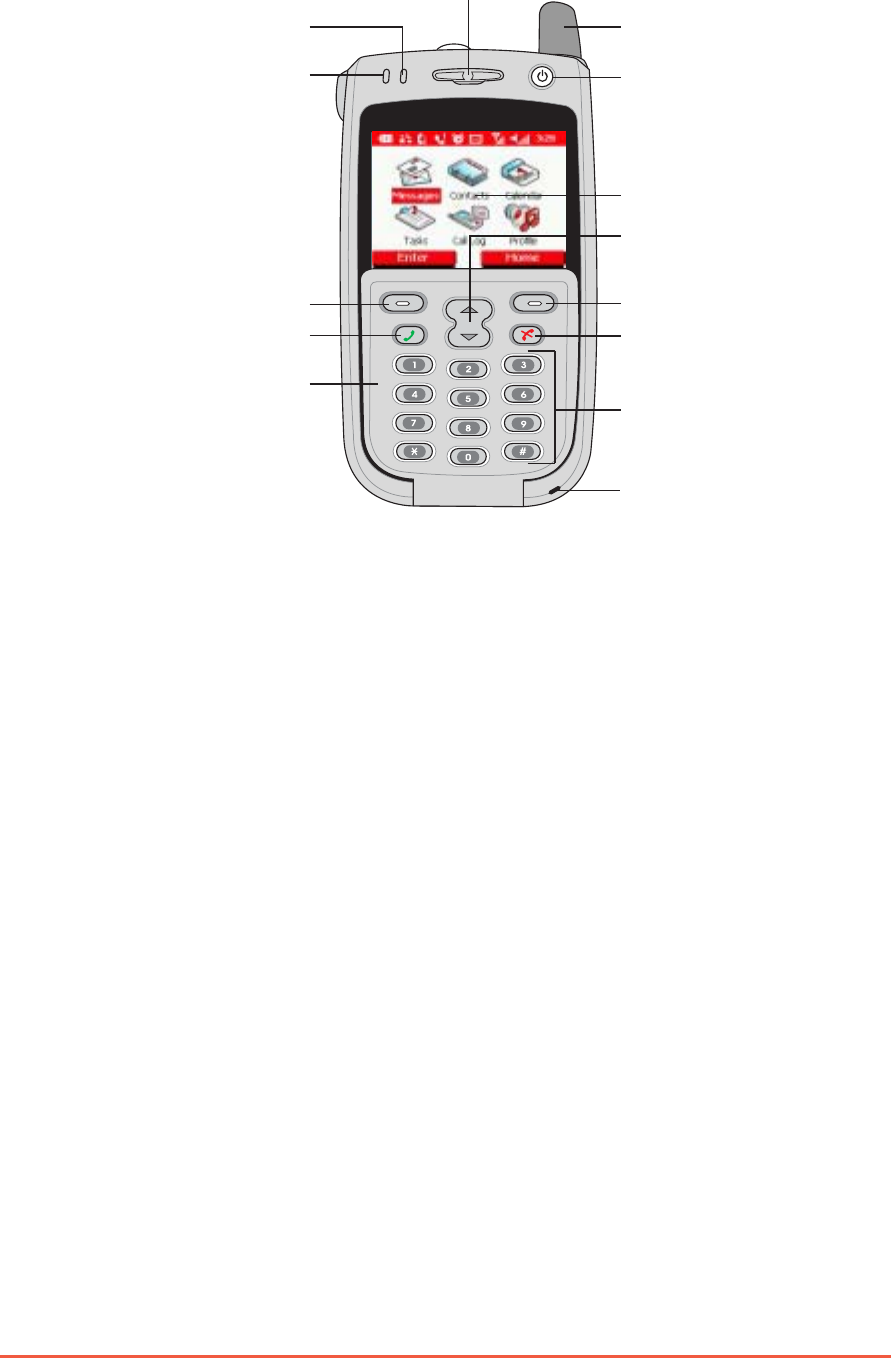
1-4
P505 Pocket PC
•GSM/GPRS LED GSM/GPRS LED
GSM/GPRS LED GSM/GPRS LED
GSM/GPRS LED - blinks red when the phone and GPRS functions
are on. See the LED indications table on the next page for details.
•Bluetooth LED Bluetooth LED
Bluetooth LED Bluetooth LED
Bluetooth LED - blinks blue when the Bluetooth™ feature is on.
See the LED indications table on the next page for details.
•EarpieceEarpiece
EarpieceEarpiece
Earpiece - allows you to listen to incoming calls.
•AntennaAntenna
AntennaAntenna
Antenn a - allows the device to obtain signals.
•Power button and power LED Power button and power LED
Power button and power LED Power button and power LED
Power button and power LED - press this button to turn on
or off the device. This button lights up red when the battery is
charging and turns green when the battery is fully-charged.
•LCD touch screenLCD touch screen
LCD touch screenLCD touch screen
LCD touch screen - allows you to enter, read, send, receive, or
edit data by tapping on it. The screen lumination is increased or
decreased by changing the backlight settings.
•Soft-key (right) Soft-key (right)
Soft-key (right) Soft-key (right)
Soft-key (right) - displays the phonebook when in idle mode;
performs various functions depending on the menu level and
screen display.
•End key End key
End key End key
End key - ends a call.
•Alphanumeric keys Alphanumeric keys
Alphanumeric keys Alphanumeric keys
Alphanumeric keys - enters numbers and alphanumeric characters.
•MicrophoneMicrophone
MicrophoneMicrophone
Microphone - used for speakerphone function and to enhance
sound recordings
•Flip cover Flip cover
Flip cover Flip cover
Flip cover - contains all phone keys for the Pocket PC phone function.
•Call key Call key
Call key Call key
Call key - calls a number; answers a call; displays dialled numbers.
•Soft-key (left) Soft-key (left)
Soft-key (left) Soft-key (left)
Soft-key (left) - launches the phone menu; enters a phone menu.
Front features (flip closed)Front features (flip closed)
Front features (flip closed)Front features (flip closed)
Front features (flip closed)
LCD touch screen
Call key
Flip cover
Power button/Power LED
Antenna
GSM/GPRS LED
Bluetooth LED
Navigation keys
Soft key (right)
End key
Soft key (left)
Earpiece
Alphanumeric keys
Microphone
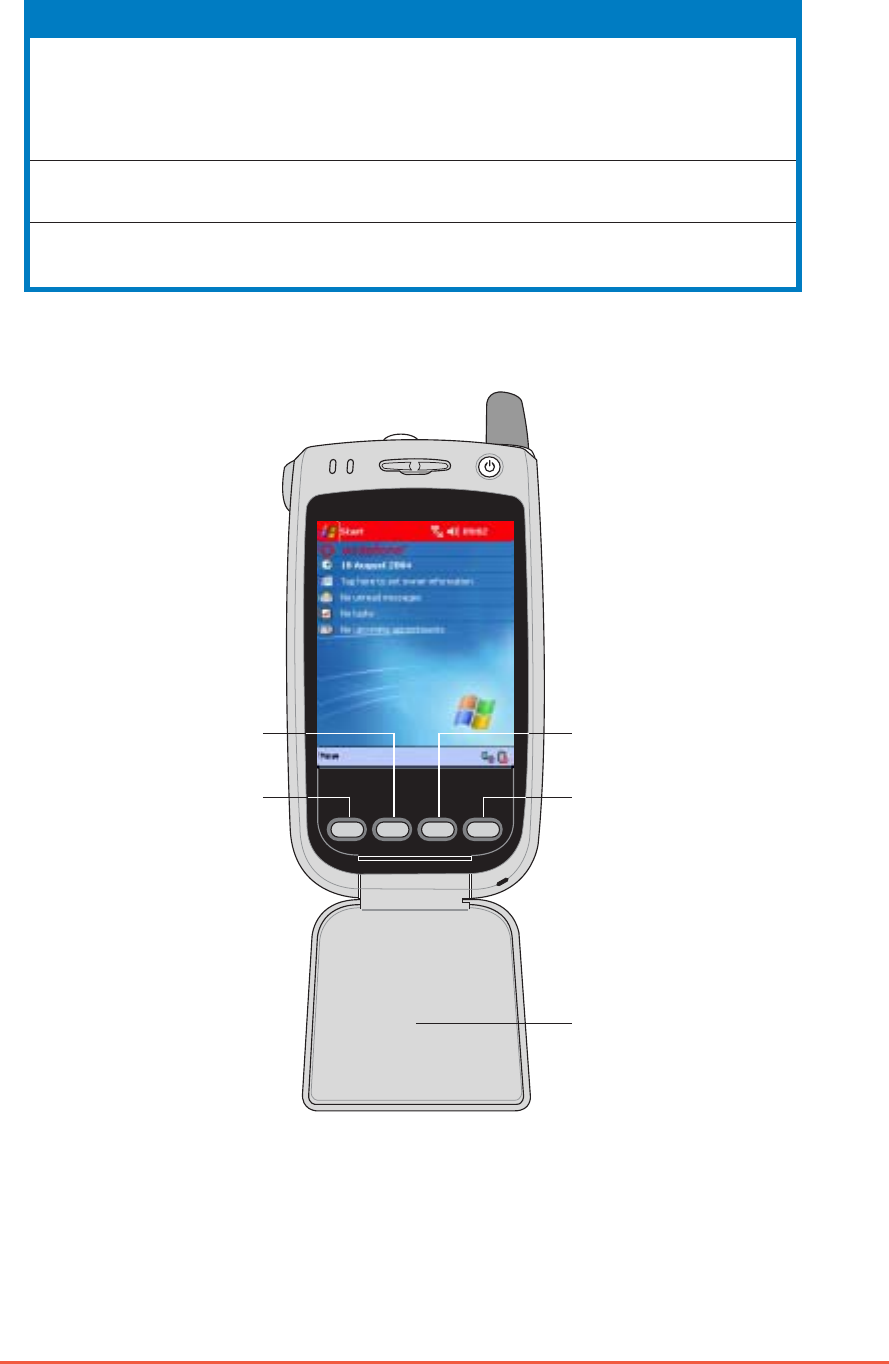
Chapter 1: Getting Started
1-5
•Call buttonCall button
Call buttonCall button
Call button - launches the Phone application.
•Calendar buttonCalendar button
Calendar buttonCalendar button
Calendar button - launches the Calendar application.
•Contacts buttonContacts button
Contacts buttonContacts button
Contacts button - launches the Contacts application.
•End button End button
End button End button
End button - ends a call or closes the Phone application.
Front features (flip open)Front features (flip open)
Front features (flip open)Front features (flip open)
Front features (flip open)
Contacts button
Calendar button
End button
Call button
Phone flip
LED indications tableLED indications table
LED indications tableLED indications table
LED indications table
LEDLED
LEDLED
LED ColorColor
ColorColor
Color StatusStatus
StatusStatus
Status Indicates that the deviceIndicates that the device
Indicates that the deviceIndicates that the device
Indicates that the device
GSM/GPRS Green Blinking is connected to a GSM network
Orange Blinking is connected to a GPRS network
Red Blinking received a new SMS message or is reminding
you of an appointment, task, etc.
Bluetooth Blue Blinking Bluetooth™ feature is on
Red Blinking OS has generated an alarm
Power Red On battery is charging
Green On battery is fully-charged
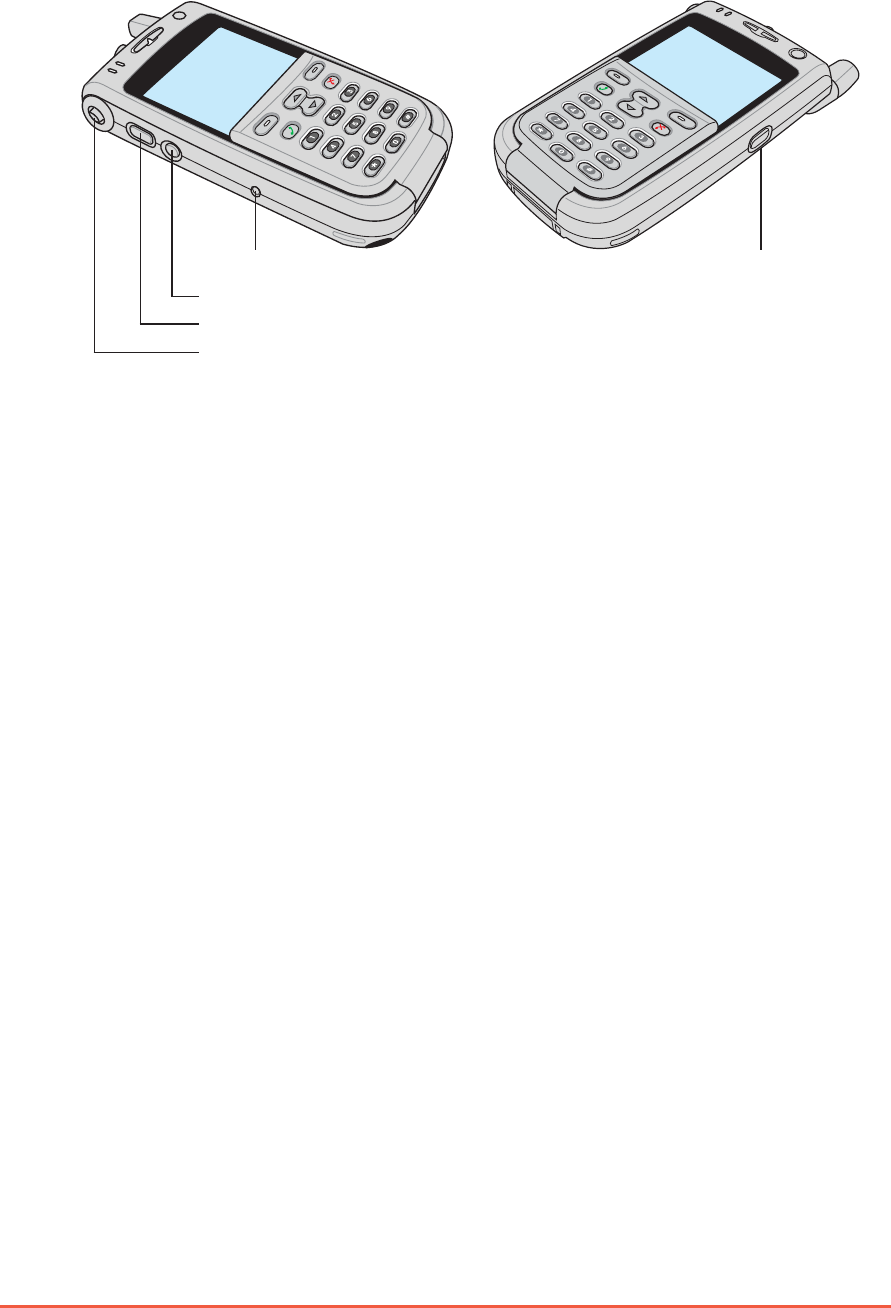
1-6
P505 Pocket PC
Side featuresSide features
Side featuresSide features
Side features
•Reset button Reset button
Reset button Reset button
Reset button - allows you to perform a soft reset in case the
device malfunctions, or when an application hangs. Press the tip of
the stylus on the button to reset the device.
•Record button Record button
Record button Record button
Record button - launches the Notes recorder application.
•Camera button Camera button
Camera button Camera button
Camera button - launches the Camera application; captures a
photo or records video.
•5-way joystick 5-way joystick
5-way joystick 5-way joystick
5-way joystick - functions like the four arrow keys and the
Enter key on a keyboard. This button allows you to:
- move through the program icons, folders, or files in a menu by
scrolling up, down, right, or left
- launch a selected program, list folder contents, or open a file
by pressing the button
•Voice command button Voice command button
Voice command button Voice command button
Voice command button - launches the Voice Commander
application.
Left sideLeft side
Left sideLeft side
Left side Right sideRight side
Right sideRight side
Right side
Voice command button
5-way joystick
Camera button
Record button
Reset button
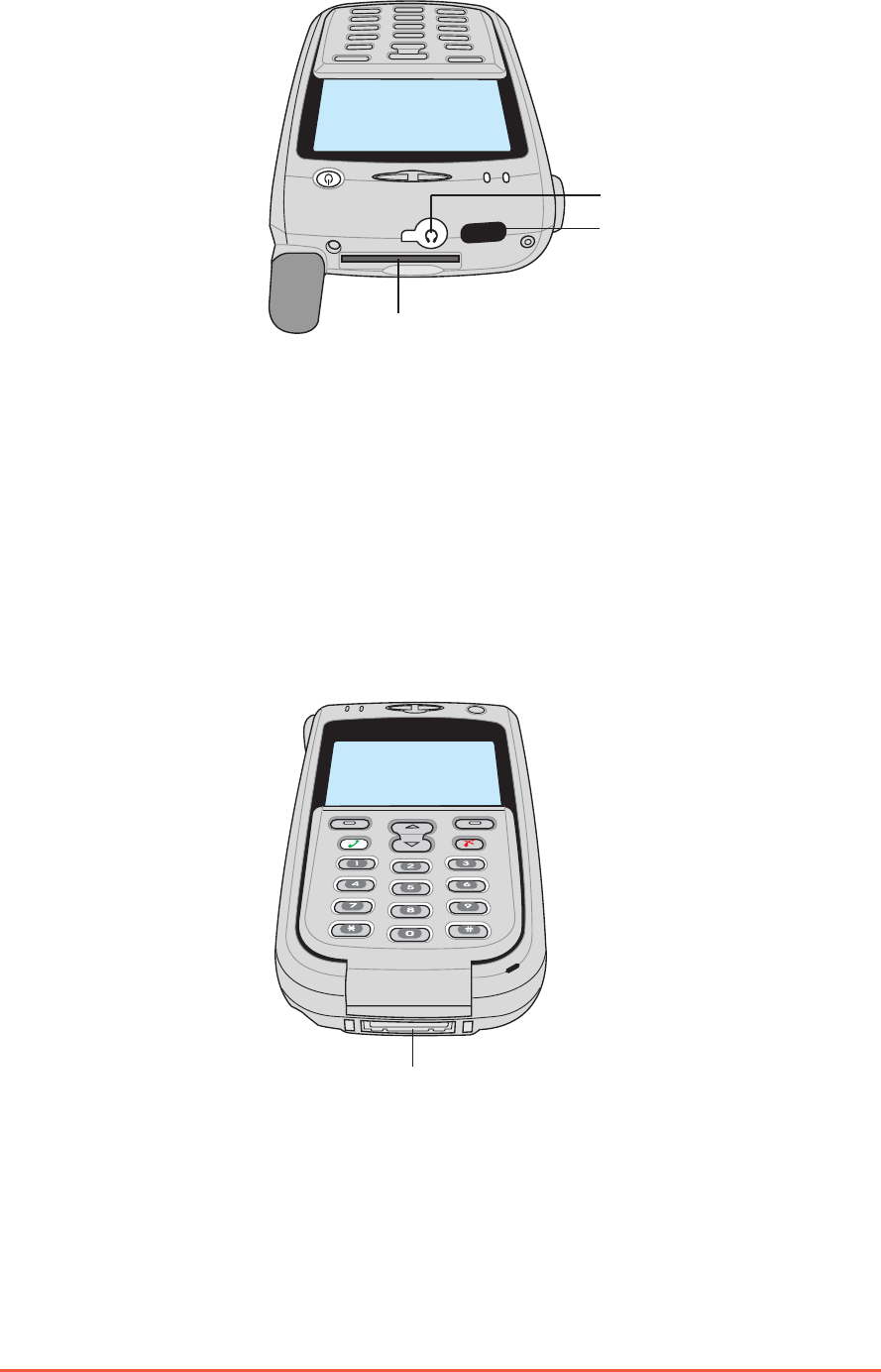
Chapter 1: Getting Started
1-7
•Headphone port Headphone port
Headphone port Headphone port
Headphone port - connects to a headphone.
•Infrared (IR) port Infrared (IR) port
Infrared (IR) port Infrared (IR) port
Infrared (IR) port - allows you to beam data to another device
that has an IR port.
•SD card slot SD card slot
SD card slot SD card slot
SD card slot - accommodates an SD card.
Infrared (IR) port
SD card slot
Headphone port
Power and cradle/sync cable connector
Top featuresTop features
Top featuresTop features
Top features
•Power and cradle/sync cable connector Power and cradle/sync cable connector
Power and cradle/sync cable connector Power and cradle/sync cable connector
Power and cradle/sync cable connector - connects to the
26-pin female connector on the cradle. If you are not using the
cradle, connect the 26-pin power/USB sync cable plug directly to
this connector to synchronise your device with your computer
and/or to charge the battery.
Bottom featuresBottom features
Bottom featuresBottom features
Bottom features
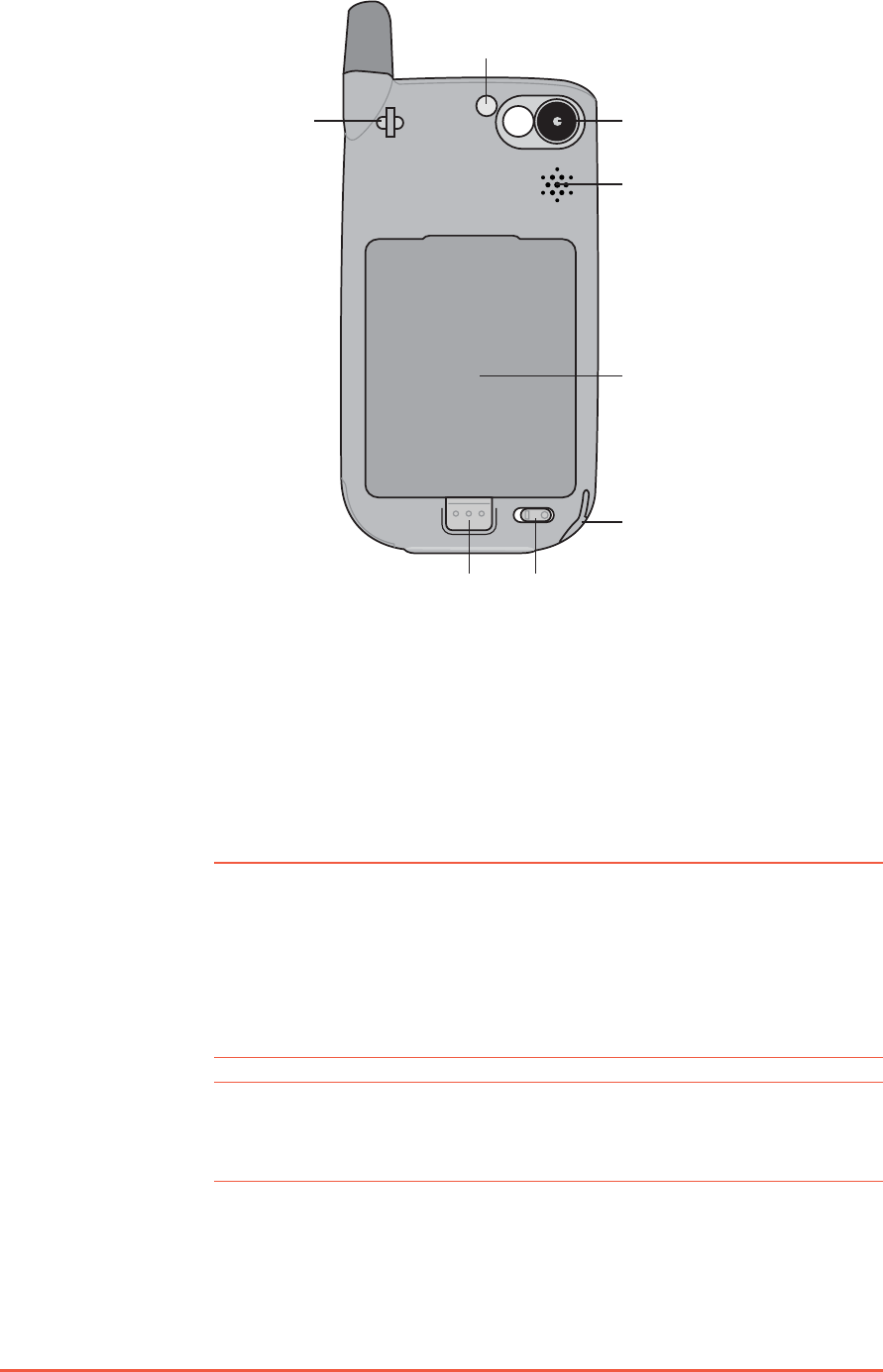
1-8
P505 Pocket PC
Back featuresBack features
Back featuresBack features
Back features
Flash
Speaker
Camera
Battery
Stylus
Strap holder
Battery lockBattery latch
•FlashFlash
FlashFlash
Fl ash - provides additional lighting for the built-in camera
•CameraCamera
CameraCamera
Camera - this is a 1.3 megapixel still/video camera
•BatteryBattery
BatteryBattery
Battery - this is a Lithium-Ion battery
•StylusStylus
StylusStylus
Stylus - used for tapping or writing on the LCD screen
•Battery lock Battery lock
Battery lock Battery lock
Battery lock - locks or unlocks the battery latch
NOTESNOTES
NOTESNOTES
N O T E S • The power button is automatically disabled when the
battery is unlocked. The device automatically turns on
when you install and lock the battery.
• The P505 comes with an internal battery that allows you
to swap a fully-charged and a used battery within thirty
minutes without losing any data.
CAUTION!CAUTION!
CAUTION!CAUTION!
C A U T I O N ! If the Pocket PC is on, unlocking the battery automatically
turns off the device and you lose all unsaved data. Refer to
page 2-31 for details on how to back-up your data.
•Battery latch Battery latch
Battery latch Battery latch
Battery latch - secures the battery on the bay
•Strap holder Strap holder
Strap holder Strap holder
Strap holder - allows you to carry the device on a strap
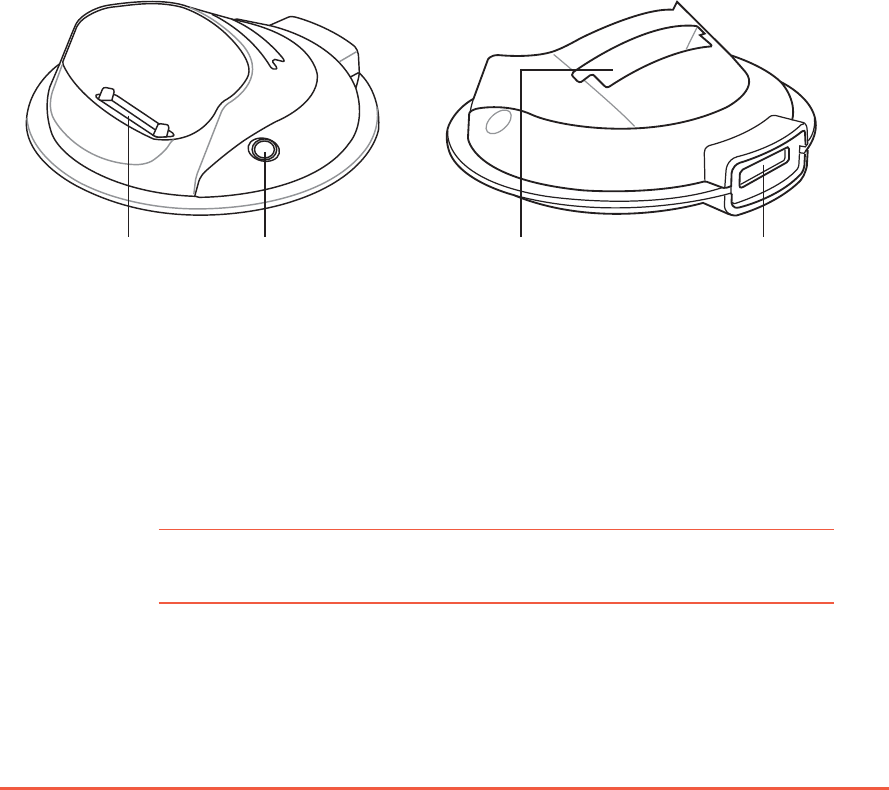
Chapter 1: Getting Started
1-9
The stylusThe stylus
The stylusThe stylus
The stylus
The stylus functions on the P505 the same way a mouse functions
on a standard PC. Use the stylus to open programs, execute
commands, or to enter information by writing on the screen or by
tapping on the on-screen keyboard.
•Tap.Tap.
Tap.Tap.
Ta p . Touch the screen once with the stylus to open programs
and select options.
•Drag.Drag.
Drag.Drag.
Dr a g. Hold the stylus on the screen and drag across the screen
to select text and images. Drag in a list to select multiple items.
•Tap and hold.Tap and hold.
Tap and hold.Tap and hold.
Tap and hold. Tap and hold the stylus on an item to see a list of
actions available for that item. On the displayed pop-up menu, tap
the action that you want to perform.
Device connector Stylus bay Extra battery pack bay Power/USB sync
cable connector
FrontFront
FrontFront
Front BackBack
BackBack
Back
The cradleThe cradle
The cradleThe cradle
The cradle
The cradle has three connectors.
•Device connectorDevice connector
Device connectorDevice connector
Device connector - holds the device in place. This is a 26-pin
connector that matches the connector on the bottom of the device.
•USB connector USB connector
USB connector USB connector
USB connector - synchronises the device with your PC.
NOTENOTE
NOTENOTE
N O T E The Power/USB sync cable connector is not detachable from
the back of the cradle.
•Power connector Power connector
Power connector Power connector
Power connector - connects the AC adapter. This connector is
located at the back side of the cradle.
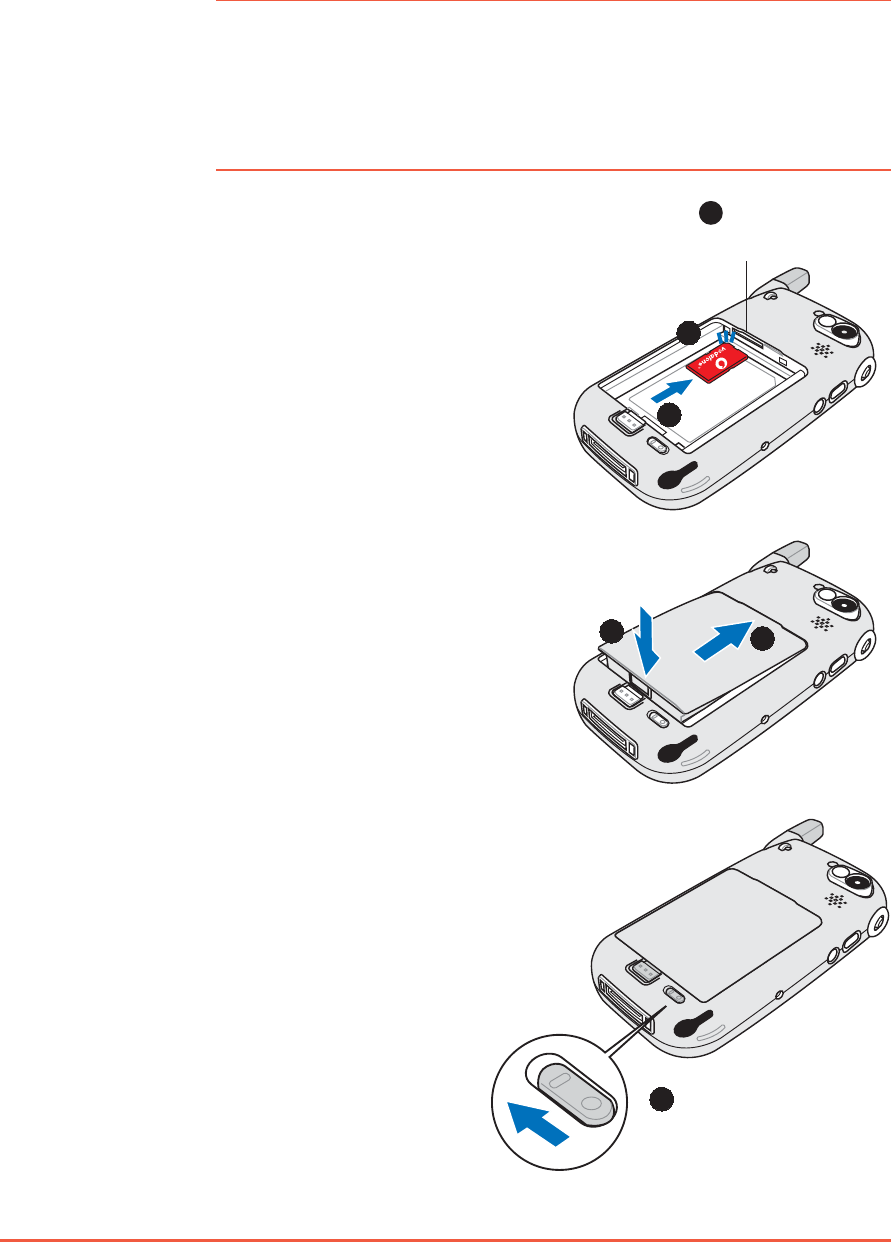
1-10
P505 Pocket PC
Setting up P505Setting up P505
Setting up P505Setting up P505
Setting up P505
Installing a SIM card and batteryInstalling a SIM card and battery
Installing a SIM card and batteryInstalling a SIM card and battery
Installing a SIM card and battery
To operate the Pocket PC phone features you must install a
Subscriber Identification Module (SIM) card.
NOTENOTE
NOTENOTE
N O T E • Your operator will provide a SIM for the device or provision
an existing SIM for use, subject to your contract with the
operator.
• The battery comes uninstalled in the P505 box. Install the
SIM card first before installing the battery.
To install a SIM card and the battery:
1. Locate the SIM card slot.
2. Position the SIM card with its
nicked corner on top and its
contacts face down.
3. Insert the SIM card to the slot
until it clicks in place.
4. Install the battery by
matching the battery hooks
to the holes on the
compartment.
5. Slide the battery into the
compartment, then press to
keep it in place. See the
illustration for reference.
6. Use the stylus to move the
battery lock to the left to
secure the battery.
SIM card slot
11
11
1
22
22
2
33
33
3
44
44
4
55
55
5
66
66
6
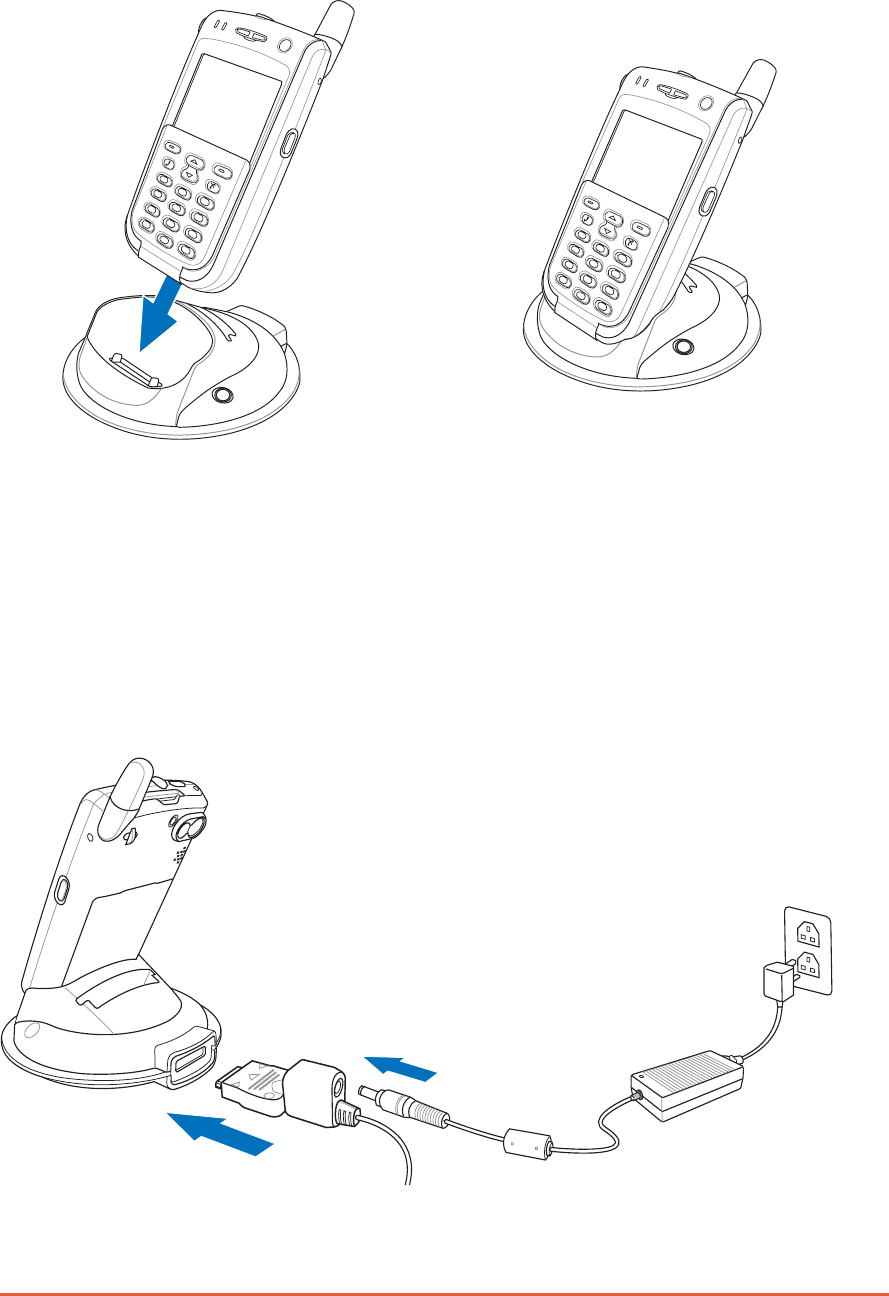
Chapter 1: Getting Started
1-11
Placing on the cradlePlacing on the cradle
Placing on the cradlePlacing on the cradle
Placing on the cradle
Position the device on the cradle as shown. Match the connectors and
carefully insert the device until it fits in place.
Connecting the AC adapterConnecting the AC adapter
Connecting the AC adapterConnecting the AC adapter
Connecting the AC adapter
• Connect the power/USB sync cable to the connector at the back
of the cradle. Connect the power plug to a grounded wall socket.
See Figure 1.
1
23
4
7
*
8
0
9
#
56
1
23
4
7
*
8
0
9
#
56
Figure 1
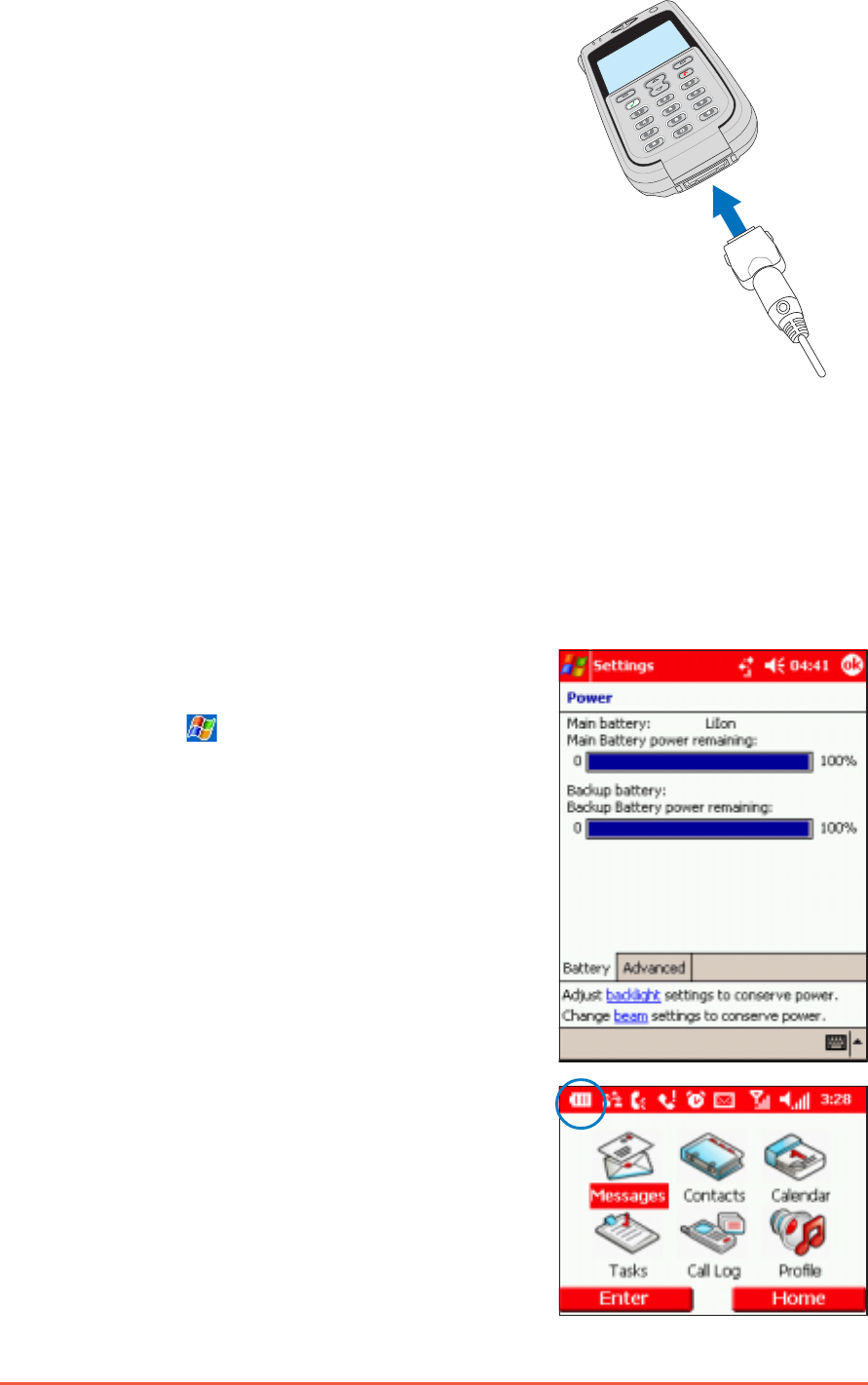
1-12
P505 Pocket PC
• If you are not using the cradle,
connect the power/USB sync cable
plug directly to the power
connector at the bottom of the
device. Connect the other end of
the power/USB sync cable to a
grounded wall socket. See Figure 2.
Charging the batteryCharging the battery
Charging the batteryCharging the battery
Charging the battery
The device includes a rechargeable Lithium Ion battery. You must
charge the battery before using the device the first time. The battery
starts charging as soon as you connect the AC adapter to a power
source. Use the AC adapter to plug your device to a power source
whenever possible, especially when you are using a modem or other
peripherals, using the device backlight, connecting to a PC, or letting
notification light flash for extended time periods.
When the device is on and the flip is
open, you can display the power status
by tapping >>
>>
>, SettingsSettings
SettingsSettings
Settings > System> System
> System> System
> System
tab, and the PowerPower
PowerPower
Power icon.
Figure 2
When the device is on and the flip is
closed, a battery icon appears in the top
left corner of the phone interface
indicating the battery power level.
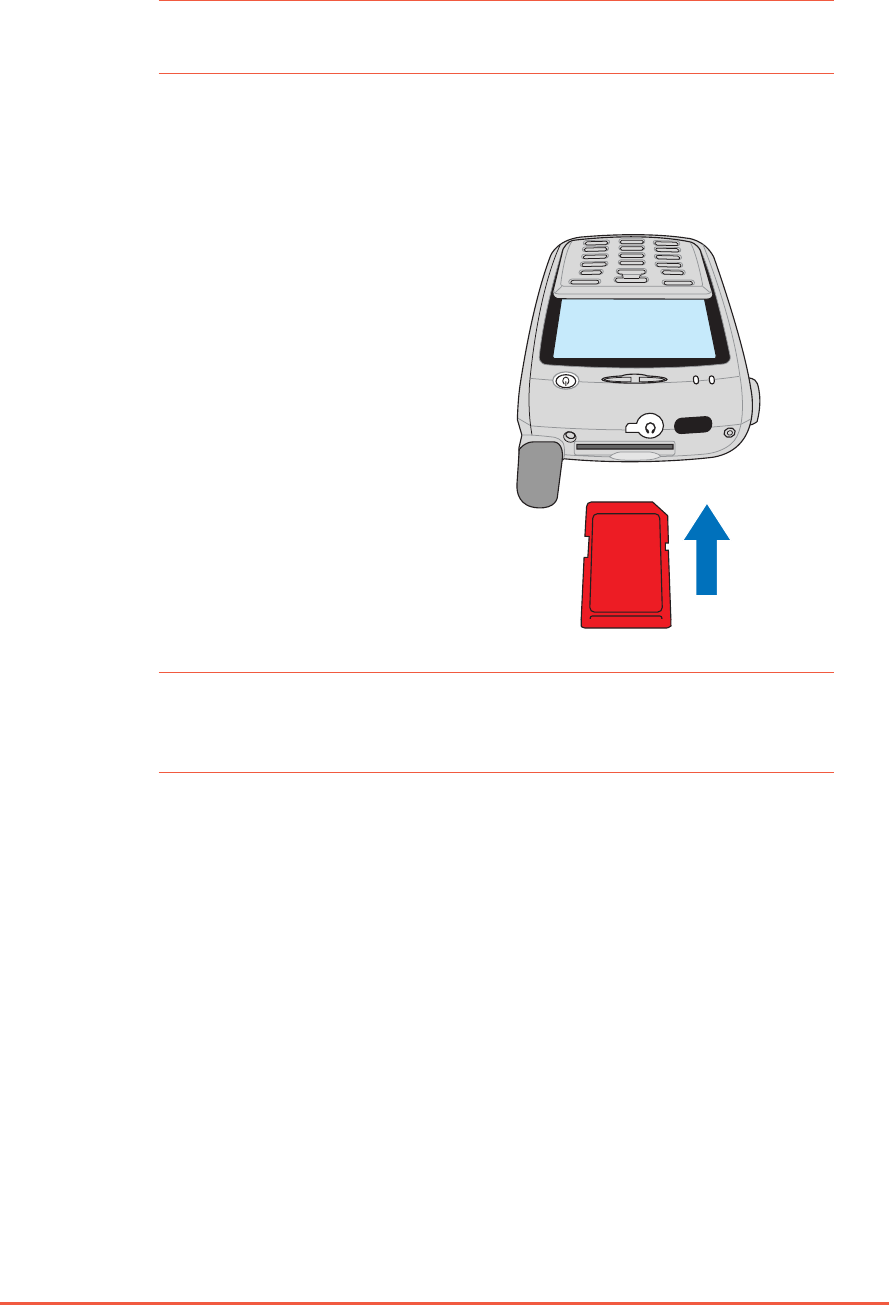
Chapter 1: Getting Started
1-13
Additional storageAdditional storage
Additional storageAdditional storage
Additional storage
Your device comes with a SecureDigital™ memory card slot for
additional storage or network card installation.
NOTENOTE
NOTENOTE
N O T E Install an SD card if you wish to use the Smart Keeper backup
application.
Installing and removing an SD cardInstalling and removing an SD card
Installing and removing an SD cardInstalling and removing an SD card
Installing and removing an SD card
To install an SD card:To install an SD card:
To install an SD card:To install an SD card:
To install an SD card:
1. With the label side (usually the
side with the card
manufacturer’s name) face up,
and the bar code/serial number
side face down, insert the card
into the SD slot.
2. Push the card all the way into the slot until it fits completely. If
properly installed, the SD card edge aligns with the top edge of
the device.
To remove an SD card:To remove an SD card:
To remove an SD card:To remove an SD card:
To remove an SD card:
Press the card slightly until it ejects.
CAUTION!CAUTION!
CAUTION!CAUTION!
C A U T I O N ! An SD card fits only in one orientation, and slides smoothly into
the slot if inserted correctly. DO NOT force the SD card into
the slot!
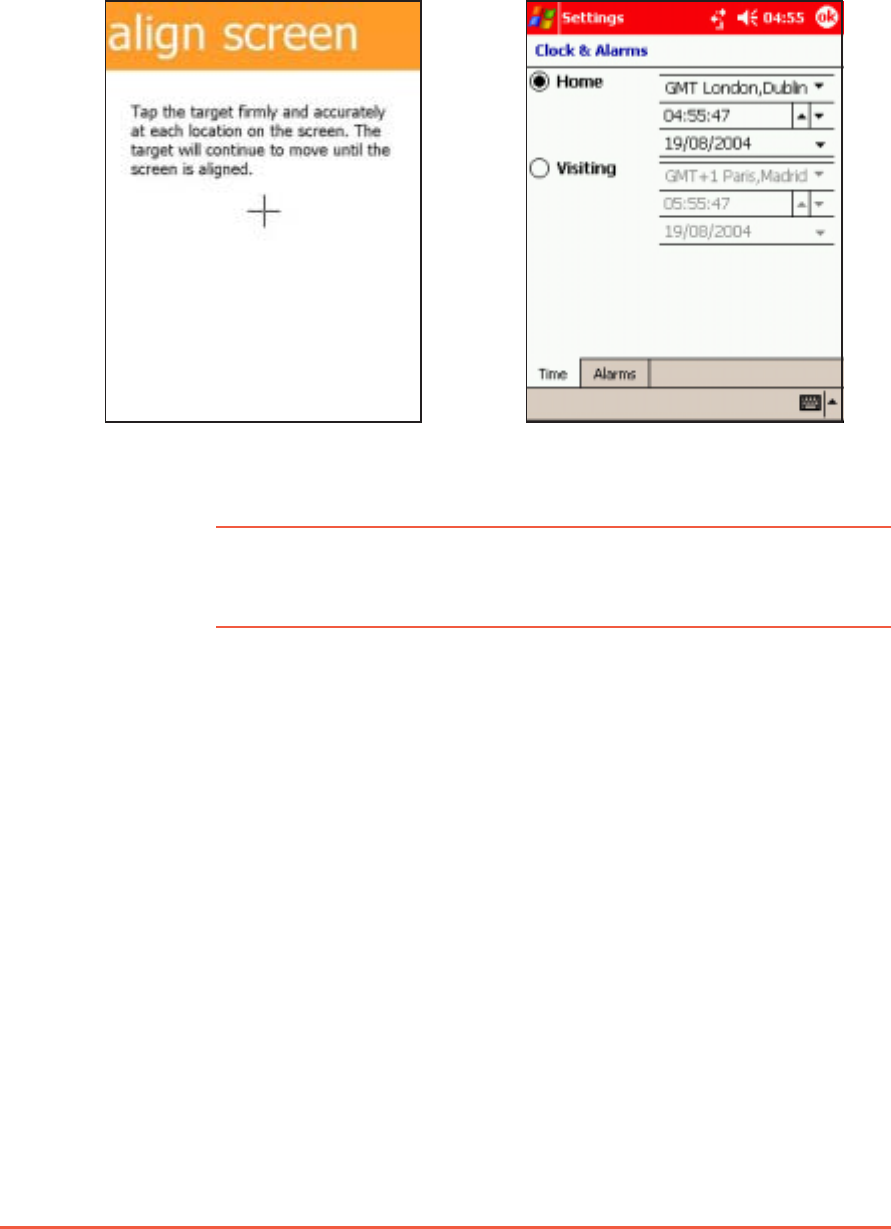
1-14
P505 Pocket PC
Activating the Pocket PCActivating the Pocket PC
Activating the Pocket PCActivating the Pocket PC
Activating the Pocket PC
Press the power button to turn on the device, then open the phone
flip. The first time you start or reset the device, the screen prompts
you to re-calibrate and set the local time zone. Follow onscreen
instructions to proceed.
NOTENOTE
NOTENOTE
N O T E It is important that you properly calibrate and activate your
device before using it. This process ensures accurate
positioning when entering text and selecting menus.
Screen alignment Setting the local
time zone

Chapter 2
Learning the Basics
This chapter teaches you the
basic Pocket PC functions. You
will learn how to enter text, find
and organise information,
customise the device, and know
the bundled utilities.

2-2
P505 Pocket PC
Chapter summaryChapter summary
Chapter summaryChapter summary
Chapter summary
Basic Pocket PC screensBasic Pocket PC screens
Basic Pocket PC screensBasic Pocket PC screens
Basic Pocket PC screens ..........................................................................
..........................................................................
..................................... 2-32-3
2-32-3
2-3
Today screen ................................................................... 2-3
Start menu ...................................................................... 2-4
New ................................................................................. 2-4
Vodafone menu ............................................................... 2-5
Command bar .................................................................. 2-5
Pop-up menus .................................................................. 2-6
Entering informationEntering information
Entering informationEntering information
Entering information ....................................................................................
....................................................................................
.......................................... 2-72-7
2-72-7
2-7
Entering text using the Input Panel .................................. 2-7
Writing on the screen .................................................... 2-11
Drawing on the screen ................................................... 2-14
Recording a message ..................................................... 2-15
Using a preset message ................................................. 2-17
Finding and organizing informationFinding and organizing information
Finding and organizing informationFinding and organizing information
Finding and organizing information............................................
............................................
......................2-182-18
2-182-18
2-18
Using Find ...................................................................... 2-18
Using Help ...................................................................... 2-19
Using the File Explorer ................................................... 2-19
Customizing your deviceCustomizing your device
Customizing your deviceCustomizing your device
Customizing your device ........................................................................
........................................................................
....................................2-202-20
2-202-20
2-20
Adjusting settings ......................................................... 2-20
Changing system settings .............................................. 2-21
Customizing personal settings ....................................... 2-30
Backing up your dataBacking up your data
Backing up your dataBacking up your data
Backing up your data..................................................................................
..................................................................................
.........................................2-312-31
2-312-31
2-31
Bundled programsBundled programs
Bundled programsBundled programs
Bundled programs ..........................................................................................
..........................................................................................
.............................................2-372-37
2-372-37
2-37
Games ........................................................................... 2-37
Calculator ...................................................................... 2-37
Camera .......................................................................... 2-38
File Explorer ................................................................... 2-38
Conference .................................................................... 2-38
Find ............................................................................... 2-38
MIDlet Manager .............................................................. 2-39
Multimedia Album .......................................................... 2-39
MSN Messenger ............................................................. 2-39
Photo Contacts .............................................................. 2-40
Pocket Excel .................................................................. 2-40
Pictures ......................................................................... 2-40
Pocket MSN ................................................................... 2-40
Pocket Word .................................................................. 2-41
STK ................................................................................ 2-41
Terminal Services ........................................................... 2-41
Voice Recognition .......................................................... 2-42
Windows Media .............................................................. 2-42
Adding or removing programsAdding or removing programs
Adding or removing programsAdding or removing programs
Adding or removing programs ..........................................................
..........................................................
.............................2-432-43
2-432-43
2-43
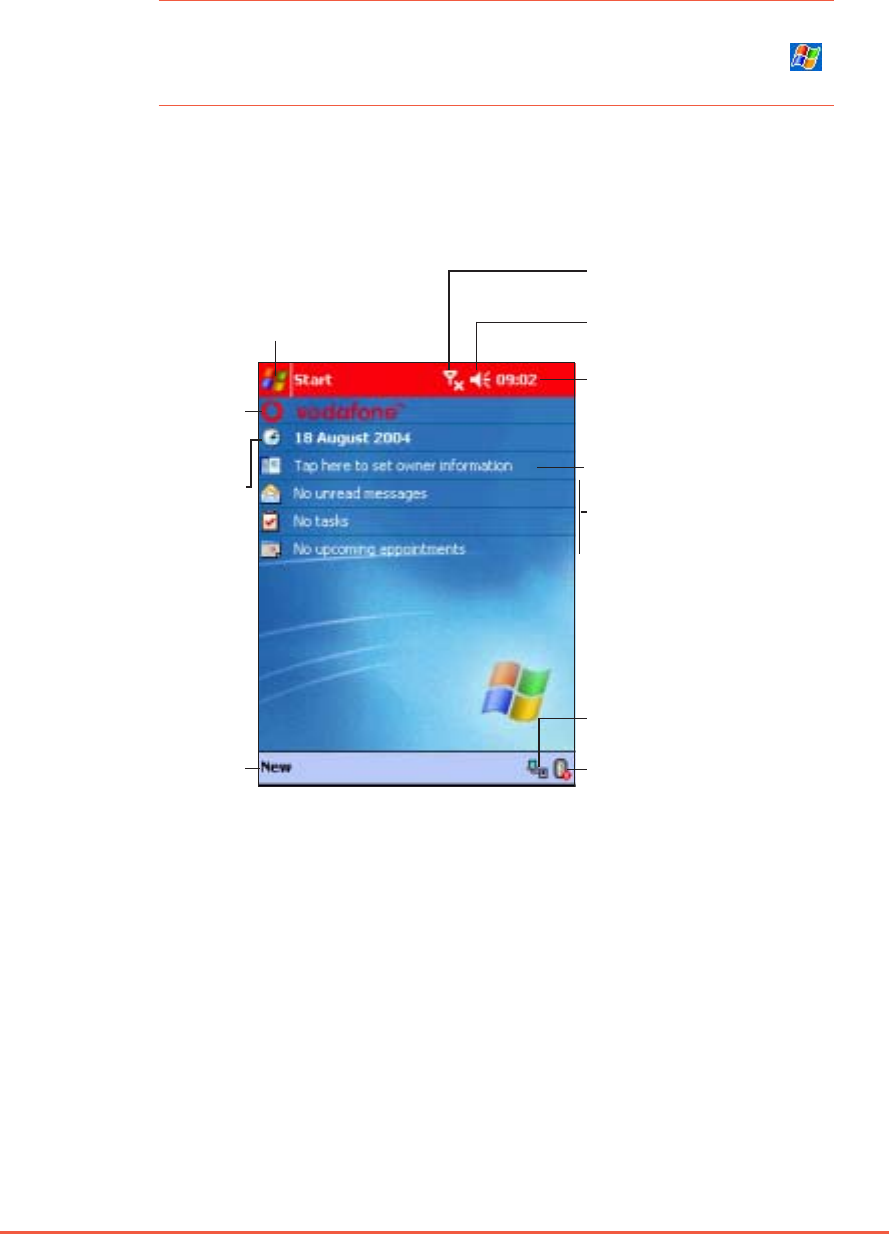
Chapter 2: Learning the Basics
2-3
Basic Pocket PC screensBasic Pocket PC screens
Basic Pocket PC screensBasic Pocket PC screens
Basic Pocket PC screens
Today screenToday screen
Today screenToday screen
Today screen
Normally, the TodayToday
TodayToday
Today screen appears when you turn on your device
and open the phone flip for the first time each day.
NOTENOTE
NOTENOTE
N O T E When the device is already on and the screen displays another
program, you can display the TodayToday
TodayToday
T o d a y screen by tapping the
icon, then tap TodayToday
TodayToday
T o d a y from the menu.
As shown in the capture below, the TodayToday
TodayToday
Today screen lets you see at a
glance the summary of the important information for the day.
From the TodayToday
TodayToday
Today screen, tap any of the listed items with the stylus
to display the details.
The following sections explain how to use the Vodafone Menu, modify
the current tasks or activities, add new items or information, set the
time and owner information, or read e-mail/MMS/SMS messages.
Tap to switch to a program
Tap to set up or change
the network settings
Tap to change the volume
or mute all sounds
Tap to display the date,
time, and your next
appointment
Your day at a glance
Tap to create a new item
Tap to change the date
and time
Tap to set owner information
Tap to display the
Bluetooth™ menu
Tap to display
synchronization status*
Tap to launch the
Vodafone menu
* The device must be in the cradle or connected to the computer via the USB cable to display
this icon.
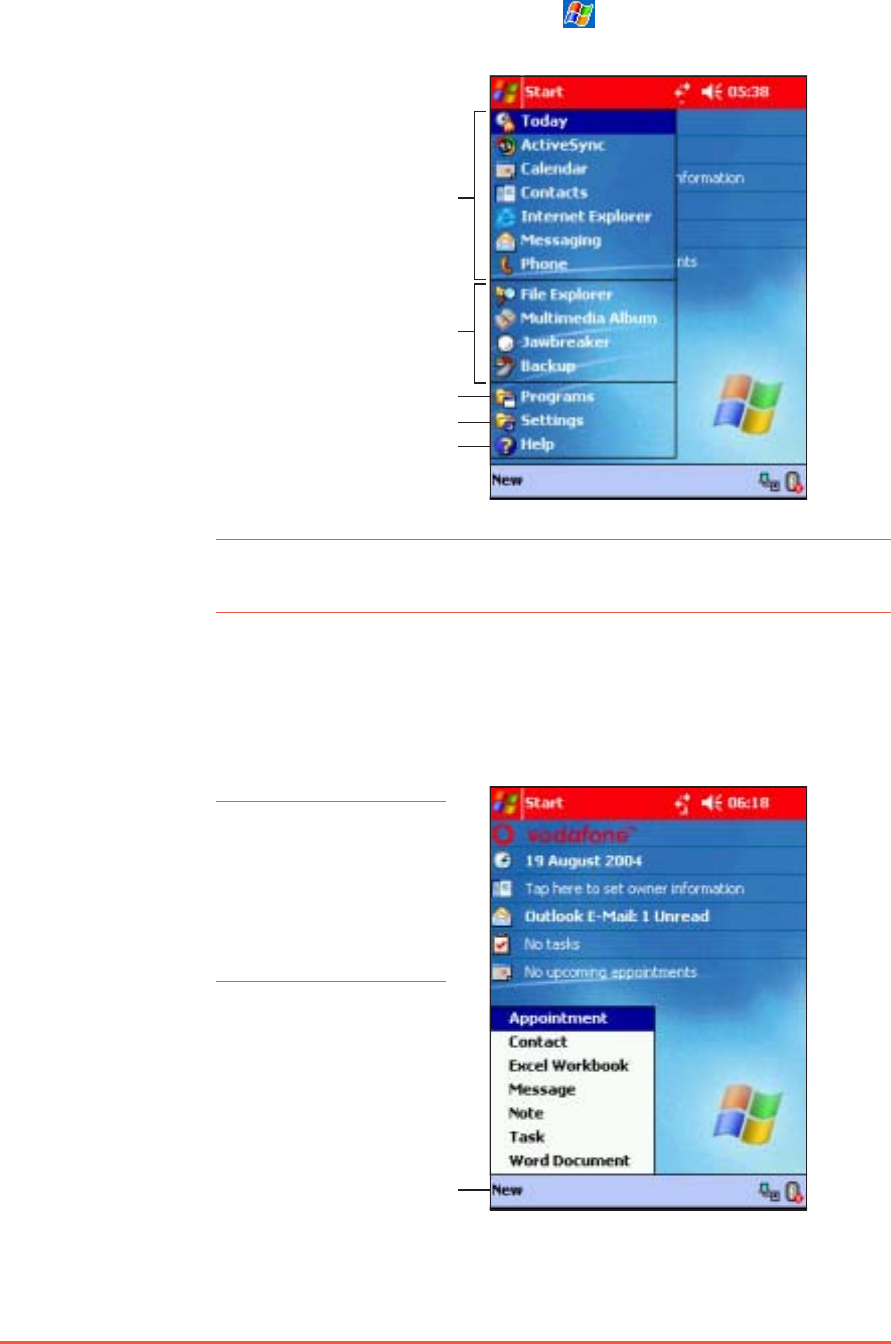
2-4
P505 Pocket PC
Start menuStart menu
Start menuStart menu
Start menu
From the Start menu, you can select programs, settings, and Help
topics. To display the Start menu, tap the icon from the top of
the screen.
NOTENOTE
NOTENOTE
N O T E You can add or remove programs from the Start Menu using
the MenusMenus
MenusMenus
M e n u s option in SettingsSettings
SettingsSettings
Settings > Personal Personal
Personal Personal
Personal folder.
NewNew
NewNew
New
Tap NewNew
NewNew
N e w at the bottom left corner of the screen to display a list of
programs and tasks you can select from.
NOTENOTE
NOTENOTE
N O T E You can customise
the contents of the
NewNew
NewNew
N e w menu using
the MenusMenus
MenusMenus
M e n u s option
in SettingsSettings
SettingsSettings
Settings >
PersonalPersonal
PersonalPersonal
Personal folder.
Tap to open a recently used program
Tap to open a program
Tap to open the Programs menu
Tap to open the Settings menu
Tap to open the Help menu
Tap to open the a menu
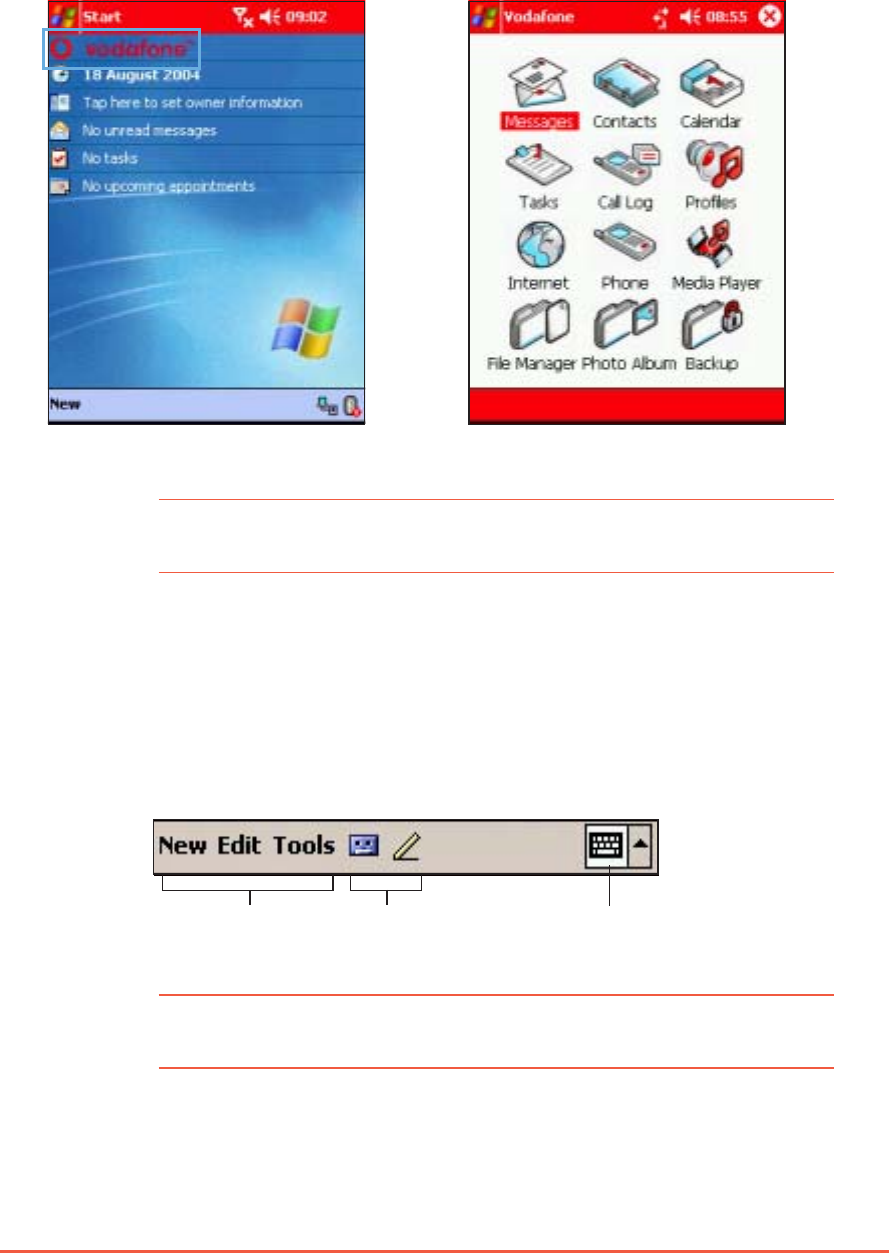
Chapter 2: Learning the Basics
2-5
Vodafone menuVodafone menu
Vodafone menuVodafone menu
Vodafone menu
The Vodafone menu provides quick access to commonly used PDA
and mobile applications. You can launch the Vodafone menu by
tapping the VodafoneVodafone
VodafoneVodafone
Vodafone item in the Today screen.
Tap an icon to launch the application.
NOTENOTE
NOTENOTE
N O T E See page 5-3 for details on how to adjust the Vodafone menu
settings.
Command barCommand bar
Command barCommand bar
Command bar
At the bottom of the screen is the CommandCommand
CommandCommand
Command bar. You can use the
menus and buttons on the CommandCommand
CommandCommand
Comma nd bar to perform certain tasks in
an application.
Tap to select
menu commands
Tap to select
button commands
Tap to display
the input panel
NOTENOTE
NOTENOTE
N O T E The menus and buttons vary depending on the programs you
are using.
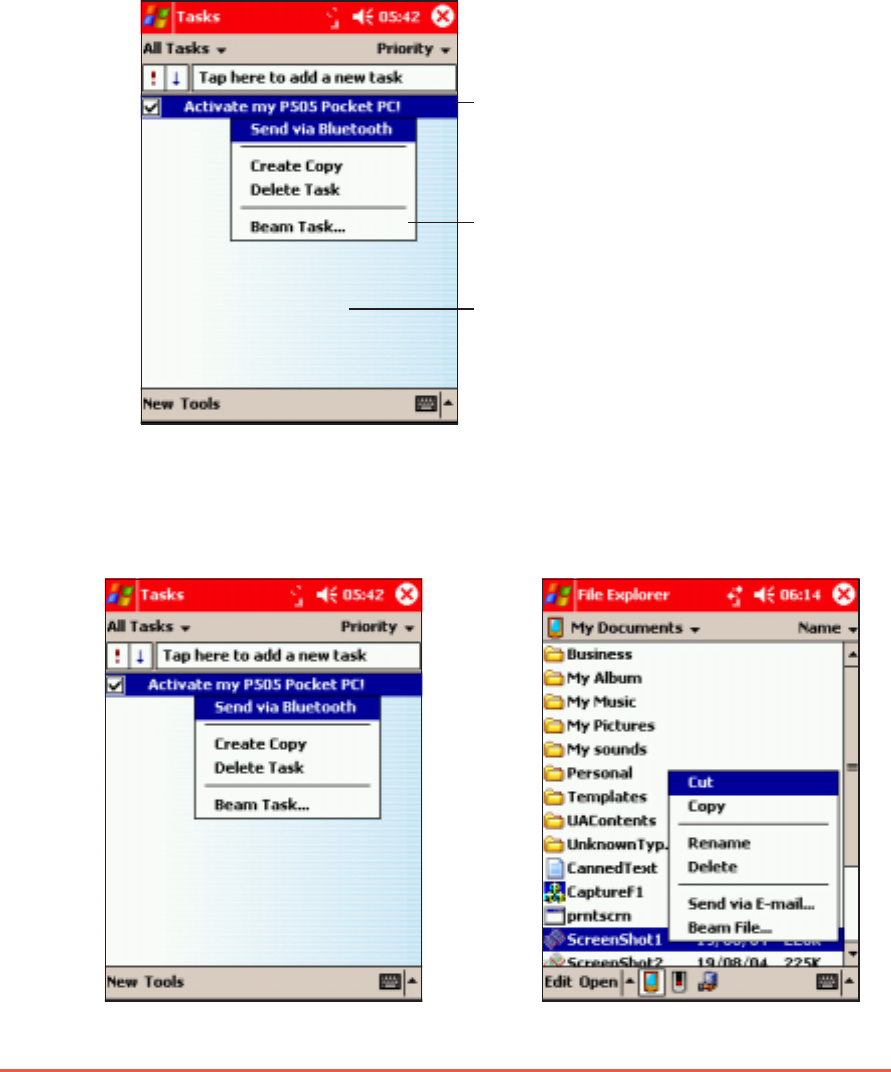
2-6
P505 Pocket PC
The pop-up menu items vary depending on the program or
application. For example, the File ExplorerFile Explorer
File ExplorerFile Explorer
File Explorer pop-up menu includes
more items than in TasksTasks
TasksTasks
Tasks.
Pop-up menusPop-up menus
Pop-up menusPop-up menus
Pop-up menus
Pop-up menus often appear when you tap and hold an item to help
you choose an action. The actions in the pop-up menus vary from
program to program.
To access a pop-up menu, tap and hold the stylus on the item that
you wish to perform action on. When the menu appears, lift the
stylus, and tap the action that you want to execute. To close the
pop-up menu without performing an action, tap anywhere outside the
menu.
Tap and hold until the pop-up menu appears
Tap the action that you wish to perform
Tap outside the pop-up menu to close it
without performing an action
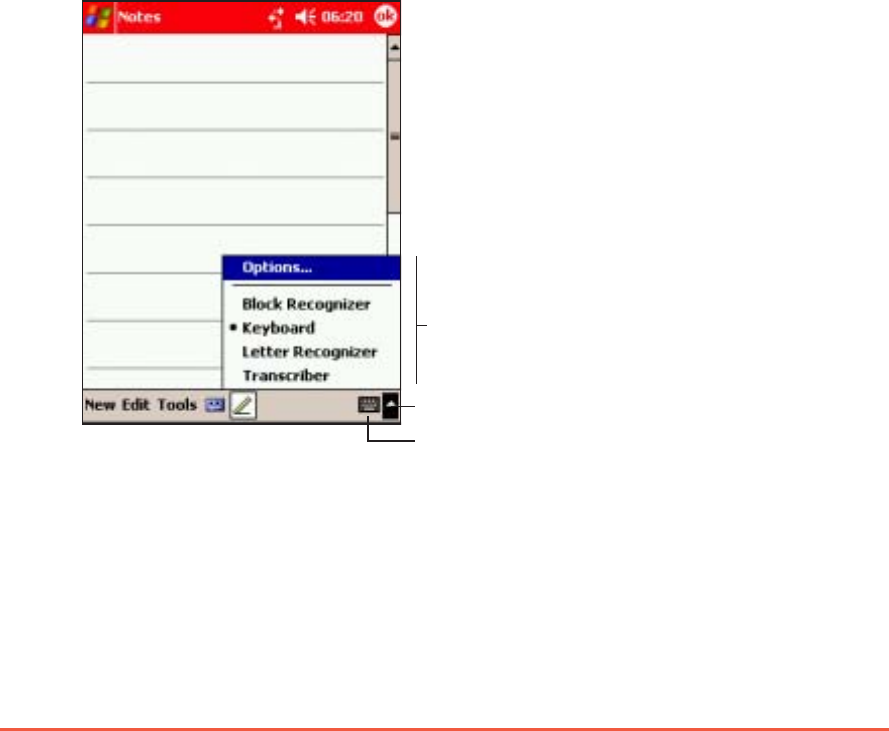
Chapter 2: Learning the Basics
2-7
Entering informationEntering information
Entering informationEntering information
Entering information
You can enter information in your device in any of the following ways.
• Use the input panel to enter text using the on-screen keyboard or
the Letter Recognizer
• Write directly on the screen with the stylus
• Draw pictures on the screen
• Speak into the device microphone to record a message
• Use the Microsoft
®
ActiveSync
®
to synchronize or copy
information from your desktop computer to your device
Entering text using the Input PanelEntering text using the Input Panel
Entering text using the Input PanelEntering text using the Input Panel
Entering text using the Input Panel
Use the Input Panel to enter information in any program on your
device, you can either type using the on-screen KeyboardKeyboard
KeyboardKeyboard
Keyboard or write
using the Letter RecognizerLetter Recognizer
Letter RecognizerLetter Recognizer
Letter Recognizer, Block RecognizerBlock Recognizer
Block RecognizerBlock Recognizer
Block Recognizer, or
TranscriberTranscriber
TranscriberTranscriber
Transcriber. In either case, the characters appear as typed text on
the screen.
To show or hide the input panel, tap the Input Panel Input Panel
Input Panel Input Panel
Input Panel button. Tap
the arrowarrow
arrowarrow
arrow next to the Input Panel button to see your options.
Select an input method
Tap to show or hide the input panel
Tap to display the input method options
Open the NotesNotes
NotesNotes
No tes application to try out the different options for
creating text.
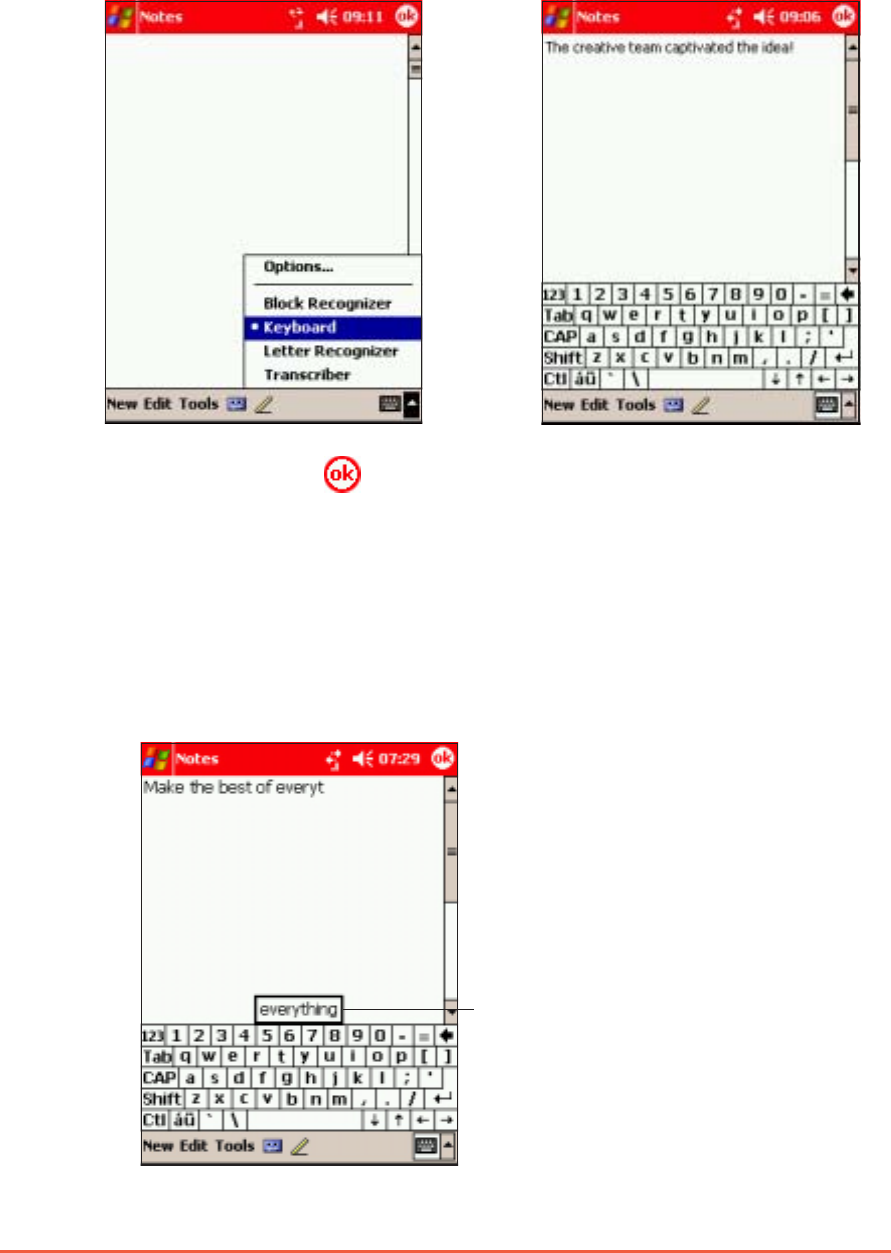
2-8
P505 Pocket PC
When you use the Input Panel and the on-screen keyboard, your
device predicts the word you are typing and displays it above the
Input Panel. When you tap the displayed word, it is inserted into your
text at the insertion point. The more you use your device, the more
words it learns to predict.
Tap here if this is the word you wish to use
To type with the on-screen keyboard:To type with the on-screen keyboard:
To type with the on-screen keyboard:To type with the on-screen keyboard:
To type with the on-screen keyboard:
1. Tap the arrow next to the Input Panel button, then tap KeyboardKeyboard
KeyboardKeyboard
Keyboard.
2. Tap the keys with the stylus to enter information.
3. When finished, tap to save the file.

Chapter 2: Learning the Basics
2-9
To change the settings for word completion:To change the settings for word completion:
To change the settings for word completion:To change the settings for word completion:
To change the settings for word completion:
1. Tap .
2. Tap SettingsSettings
SettingsSettings
Settings.
3. Tap PersonalPersonal
PersonalPersonal
Personal tab.
4. Tap InputInput
InputInput
Input.
5. Tap the Word CompletionWord Completion
Word CompletionWord Completion
Word Completion tab.
6. Make your desired changes.
7. Tap to save your changes.
To use Letter Recognizer:To use Letter Recognizer:
To use Letter Recognizer:To use Letter Recognizer:
To use Letter Recognizer:
With the Letter Recognizer, you can write letters on the screen with
the stylus as you would on paper.
1. Tap the arrow next to the Input Panel button, then tap LetterLetter
LetterLetter
Letter
RecognizerRecognizer
RecognizerRecognizer
Recognizer.
2. Write a letter or a number in the appropriate on-screen area.
When you write a letter, it is converted to a typed text that
appears on the screen. If the device has trouble recognising a
character, tap on the question mark next to the writing area and
follow the on-screen instructions to see how to write that
character.
To use Block Recognizer:To use Block Recognizer:
To use Block Recognizer:To use Block Recognizer:
To use Block Recognizer:
With the Block Recognizer, you can input character strokes that are
similar to those used on other devices.
1. Tap the arrow next to the Input Panel button, then tap BlockBlock
BlockBlock
Block
RecognizerRecognizer
RecognizerRecognizer
Recognizer.
2. Write a letter or a number in the appropriate on-screen area.
When you write a letter, it is converted to a typed text that
appears on the screen. If the device has trouble recognising a
character, tap on the question mark next to the writing area and
follow the on-screen instructions to see how to write that
character.

2-10
P505 Pocket PC
To use Transcriber:To use Transcriber:
To use Transcriber:To use Transcriber:
To use Transcriber:
With Transcriber, you can use the stylus to write anywhere on the
screen as you would on paper. Unlike Letter Recognizer and Block
Recognizer, you can write a sentence or additional information. Pause
after writing and let Transcriber convert the written characters to
typed characters.
1. Tap the arrow next to the Input Panel button, then tap
TranscriberTranscriber
TranscriberTranscriber
Transcriber.
2. Write anywhere on the screen.
For instructions and demonstration on using Transcriber, with
Transcriber open, tap the question markquestion mark
question markquestion mark
question mark in the lower right
corner of the screen.
To edit typed text:To edit typed text:
To edit typed text:To edit typed text:
To edit typed text:
1. Select the text that you wish to edit using either one of the
following:
• drag the stylus over the text
• tap twice to select a word
• tap three times to select a paragraph
2. Tap EditEdit
EditEdit
Ed i t on the Command bar and select an action, or use one of
the tools in the Input Panel.
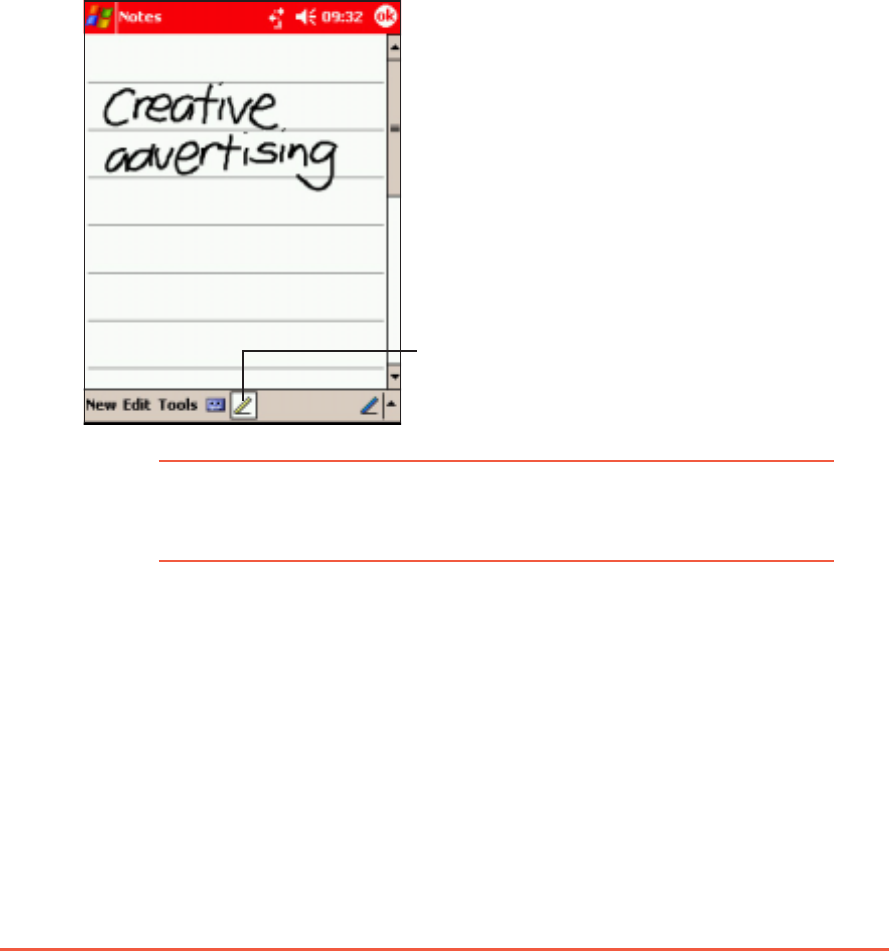
Chapter 2: Learning the Basics
2-11
Writing on the screenWriting on the screen
Writing on the screenWriting on the screen
Writing on the screen
In any application that accepts writing, such as NotesNotes
NotesNotes
Notes, and in the
notes tab in CalendarCalendar
CalendarCalendar
Calendar, ContactsContacts
ContactsContacts
Contacts, and TasksTasks
TasksTasks
Ta sks, you can use the
stylus to write directly on the screen, like writing on a piece of paper.
You can edit and format what you have written and convert the
information to text at a later time.
To write on the screen:To write on the screen:
To write on the screen:To write on the screen:
To write on the screen:
1. Open the NotesNotes
NotesNotes
Not es program.
2. Tap the PenPen
PenPen
Pen button to switch to the writing mode. The screen
displays blank space with lines to help you write.
3. Write your text.
NOTENOTE
NOTENOTE
N O T E Some applications that accept writing may not have the Pen
button. See the documentation for that application to find
out how to switch to writing mode.
Tap the Pen button and use
your stylus like a pen
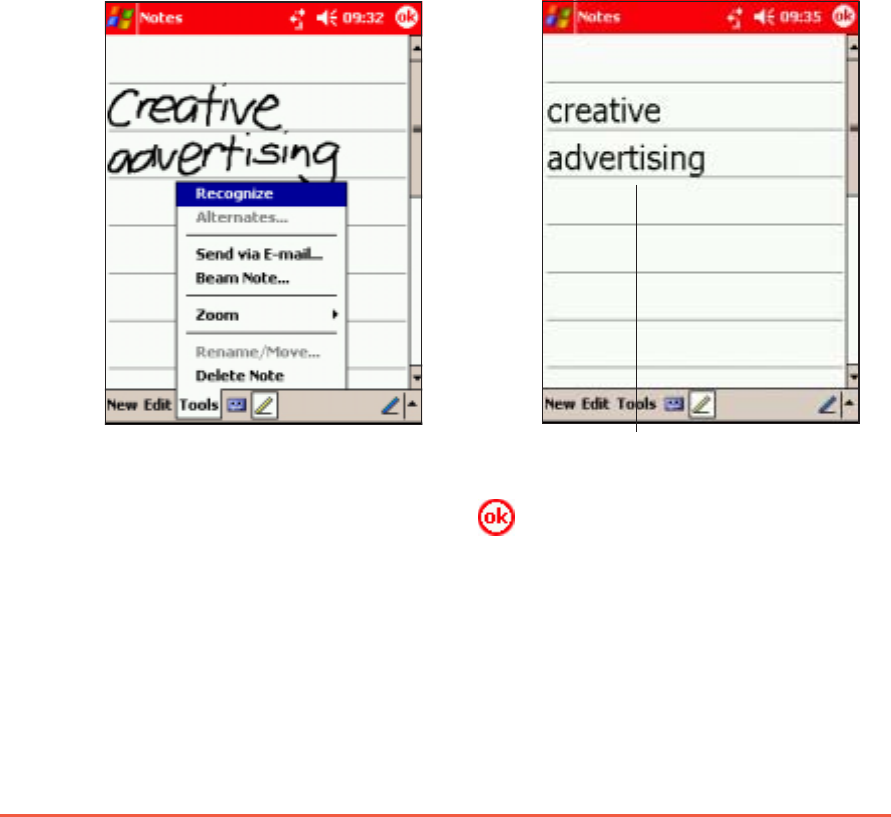
2-12
P505 Pocket PC
The writing is turned into text
To edit your writing:To edit your writing:
To edit your writing:To edit your writing:
To edit your writing:
1. With the Pen button highlighted (i.e. not in writing mode), tap and
hold the stylus next to the text that you wish to select until the
insertion point appears.
2. Without lifting, drag the stylus across the text to select it.
If you accidentally write on the screen, tap ToolsTools
ToolsTools
Tools, then UndoUndo
UndoUndo
Undo
and try again. You can also select text by tapping the PenPen
PenPen
Pe n button
to deselect it, then dragging the stylus across the screen.
3. Tap EditEdit
EditEdit
Ed i t on the Command bar and select an action, or use one of
the tools in the Input Panel to enter a new text.
To select a zoom level:To select a zoom level:
To select a zoom level:To select a zoom level:
To select a zoom level:
•Tap
ToolsTools
ToolsTools
To ols, then tap a zoom percentage from the options.
To convert writing to text:To convert writing to text:
To convert writing to text:To convert writing to text:
To convert writing to text:
1. Tap ToolsTools
ToolsTools
To ols, then select RecogniseRecognise
RecogniseRecognise
Recognise.
2. If the conversion is correct, tap to save your note.
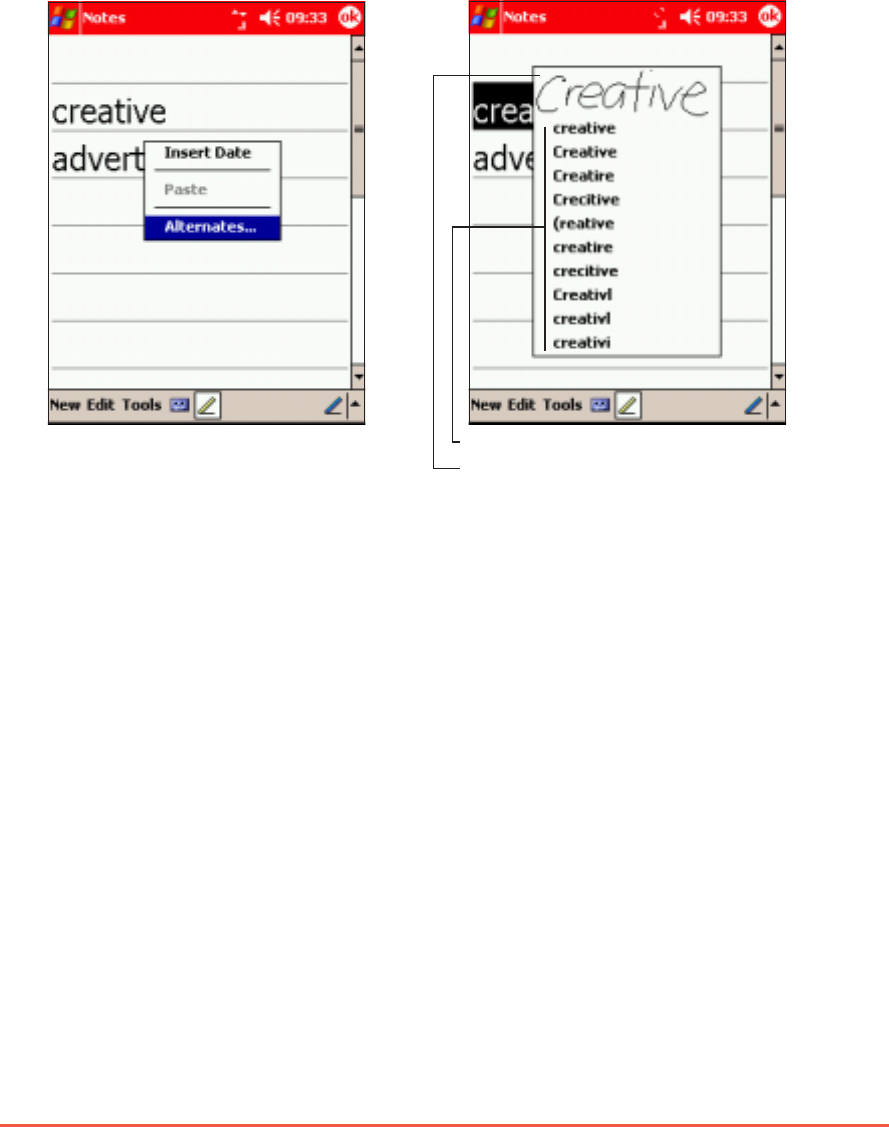
Chapter 2: Learning the Basics
2-13
If the conversion is incorrect, you can select different words from a
list of alternates or return to the original writing.
1. Tap and hold the incorrect word.
2. When the pop-up menu appears, tap AlternatesAlternates
AlternatesAlternates
Alternates to display a list
of alternate words for the selection.
3. Tap the word that you want to use, or tap the writing at the top
of the menu to return to the original writing.
Writing recognition tipsWriting recognition tips
Writing recognition tipsWriting recognition tips
Writing recognition tips
• Write neatly.
• Write on the line and draw descenders below the line. Write the
cross of the “t” and apostrophes below the top line so that they
are not confused with the word above. Write full-stops and
commas above the line.
• For better recognition, try increasing the zoom level to 300%
using the Tools menu.
• Do not spread the letters of a word, keep the letters relatively
close to each other so that the device can easily tell where the
words begin and end.
• Hyphenated words, foreign words that use special characters such
as accents, and some punctuation cannot be converted.
• If you add writing to a word to change it after the word has been
recognised, the writing that you added will be included when you
try to recognise the writing again.
Or, tap to return to your original writing
Tap an alternate word that you want to use
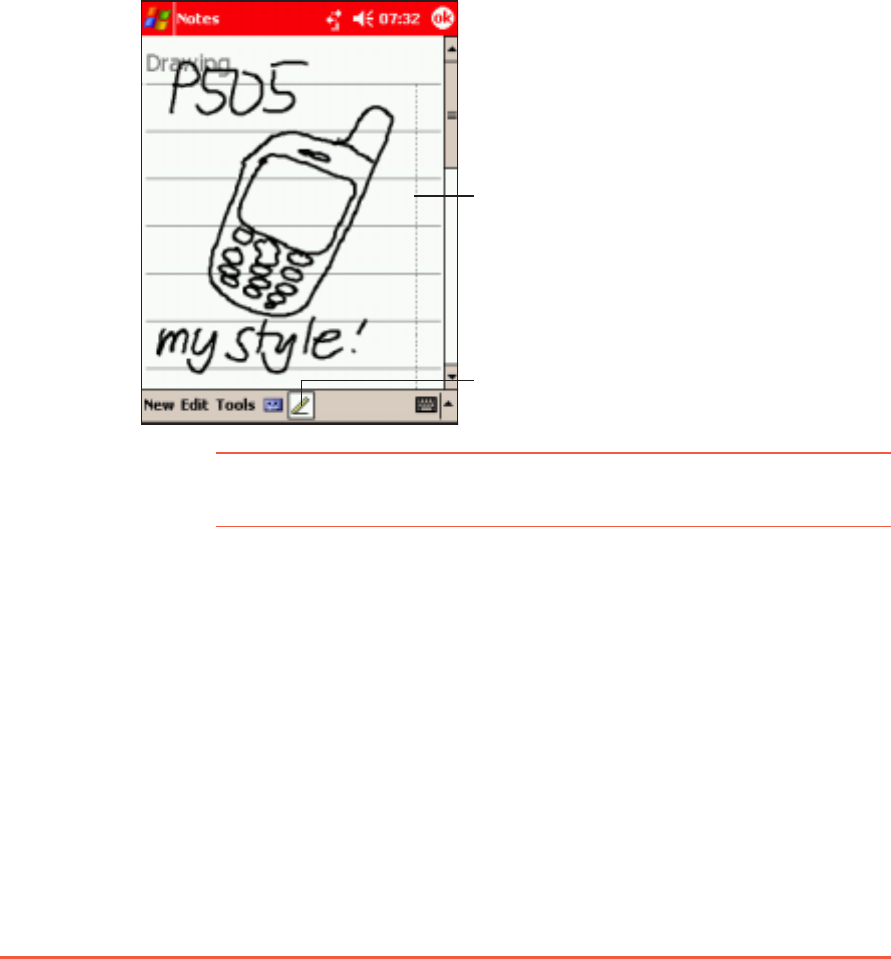
2-14
P505 Pocket PC
Drawing on the screenDrawing on the screen
Drawing on the screenDrawing on the screen
Drawing on the screen
You can draw on the screen in the same way that you write on the
screen. The difference between writing and drawing on the screen is
how you select items and how they can be edited. For example,
selected drawings can be resized, while writing cannot.
To create a drawing:To create a drawing:
To create a drawing:To create a drawing:
To create a drawing:
1. Use the stylus to create a drawing three ruled lines high. A
bounding box appears around the drawing.
2. Start another drawing within the bounding box, then end the
drawing outside the bounding box. The bounding box expands to
include the new drawing.
NOTENOTE
NOTENOTE
N O T E To easily work on or view your drawing, change the zoom
level by tapping ToolsTools
ToolsTools
T o o l s and selecting your desired level.
To edit your drawing:To edit your drawing:
To edit your drawing:To edit your drawing:
To edit your drawing:
1. Tap and hold the stylus on the drawing until the selection handle
appears. To select multiple drawings, deselect the PenPen
PenPen
Pen button,
then drag to select the drawings you want.
2. Tap and hold the selected drawing, then tap an editing command
on the pop-up menu or tap a command on the Edit menu.
3. Resize the drawing by deselecting the PenPen
PenPen
Pen button (if selected)
and dragging a selection handle to your desired size.
The bounding box indicates the
drawing boundaries
Pen button
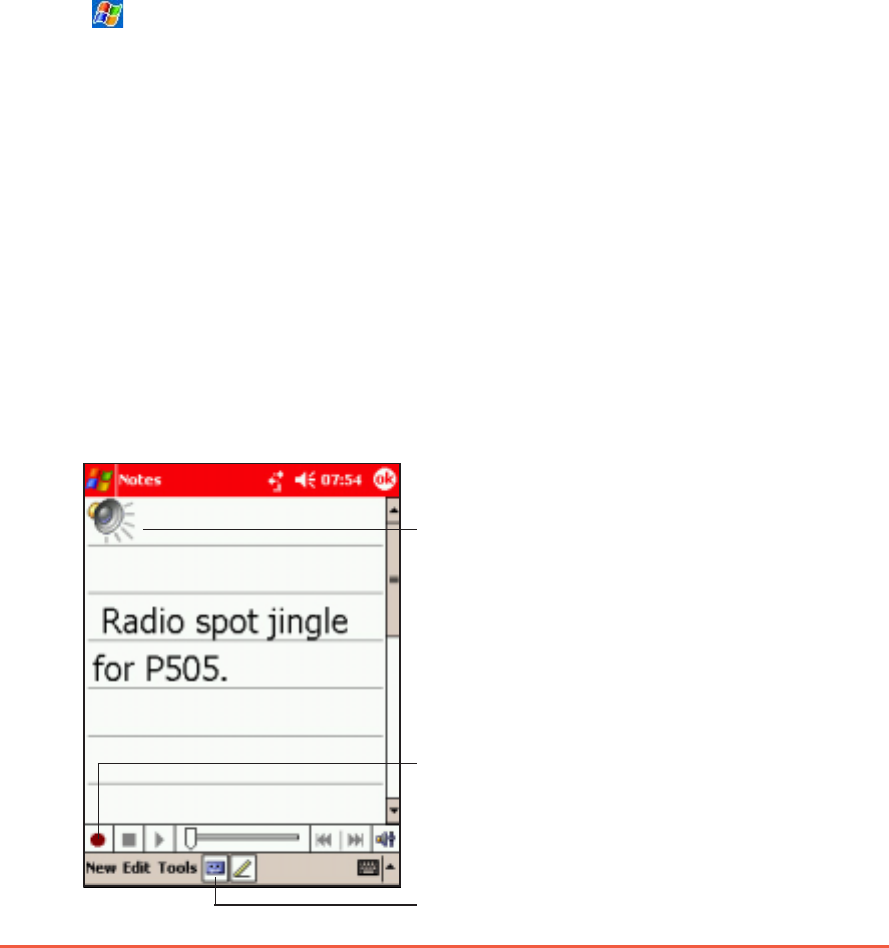
Chapter 2: Learning the Basics
2-15
Recording a messageRecording a message
Recording a messageRecording a message
Recording a message
In any application where you can write or draw on the screen, you can
also quickly capture thoughts, reminders, and phone numbers by
recording a message.
In CalendarCalendar
CalendarCalendar
Calendar, TasksTasks
TasksTasks
Tasks, and ContactsContacts
ContactsContacts
Contacts, you can include a recording in
the NotesNotes
NotesNotes
Not es tab. In the NotesNotes
NotesNotes
Not es program, you can either create a
stand-alone recording or include a recording in a written note. If you
want to include the recording in a note, open the note first.
In the MessagingMessaging
MessagingMessaging
Messaging program, you can add a recording to an MMS or
e-mail message.
To create a recording:To create a recording:
To create a recording:To create a recording:
To create a recording:
1. Tap , then tap NotesNotes
NotesNotes
Notes or
Tap NewNew
NewNew
New, then NoteNote
NoteNote
Notes
2. Tap the Record icon Record icon
Record icon Record icon
Record icon from the command bar to display the
recording toolbar.
3. Tap the Record buttonRecord button
Record buttonRecord button
Record button (red button) to begin recording.
4. Hold your device with the microphone near to the source of what
you are recording.
5. To stop recording, tap the RecordRecord
RecordRecord
Rec ord button. You will hear two
beeps. The new recording appears in the Note list, or as an
embedded icon.
6. To play the recording, tap it from the list, or if embedded in a
note, tap the speaker icon.
Indicates an embedded recording
Tap to show or hide the Recording toolbar
Tap to begin recording
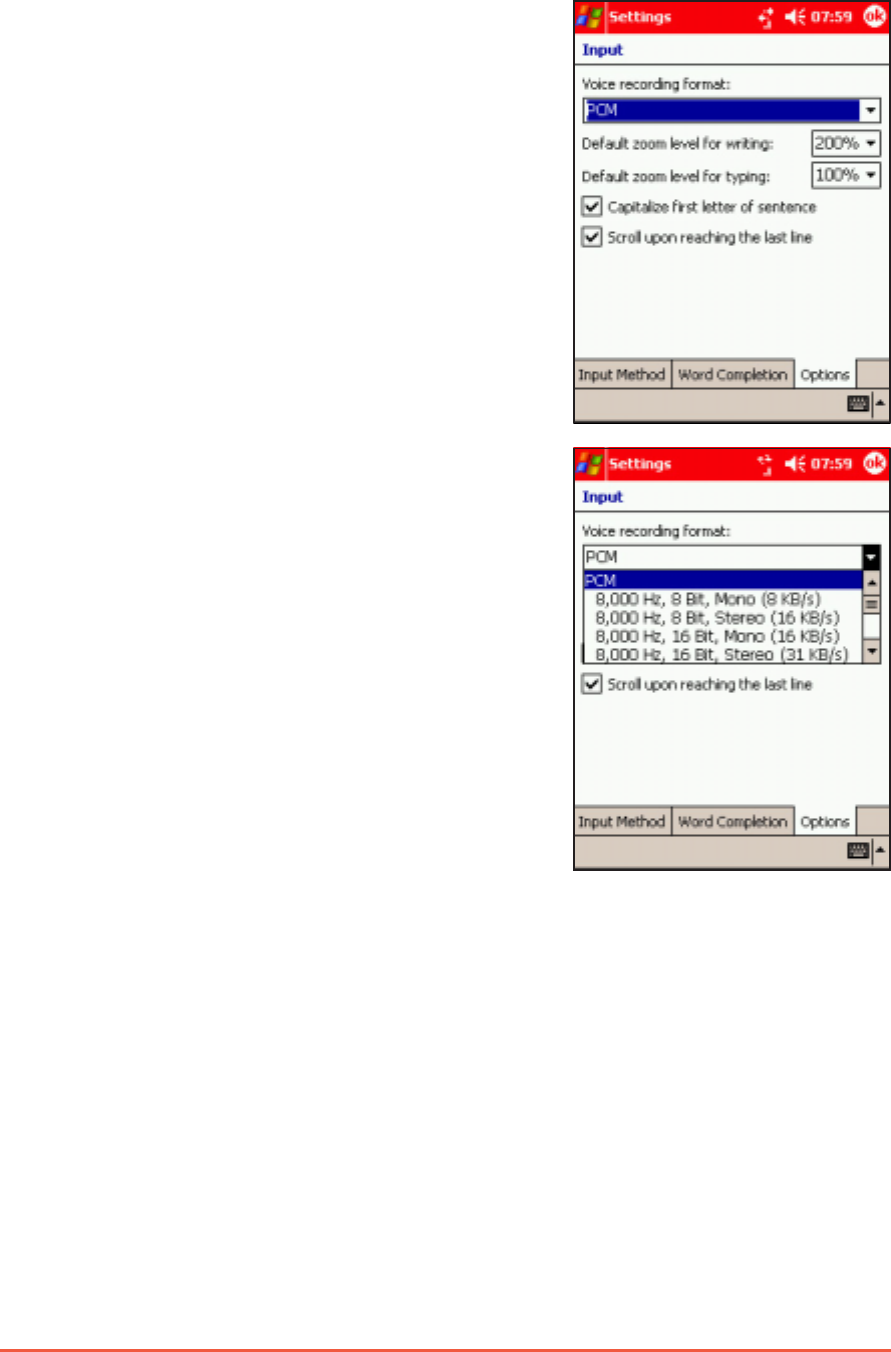
2-16
P505 Pocket PC
To change the recording format:To change the recording format:
To change the recording format:To change the recording format:
To change the recording format:
1. In the note list, tap ToolsTools
ToolsTools
Tools then
OptionsOptions
OptionsOptions
Options.
2. Tap the Global Input OptionsGlobal Input Options
Global Input OptionsGlobal Input Options
Global Input Options link.
3. Tap the OptionsOptions
OptionsOptions
Options tab.
Notes on recording formatsNotes on recording formats
Notes on recording formatsNotes on recording formats
Notes on recording formats
••
••
•GSMGSM
GSMGSM
G S M is a 2.4KB audio codec. It is the recommended format
because it provides good voice recording and less storage space.
••
••
•Pulse Code Modulation (PCM)Pulse Code Modulation (PCM)
Pulse Code Modulation (PCM)Pulse Code Modulation (PCM)
Pulse Code Modulation (PCM) provides slightly better sound
quality but takes up 50 times more storage space than GSM
recordings.
4. Tap the Voice recording formatVoice recording format
Voice recording formatVoice recording format
Voice recording format
field to display available recording
formats, then select from the list.
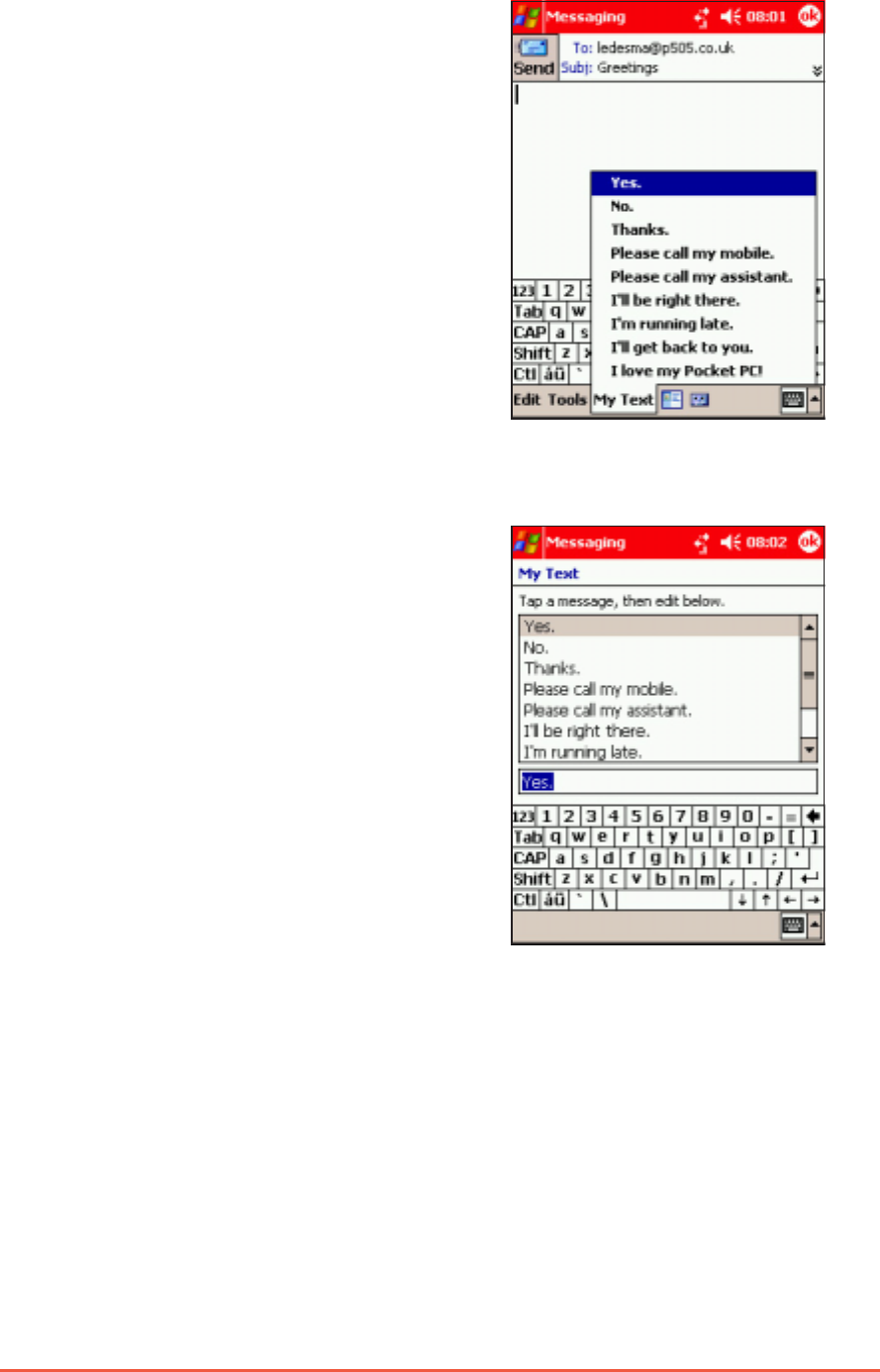
Chapter 2: Learning the Basics
2-17
Using a preset messageUsing a preset message
Using a preset messageUsing a preset message
Using a preset message
When composing e-mail, MMS, or SMS
messages, or when using MSN
Messenger, use My Text My Text
My Text My Text
My Text to quickly
insert preset or frequently used
messages to the text entry area. To
insert a message, tap My Text My Text
My Text My Text
My Text and
tap your desired message.
To edit a preset message:To edit a preset message:
To edit a preset message:To edit a preset message:
To edit a preset message:
1. Tap ToolsTools
ToolsTools
Tools, then Edit My TextEdit My Text
Edit My TextEdit My Text
Edit My Text
MessagesMessages
MessagesMessages
Messages.
2. Select a message and make your
desired changes.
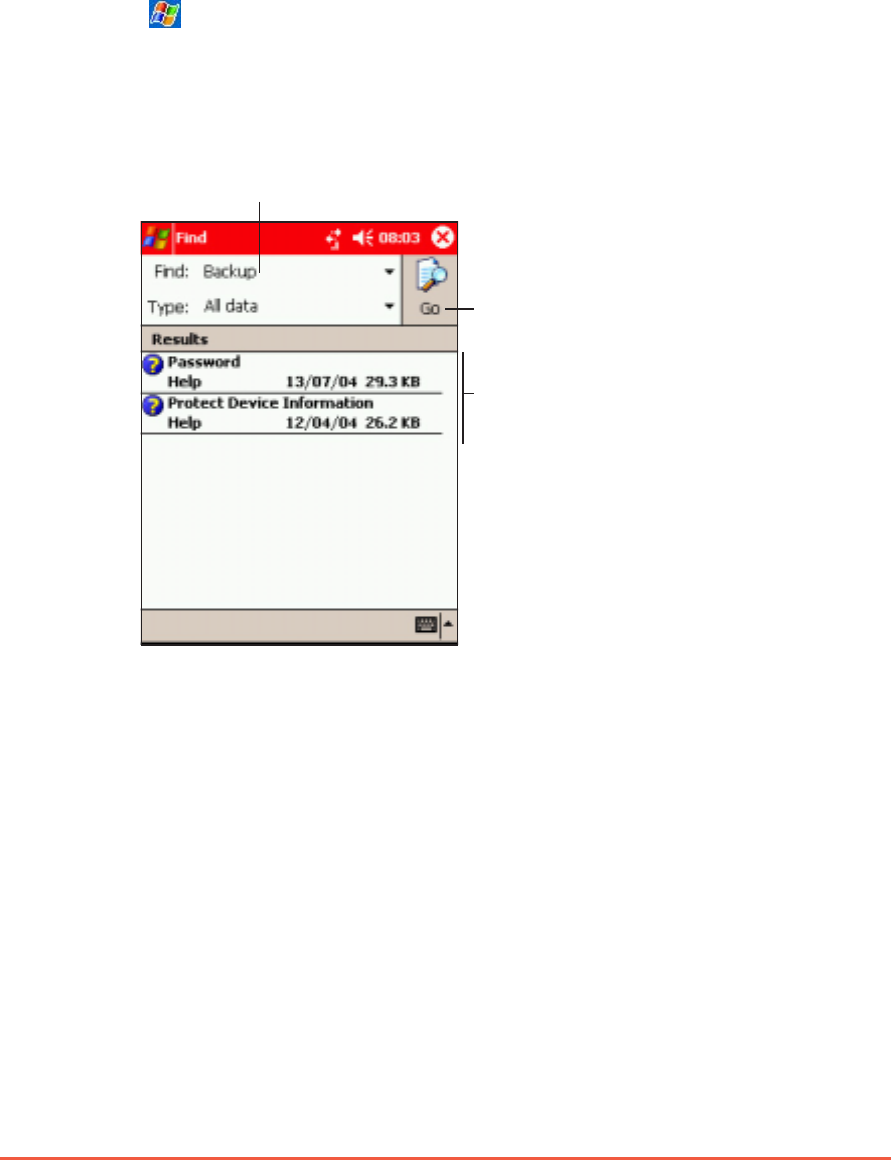
2-18
P505 Pocket PC
Finding and organising informationFinding and organising information
Finding and organising informationFinding and organising information
Finding and organising information
The FindFind
FindFind
Find and HelpHelp
HelpHelp
He l p features on your device helps you quickly locate
information.
Using FindUsing Find
Using FindUsing Find
Using Find
To find information:To find information:
To find information:To find information:
To find information:
1. Tap , tap ProgramsPrograms
ProgramsPrograms
Programs, then tap FindFind
FindFind
Find.
2. Enter the text that you want to find, select a data type, then tap
GoGo
GoGo
G o to start the search. To quickly find information that is taking
up space on your device, select Larger than 64 KBLarger than 64 KB
Larger than 64 KBLarger than 64 KB
Larger than 64 KB in Type.
Type a word to find
Tap to search for the word
Topics found containing the searched word
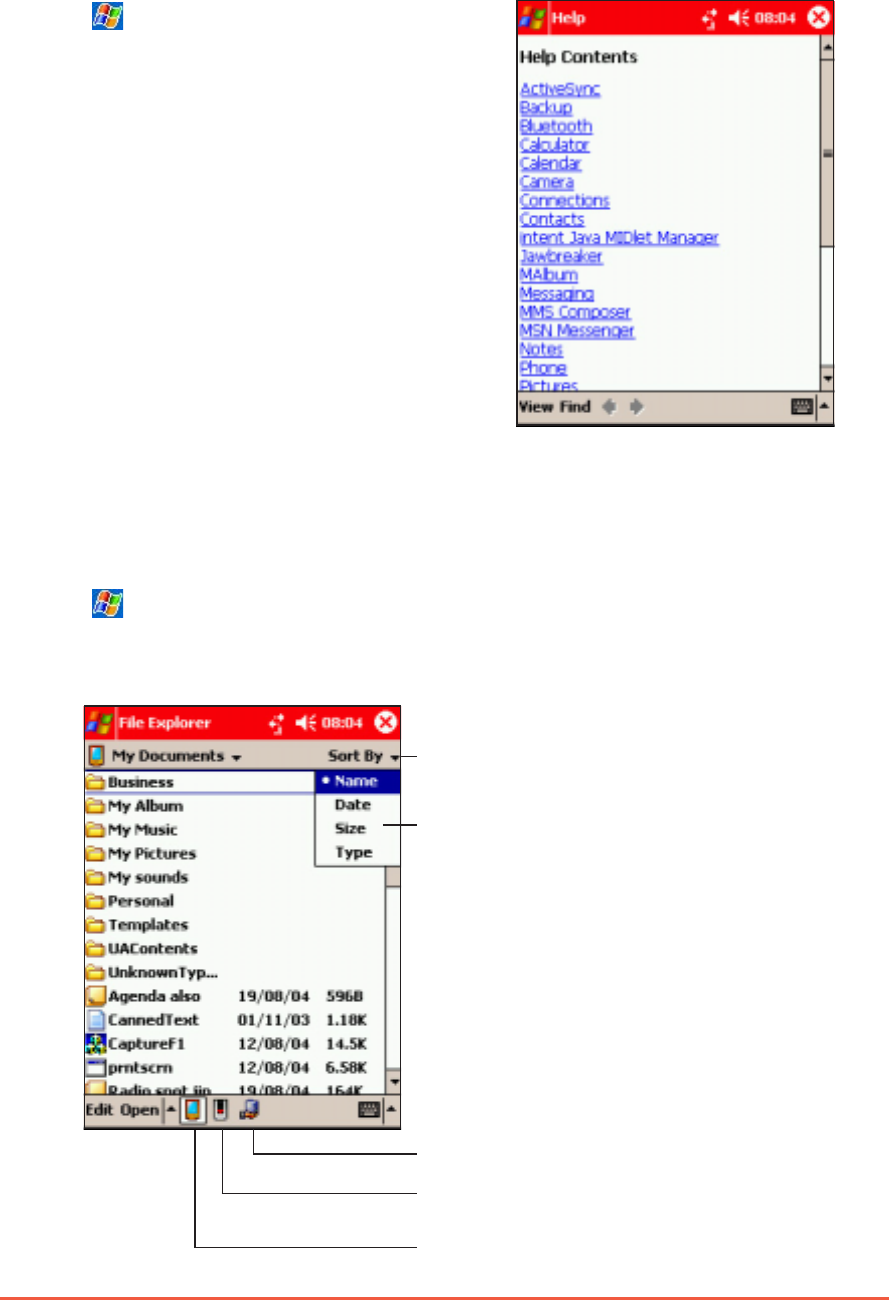
Chapter 2: Learning the Basics
2-19
Using the File ExplorerUsing the File Explorer
Using the File ExplorerUsing the File Explorer
Using the File Explorer
To use the File Explorer to find and organise files:To use the File Explorer to find and organise files:
To use the File Explorer to find and organise files:To use the File Explorer to find and organise files:
To use the File Explorer to find and organise files:
1. Tap , then tap ProgramsPrograms
ProgramsPrograms
Programs.
2. In the Program screen, tap the File ExplorerFile Explorer
File ExplorerFile Explorer
File Explorer icon to display the
files in your device.
Using HelpUsing Help
Using HelpUsing Help
Using Help
To use the Help feature:To use the Help feature:
To use the Help feature:To use the Help feature:
To use the Help feature:
1. Tap , then tap HelpHelp
HelpHelp
Help.
2. Tap a link to the topic that you
wish to display.
Tap to select a sort
order
Tap to display sort
options
Tap to display the contents of My Documents
folder
Tap to display the contents of the Flash disk or
the storage card
Tap to open a path to a network
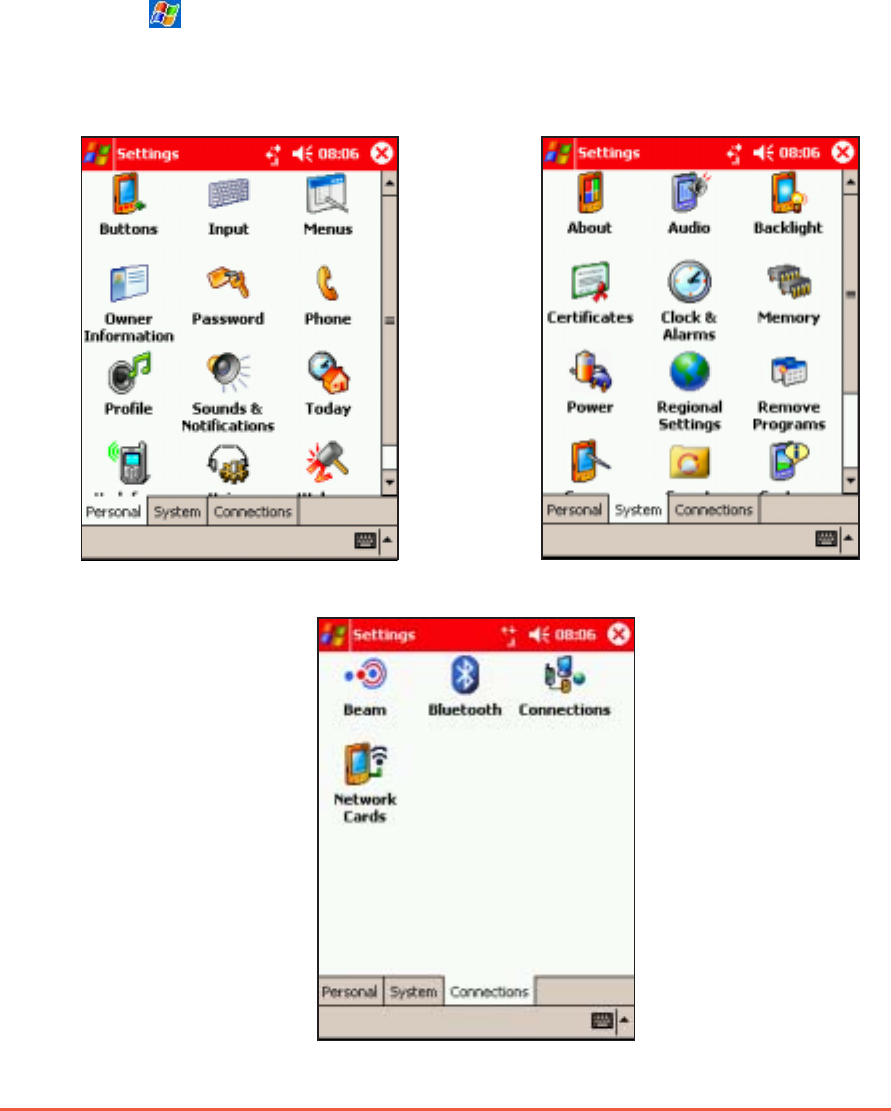
2-20
P505 Pocket PC
Customising your deviceCustomising your device
Customising your deviceCustomising your device
Customising your device
You can customise your device by adjusting the settings, using the
built-in programs, and installing additional software applications.
Adjusting settingsAdjusting settings
Adjusting settingsAdjusting settings
Adjusting settings
You can adjust the device settings to your preference.
To see the available options:To see the available options:
To see the available options:To see the available options:
To see the available options:
1. Tap , then tap SettingsSettings
SettingsSettings
Settings to display the SettingsSettings
SettingsSettings
Settings screen.
2. Tap the PersonalPersonal
PersonalPersonal
Personal, SystemSystem
SystemSystem
System or ConnectionsConnections
ConnectionsConnections
Connections tab on the bottom
of the screen.
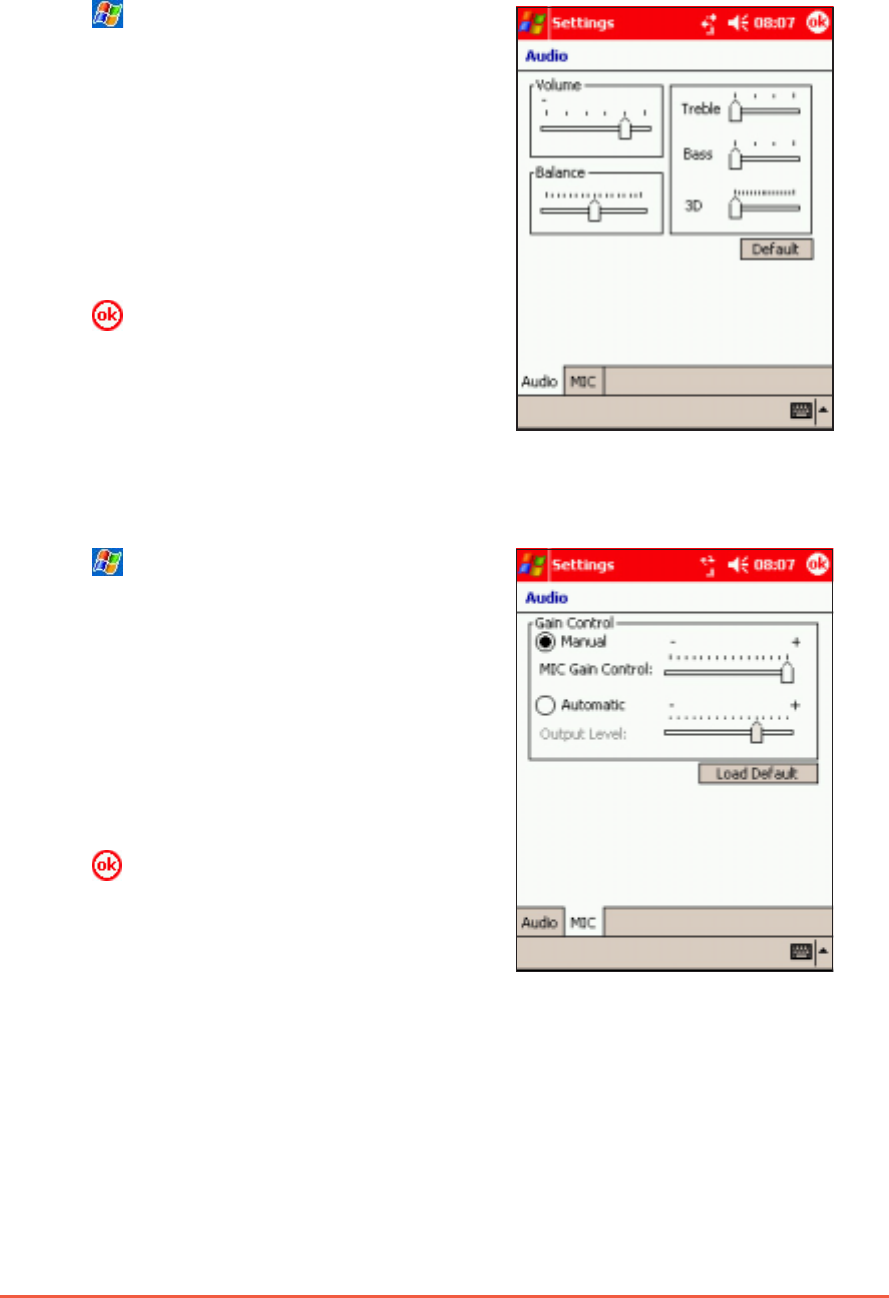
Chapter 2: Learning the Basics
2-21
Changing system settingsChanging system settings
Changing system settingsChanging system settings
Changing system settings
To change the audio settings:To change the audio settings:
To change the audio settings:To change the audio settings:
To change the audio settings:
1. Tap , then tap SettingsSettings
SettingsSettings
Settings to
display the SettingsSettings
SettingsSettings
Settings screen.
2. Tap the SystemSystem
SystemSystem
System tab, then tap
the AudioAudio
AudioAudio
Audio icon.
3. Use the stylus to move the
VolumeVolume
VolumeVolume
Volume, Balance Balance
Balance Balance
Balance, Treble Treble
Treble Treble
Treble,
BassBass
BassBass
Bass, and 3D3D
3D3D
3 D, sliders to your
desired settings.
4. Tap to save the changes and
to close the screen. Otherwise,
click DefaultDefault
DefaultDefault
Default to revert to the
original settings.
To change the microphone settings:To change the microphone settings:
To change the microphone settings:To change the microphone settings:
To change the microphone settings:
1. Tap , then tap SettingsSettings
SettingsSettings
Settings to
display the SettingsSettings
SettingsSettings
Settings screen.
2. Tap the SystemSystem
SystemSystem
System tab, then tap
the AudioAudio
AudioAudio
Audio icon.
3. Tap the MICMIC
MICMIC
MIC tab.
4. Tap the ManualManual
ManualManual
Manual option, then
move the slider to the desired
microphone gain.
5. Tap to save the changes and
to close the screen. Otherwise,
click Load Default Load Default
Load Default Load Default
Load Default to revert to
the original settings.
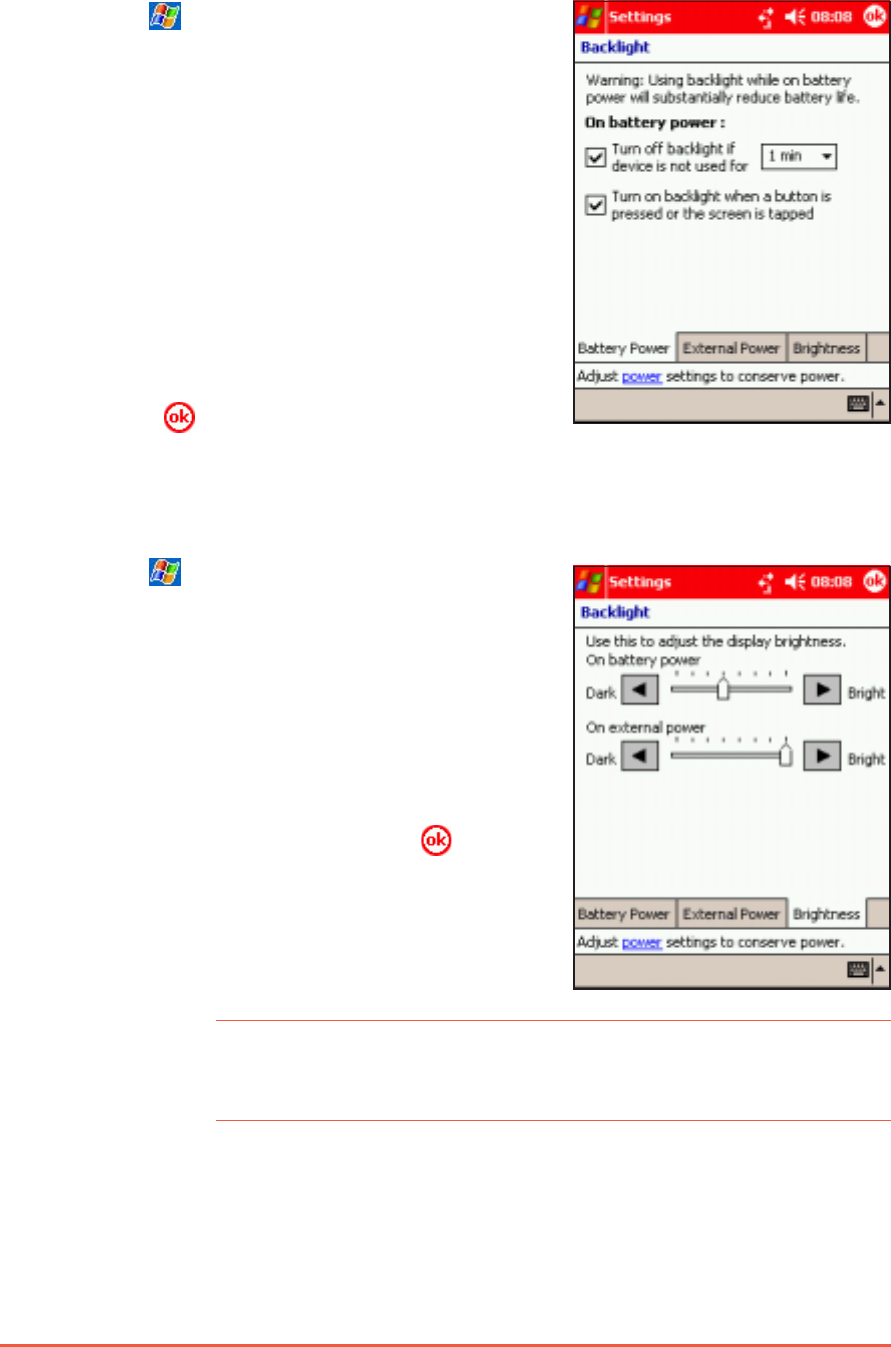
2-22
P505 Pocket PC
To change the backlight settings:To change the backlight settings:
To change the backlight settings:To change the backlight settings:
To change the backlight settings:
1. Tap , then tap SettingsSettings
SettingsSettings
Settings to
display the SettingsSettings
SettingsSettings
Settings screen.
2. Tap the SystemSystem
SystemSystem
System tab, then tap
the BacklightBacklight
BacklightBacklight
Backlight icon.
The screen displays the
backlight settings when you are
using the battery power.
Tap the External Power External Power
External Power External Power
External Power tab
to adjust the backlight settings
when using external power,
3. Adjust the backlight settings, then
press .
To adjust the backlight brightness:To adjust the backlight brightness:
To adjust the backlight brightness:To adjust the backlight brightness:
To adjust the backlight brightness:
1. Tap , then tap SettingsSettings
SettingsSettings
Settings to
display the SettingsSettings
SettingsSettings
Settings screen.
2. Tap the SystemSystem
SystemSystem
System tab, then tap
the BacklightBacklight
BacklightBacklight
Backlight icon.
3. Tap the BrightnessBrightness
BrightnessBrightness
Brightness tab.
4. Adjust the brightness settings
when the device is on battery or
external power, then press .
NOTENOTE
NOTENOTE
N O T E Turning off the backlight when the device is not in use or
using a lower level of display brightness saves battery power
and improves battery life.
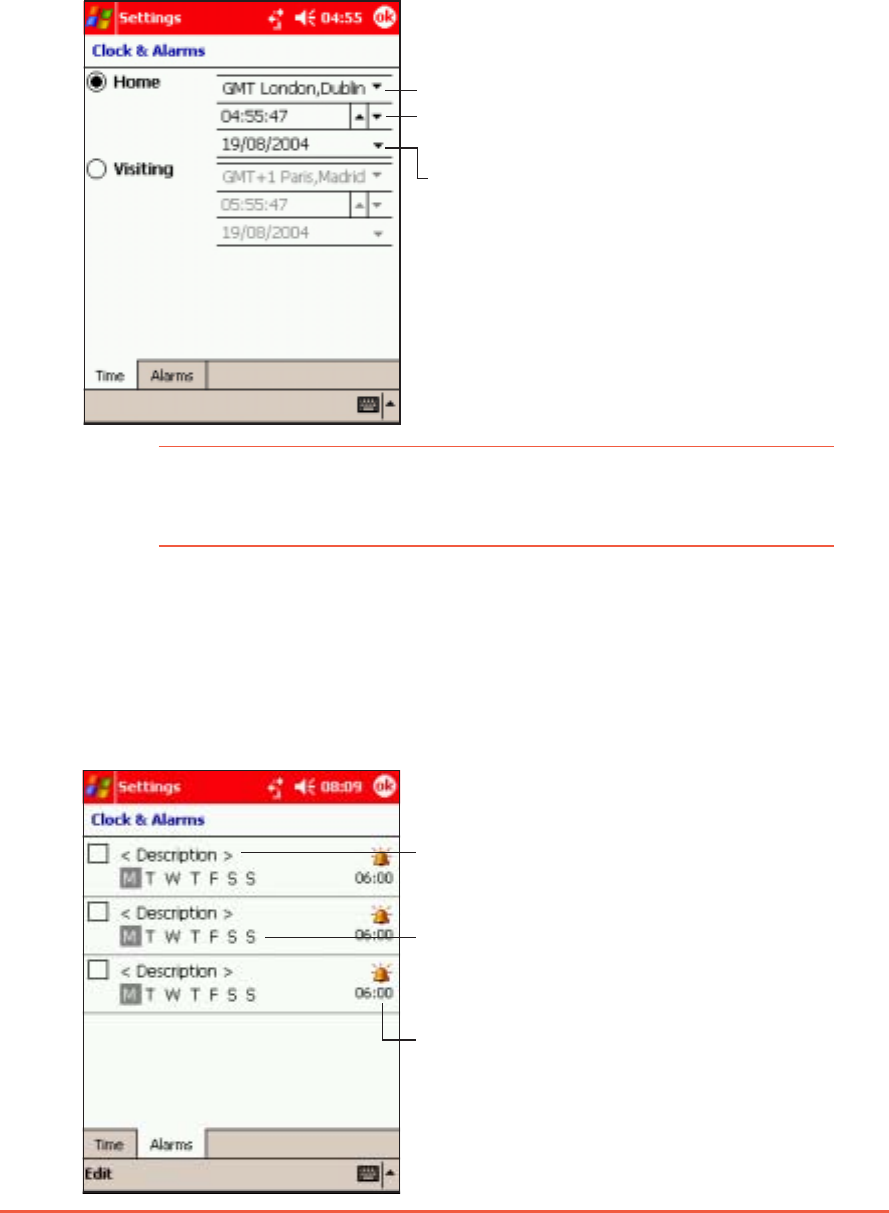
Chapter 2: Learning the Basics
2-23
To change the date and time settings:To change the date and time settings:
To change the date and time settings:To change the date and time settings:
To change the date and time settings:
1. Tap SettingsSettings
SettingsSettings
Settings, then the SystemSystem
SystemSystem
System.
2. Tap the ClockClock
ClockClock
Clock icon.
3. Make your desired settings.
To change the alarm settings:To change the alarm settings:
To change the alarm settings:To change the alarm settings:
To change the alarm settings:
1. Tap SettingsSettings
SettingsSettings
Settings, then the SystemSystem
SystemSystem
System.
2. Tap the ClockClock
ClockClock
Clo ck icon, then the AlarmAlarm
AlarmAlarm
Alarm tab.
3. Make your desired settings.
NOTENOTE
NOTENOTE
N O T E When travelling, setting the home and visiting time zones
ensures that synchronised appointments and messages
appear correctly.
Tap a day of the week for the alarm
Tap and type a description for the alarm
Tap to display the clock and specify a time
for the alarm
Tap to select a time zone
Highlight an hour part then tap up or down arrow
to set
Tap this down arrow to display the CalendarCalendar
CalendarCalendar
Calendar
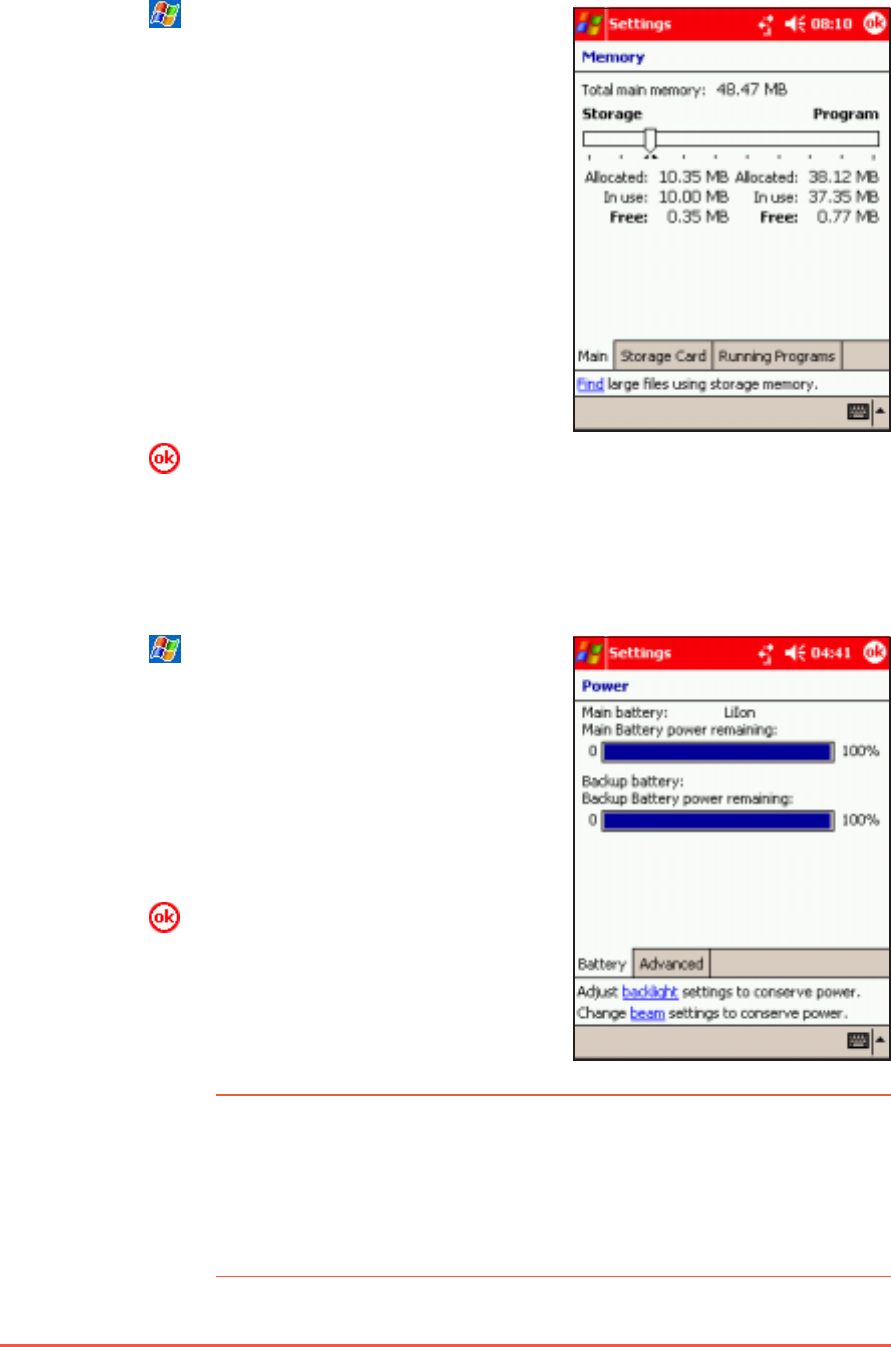
2-24
P505 Pocket PC
To view the device memory:To view the device memory:
To view the device memory:To view the device memory:
To view the device memory:
1. Tap , then tap SettingsSettings
SettingsSettings
Settings to
display the SettingsSettings
SettingsSettings
Settings screen.
2. Tap the SystemSystem
SystemSystem
System tab, then tap
the MemoryMemory
MemoryMemory
Memory icon to view the
main memory information.
3. Tap the Storage Card Storage Card
Storage Card Storage Card
Storage Card tab to
view the storage card memory,
if available.
4. Tap the Running ProgramsRunning Programs
Running ProgramsRunning Programs
Running Programs
tab to view and/or stop
applications currently running on
the device.
5. Tap to return to the previous
window.
To view the device power:To view the device power:
To view the device power:To view the device power:
To view the device power:
1. Tap , then tap SettingsSettings
SettingsSettings
Settings to
display the SettingsSettings
SettingsSettings
Settings screen.
2. Tap the SystemSystem
SystemSystem
System tab, then tap
the PowerPower
PowerPower
Power icon to view the
battery power information.
3. Tap the AdvancedAdvanced
AdvancedAdvanced
Advanced tab to
adjust the power settings.
4. Tap to return to the previous
window.
NOTENOTE
NOTENOTE
N O T E You can save battery power by:
1. Turning off the backlight when the device is not in use.
2. Decreasing the display brightness level.
3. Switching the processor to power saving mode. See
page 2-28 for details.
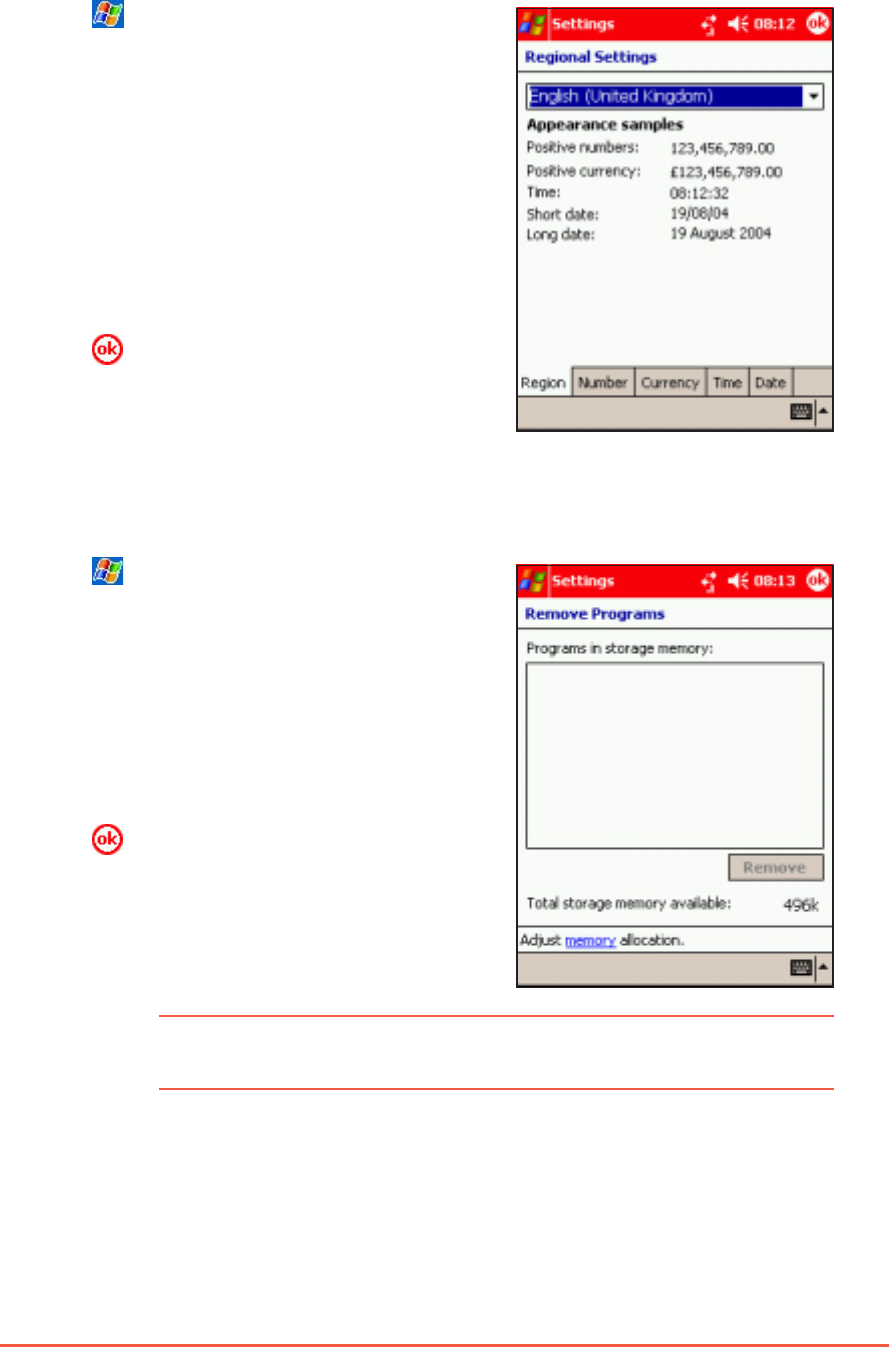
Chapter 2: Learning the Basics
2-25
To change the regional settings:To change the regional settings:
To change the regional settings:To change the regional settings:
To change the regional settings:
1. Tap , then tap SettingsSettings
SettingsSettings
Settings to
display the SettingsSettings
SettingsSettings
Settings screen.
2. Tap the SystemSystem
SystemSystem
System tab, then tap
the Regional Settings Regional Settings
Regional Settings Regional Settings
Regional Settings icon.
3. Tap any from the five tabs at
the bottom of the display to
adjust the region, number,
currency, time, and date
settings.
4. Tap to return to the previous
window.
To remove a program from your Pocket PC:To remove a program from your Pocket PC:
To remove a program from your Pocket PC:To remove a program from your Pocket PC:
To remove a program from your Pocket PC:
1. Tap , then tap SettingsSettings
SettingsSettings
Settings to
display the SettingsSettings
SettingsSettings
Settings screen.
2. Tap the SystemSystem
SystemSystem
System tab, then tap
the Remove Programs Remove Programs
Remove Programs Remove Programs
Remove Programs icon.
3. From the list, select the program
you wish to remove, then tap
RemoveRemove
RemoveRemove
Remove.
4. Tap to return to the previous
window.
NOTENOTE
NOTENOTE
N O T E Take caution when removing programs from your Pocket PC.
You may not be able to restore the program after removing it.
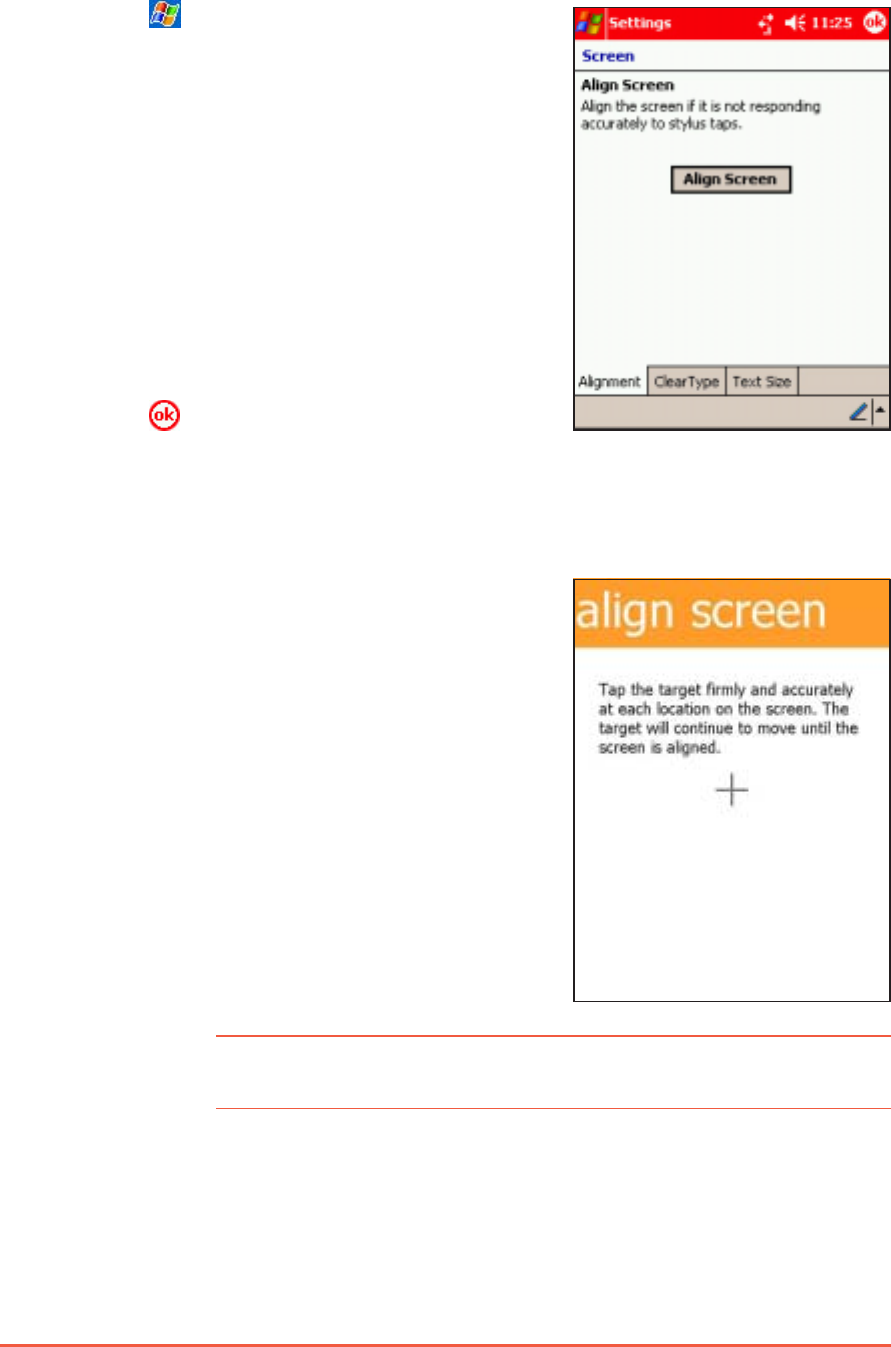
2-26
P505 Pocket PC
To change the screen settings:To change the screen settings:
To change the screen settings:To change the screen settings:
To change the screen settings:
1. Tap , then tap SettingsSettings
SettingsSettings
Settings to
display the SettingsSettings
SettingsSettings
Settings screen.
2. Tap the SystemSystem
SystemSystem
System tab, then tap
the ScreenScreen
ScreenScreen
Screen icon. The window
shows the align screen settings.
Refer to the next section for
details.
3. Tap the Clear Type Clear Type
Clear Type Clear Type
Clear Type tab to
enable Clear Type. Clear Type
smoothens the screen font
edges.
4. Tap to return to the previous
window.
NOTENOTE
NOTENOTE
N O T E Perform a screen alignment if the screen does not respond
correctly to stylus taps.
To align the screen:To align the screen:
To align the screen:To align the screen:
To align the screen:
1. Tap the Align Screen Align Screen
Align Screen Align Screen
Align Screen button ,
on the ScreenScreen
ScreenScreen
Screen window. An
Align Screen Align Screen
Align Screen Align Screen
Align Screen window appears.
2. Tap the centre of the target
accurately. The target moves
from one location to another.
Continue tapping the centre of
the target until the screen
alignment is finished.
The window returns to the
ScreenScreen
ScreenScreen
Screen window.
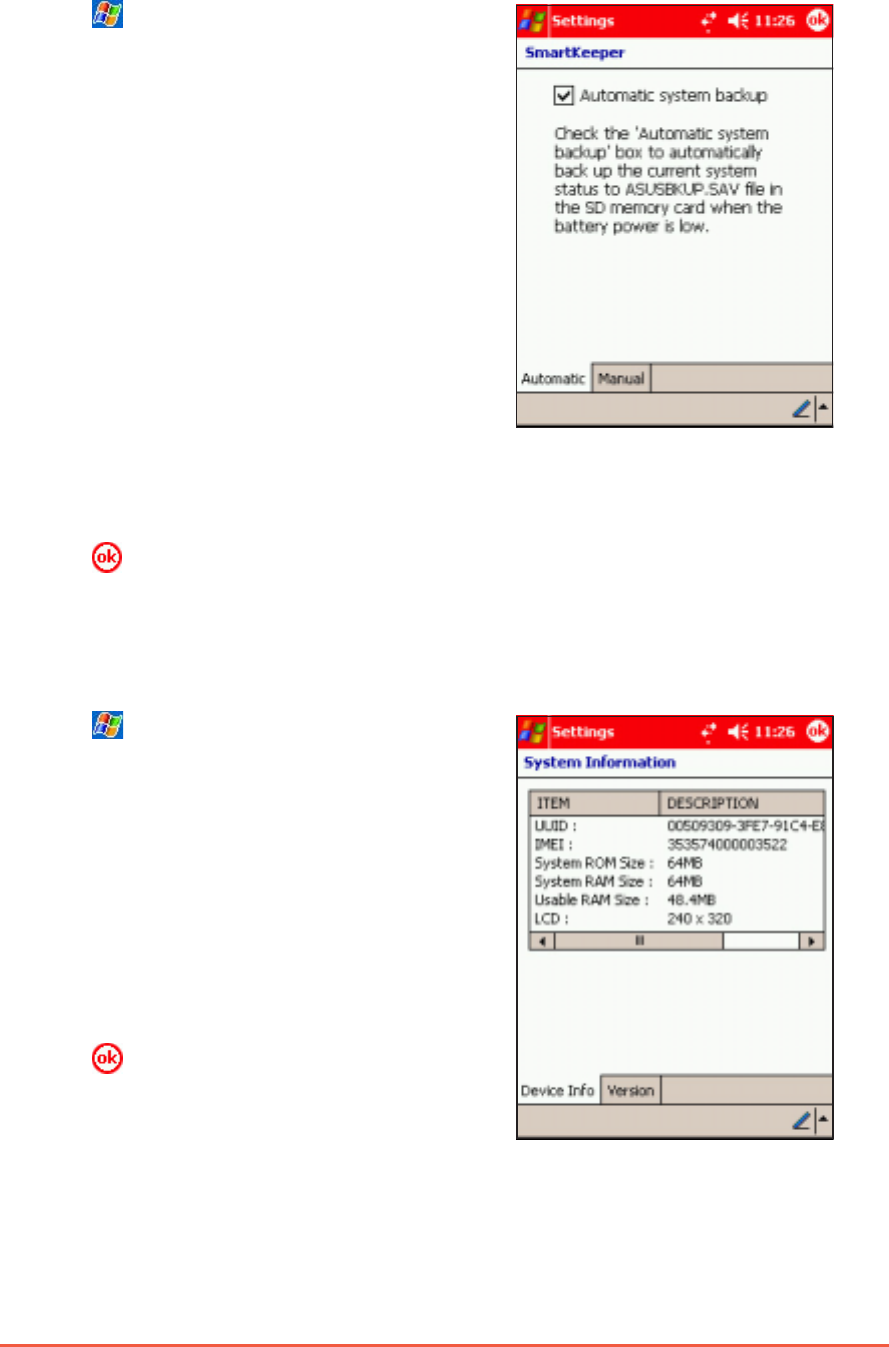
Chapter 2: Learning the Basics
2-27
To change the SmartKeeper utility settings:To change the SmartKeeper utility settings:
To change the SmartKeeper utility settings:To change the SmartKeeper utility settings:
To change the SmartKeeper utility settings:
1. Tap , then tap SettingsSettings
SettingsSettings
Settings to
display the SettingsSettings
SettingsSettings
Settings screen.
2. Tap the SystemSystem
SystemSystem
System tab, then tap
the SmartKeeperSmartKeeper
SmartKeeperSmartKeeper
SmartKeeper icon. The
window shows the general
screen settings.
3. Check the Automatic systemAutomatic system
Automatic systemAutomatic system
Automatic system
backupbackup
backupbackup
bac kup option to allow
SmartKeeper to backup your
files and programs to the SD
card automatically when the
battery is low.
Tap the ManualManual
ManualManual
Manual tab to manually
backup or restore your files and programs. See page 2-27 for
details.
4. Tap to return to the previous window.
To view the system information:To view the system information:
To view the system information:To view the system information:
To view the system information:
1. Tap , then tap SettingsSettings
SettingsSettings
Settings to
display the SettingsSettings
SettingsSettings
Settings screen.
2. Tap the SystemSystem
SystemSystem
System tab, then tap
the System Infromation System Infromation
System Infromation System Infromation
System Infromation icon.
The window shows the device
information.
3. Tap the VersionVersion
VersionVersion
Version tab to display
the device firmware and
programs version
4. Tap to return to the previous
window.
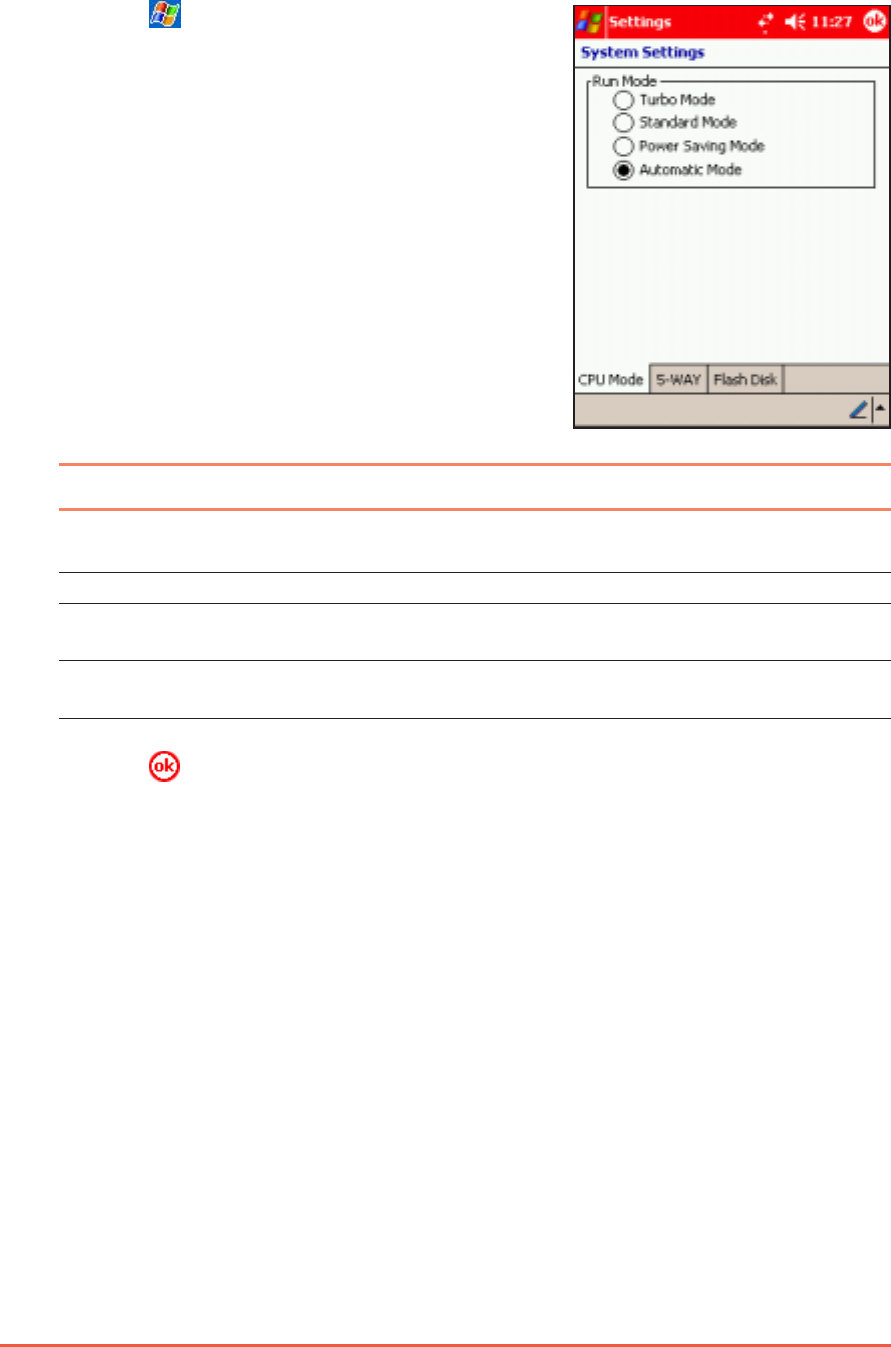
2-28
P505 Pocket PC
To change the device CPU mode:To change the device CPU mode:
To change the device CPU mode:To change the device CPU mode:
To change the device CPU mode:
1. Tap , then tap SettingsSettings
SettingsSettings
Settings to
display the SettingsSettings
SettingsSettings
Settings screen.
2. Tap the SystemSystem
SystemSystem
System tab, then tap
the System Settings System Settings
System Settings System Settings
System Settings icon.
The window displays the device
CPU Mode CPU Mode
CPU Mode CPU Mode
CPU Mode information.
3. Select the Run Mode you want
the processor to run by tapping
the circle preceding the option.
See table below.
ModeMode
ModeMode
Mode Description Description
Description Description
Description
Turbo ModeTurbo Mode
Turbo ModeTurbo Mode
T u r b o M o d e Use for playing games or video. The processor speed
increases to 400 MHz, reducing battery life.
Standard ModeStandard Mode
Standard ModeStandard Mode
S t a n d a r d M o d e Use for listening MP3 audio files.
Power Saving ModePower Saving Mode
Power Saving ModePower Saving Mode
P o w e r S a v i n g M o d e Use when using text-based applications, as this uses a
lower processing speed, extending battery life.
Automatic ModeAutomatic Mode
Automatic ModeAutomatic Mode
A u t o m a t i c M o d e Sets the processing speed according to the application
you are running. This is the default.
4. Tap to return to the previous window.
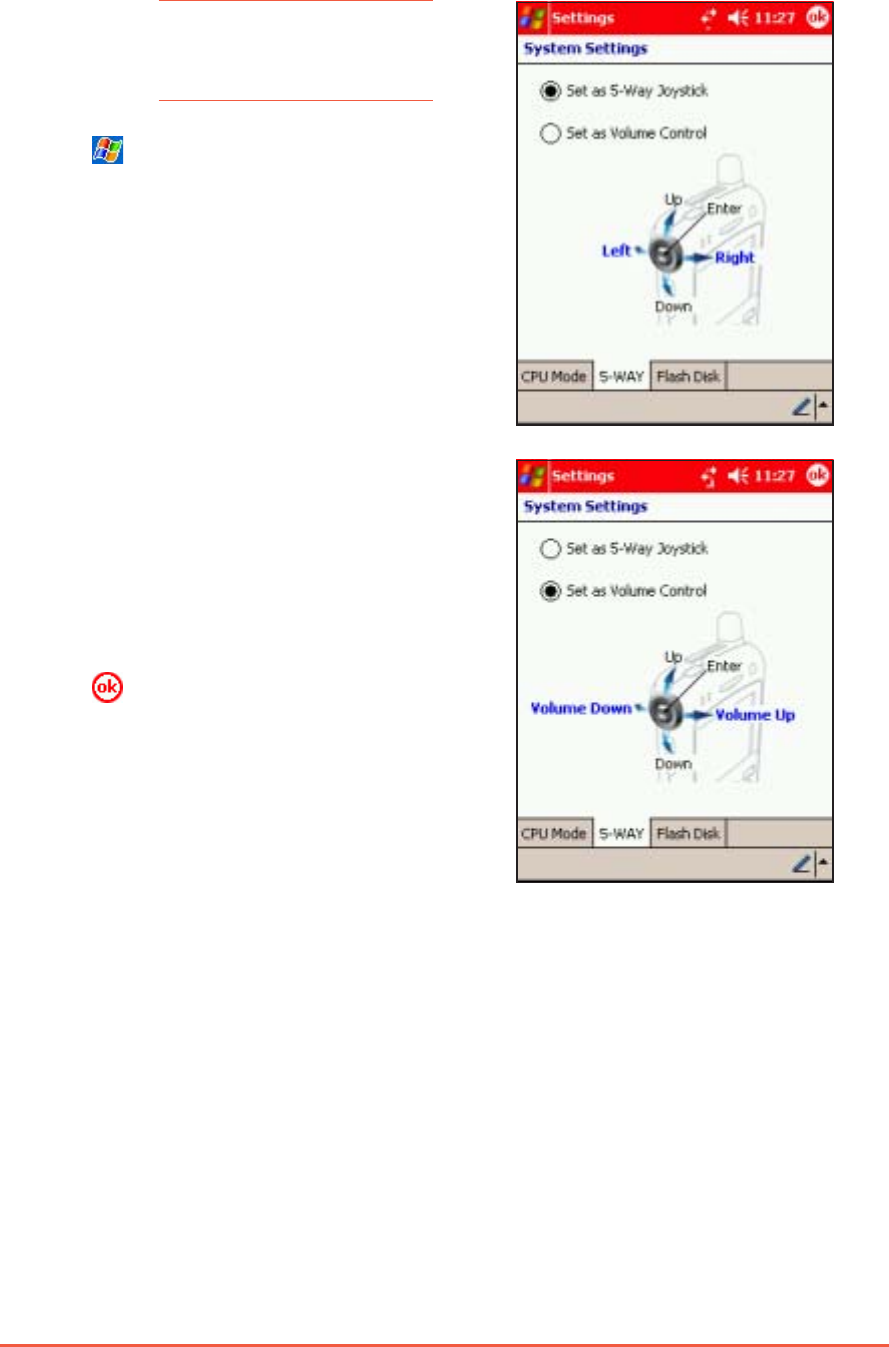
Chapter 2: Learning the Basics
2-29
NOTENOTE
NOTENOTE
N O T E By default, the 5-way
joystick functions as
directional navigator.
1. Tap , then tap SettingsSettings
SettingsSettings
Settings to
display the SettingsSettings
SettingsSettings
Settings screen.
2. Tap the SystemSystem
SystemSystem
System tab, then tap
the System Settings System Settings
System Settings System Settings
System Settings icon.
3. Tap the 5-WAY5-WAY
5-WAY5-WAY
5- WAY tab to display
the current function of the
joystick.
To change the 5-way joystick functions:To change the 5-way joystick functions:
To change the 5-way joystick functions:To change the 5-way joystick functions:
To change the 5-way joystick functions:
4. If you want to use the joystick
for volume control, tap the circle
preceding the option Set asSet as
Set asSet as
Set as
Volume ControlVolume Control
Volume ControlVolume Control
Volume Control. Refer to the
illustration for the joystick
functions.
5. Tap to save your settings
and return to the previous
window.
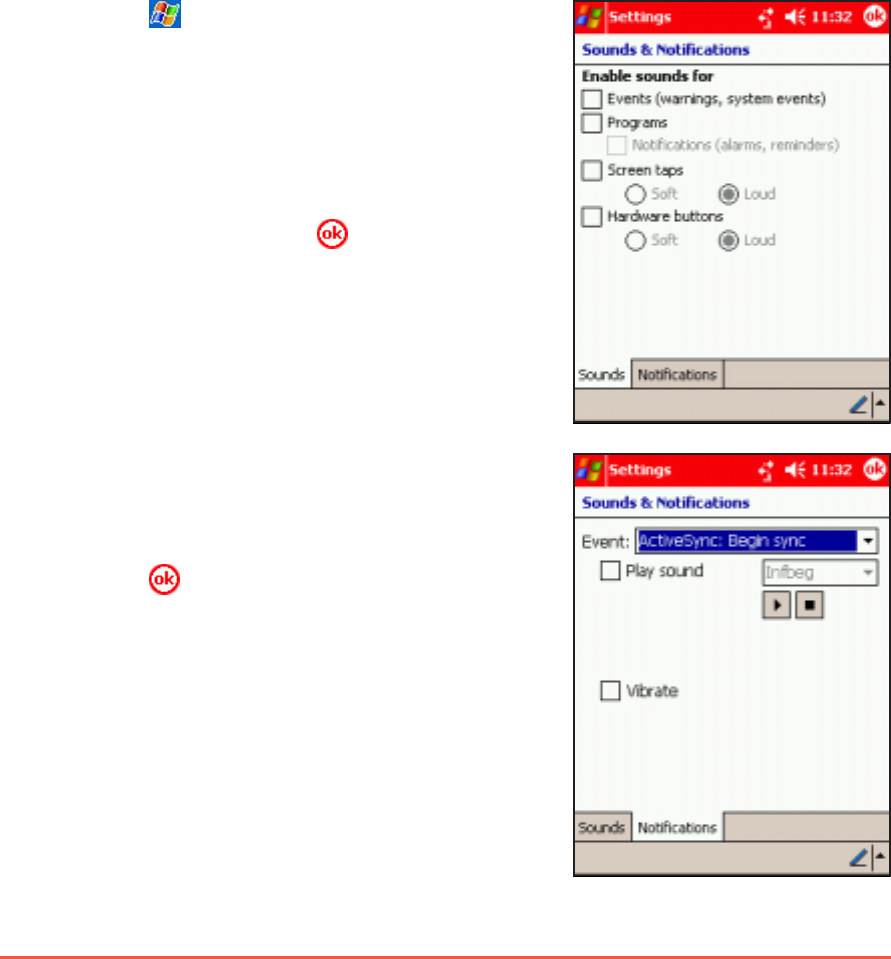
2-30
P505 Pocket PC
Customising personal settingsCustomising personal settings
Customising personal settingsCustomising personal settings
Customising personal settings
Selecting sounds and notificationsSelecting sounds and notifications
Selecting sounds and notificationsSelecting sounds and notifications
Selecting sounds and notifications
Your device can remind you of things you have to do in several ways.
For example, if you have set up an appointment in CalendarCalendar
CalendarCalendar
Calendar, a task
with a due date, or an alarm in ClockClock
ClockClock
Cl ock, you will be notified in any of
the following ways.
• A message box appears on the screen
• A sound is played (you can select the type of sound)
• A light flashes on the device
To choose the reminder types and sounds:To choose the reminder types and sounds:
To choose the reminder types and sounds:To choose the reminder types and sounds:
To choose the reminder types and sounds:
1. Tap , then tap Settings.Settings.
Settings.Settings.
Settings.
2. From the SettingsSettings
SettingsSettings
Settings screen, tap
the Sounds andSounds and
Sounds andSounds and
Sounds and
NotificationsNotifications
NotificationsNotifications
Notifications icon to display
the SoundsSounds
SoundsSounds
Sounds screen.
3. Adjust the items to your desired
settings, then tap to save
your settings and return to the
previous window.
4. Tap the NotificationsNotifications
NotificationsNotifications
Notifications tab and
set the event notification
details.
5. Tap to save your settings
and return to the previous
window.
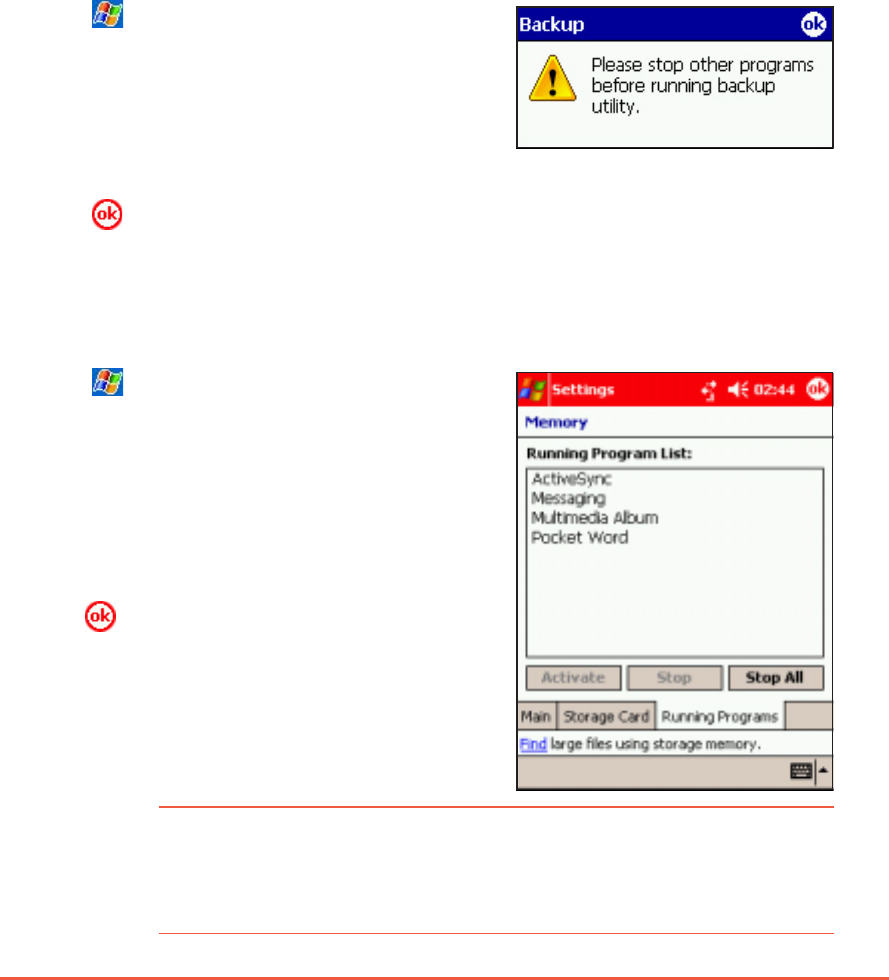
Chapter 2: Learning the Basics
2-31
NOTENOTE
NOTENOTE
N O T E Read the notes in the InformationInformation
InformationInformation
Information tab of the backup
screen before you backup your data or PIM. See the online
help on your device for online instructions on backing up or
restoring data.
Backing up your dataBacking up your data
Backing up your dataBacking up your data
Backing up your data
Besides the SmartKeeper application that allows you to back up all
your data, the device also includes a Backup utility that lets you back
up your system files and/or data contained in the main system
memory.
Unlike the SmartKeeper application’s automaticautomatic
automaticautomatic
automatic backup feature that
backs up the entire system status (system and data) into one backup
file, The BackupBackup
BackupBackup
Bac kup utility allows you to manuallymanually
manuallymanually
manually create separate
backup files for your system files and data files. You may even
categorise the data files and place into different folders.
To access the Backup utility:To access the Backup utility:
To access the Backup utility:To access the Backup utility:
To access the Backup utility:
1. Tap , then tap ProgramsPrograms
ProgramsPrograms
Programs.
2. Tap the BackupBackup
BackupBackup
Backup icon.
A message appears asking you
to stop other programs before
running the backup utility.
3. Tap and stop all running
programs.
To stop all running programs:To stop all running programs:
To stop all running programs:To stop all running programs:
To stop all running programs:
1. Tap , then tap SettingsSettings
SettingsSettings
Settings.
2. Tap the SystemSystem
SystemSystem
System tab, then tap
the MemoryMemory
MemoryMemory
Memory icon.
3. On the Memory screen, tap the
Running ProgramsRunning Programs
Running ProgramsRunning Programs
Running Programs tab.
4. Tap the Stop AllStop All
Stop AllStop All
Stop All button, then
tap .
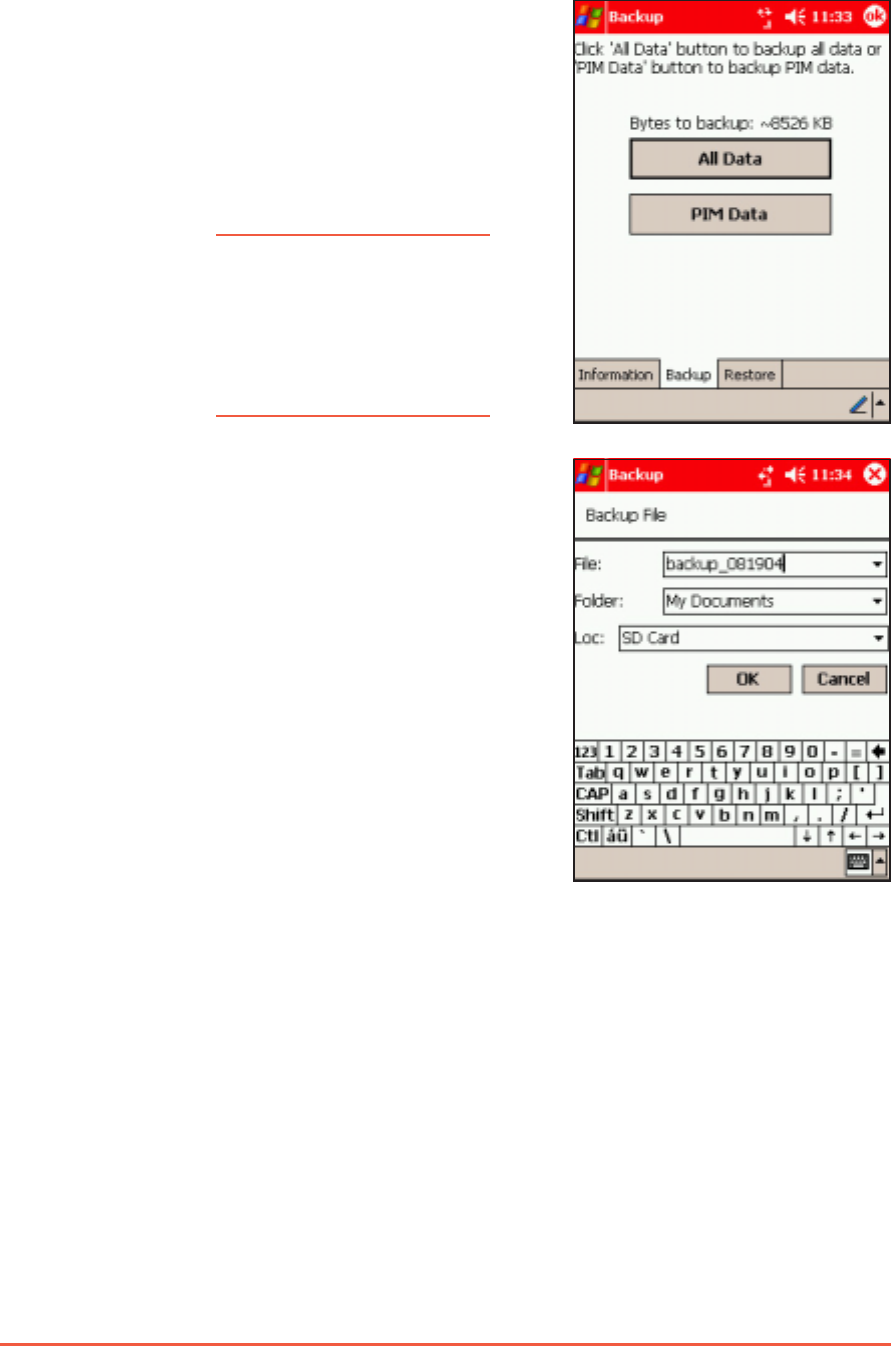
2-32
P505 Pocket PC
To back up all data on your device:To back up all data on your device:
To back up all data on your device:To back up all data on your device:
To back up all data on your device:
1. Return to the Programs screen
and tap the BackupBackup
BackupBackup
Backup icon.
2. Tap the BackupBackup
BackupBackup
Backup tab on the
Backup screen.
3. Tap All DataAll Data
All DataAll Data
All Data button to back up
all data on your device.
4. In the Backup File screen:
• specify a file namefile name
file namefile name
file name for the
backup
• specify the folderfolder
folderfolder
fol der in which to
store the backup file
(optional)
• select the storage device
(Flash Disk*Flash Disk*
Flash Disk*Flash Disk*
Flash Disk* or SD cardSD card
SD cardSD card
SD card)
where you wish to save your
backup file
5. Tap OKOK
OKOK
O K to start the backup
process.
NOTENOTE
NOTENOTE
N O T E You need to insert an SD
memory card if you wish
to save your backup file
on SD. Otherwise, you
can save the backup file
into the Flash Disk*.
*The
Flash DiskFlash Disk
Flash DiskFlash Disk
F l a s h D i s k is also the 64 Mb Flash Read Only Memory (ROM) chip where the
operating system is stored. The flash disk has more or less 10 Mb of free space
that you can use to save or back up data from your device. Data saved on the
flash disk are permanently stored even after you hard reset the device.
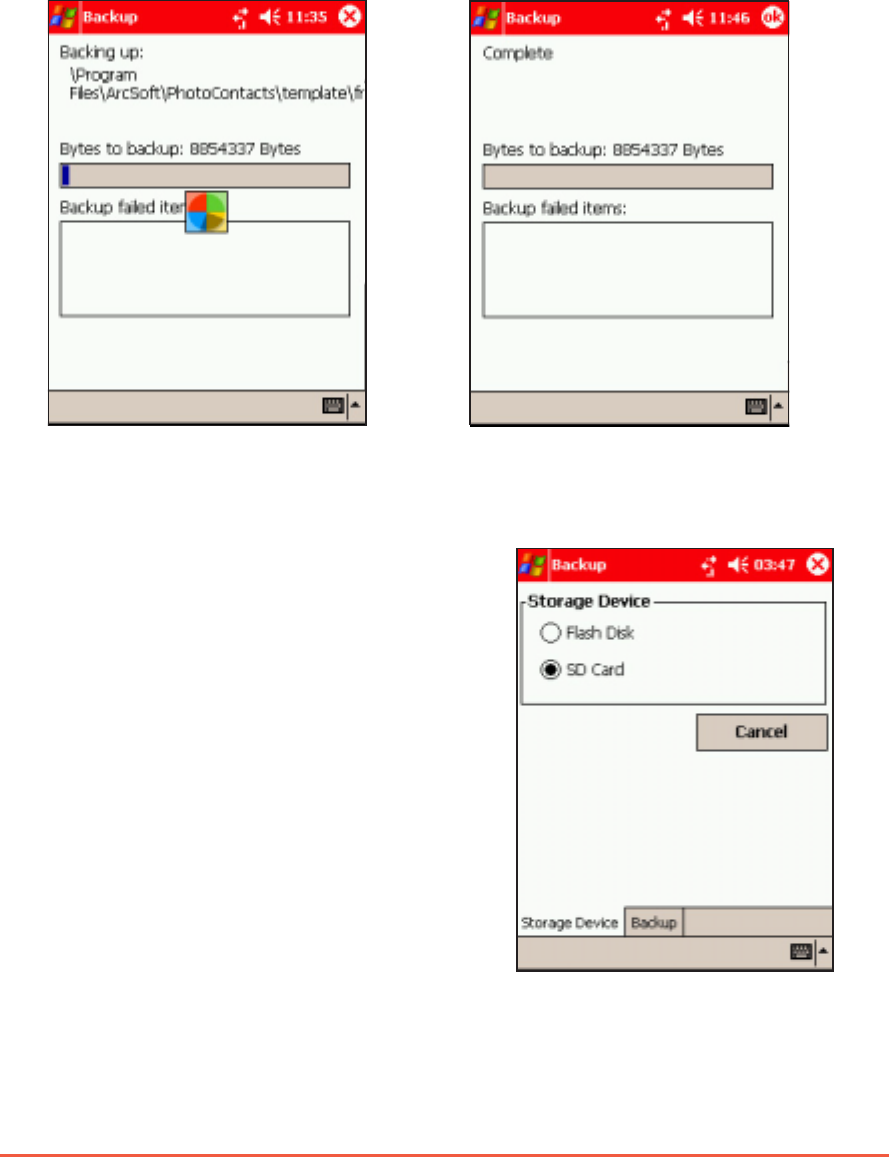
Chapter 2: Learning the Basics
2-33
6. The screen shows the status of the backup process. When done, a
message appears indicating that the backup is complete, and
shows the total size of the backed up files.
In case the program fails to back up any items, it will show the
items on the screen.
7. Tap OKOK
OKOK
OK.
To back up only PIM data on your device:To back up only PIM data on your device:
To back up only PIM data on your device:To back up only PIM data on your device:
To back up only PIM data on your device:
1. On the Backup screen, tap PIMPIM
PIMPIM
PIM
DataData
DataData
Da t a button to back up only
the personal information
management (PIM) data on your
device.
2. Select the storage device
(Flash DiskFlash Disk
Flash DiskFlash Disk
Flash Disk or SD cardSD card
SD cardSD card
SD card)
where you wish to save your
backup file.
Tapping CancelCancel
CancelCancel
Canc el returns you to
the previous screen.
3. Tap the BackupBackup
BackupBackup
Backup tab.
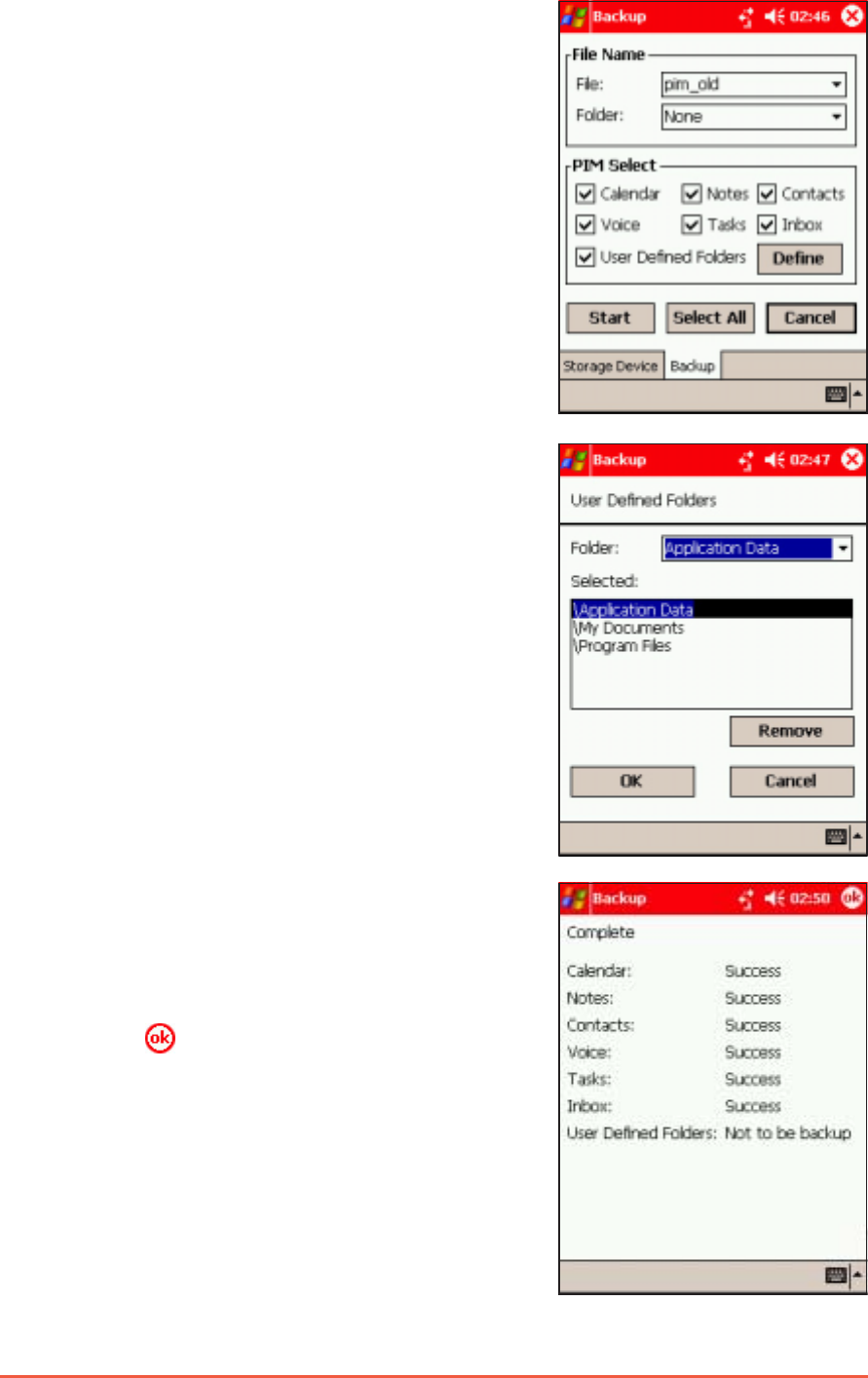
2-34
P505 Pocket PC
If you checked the box UserUser
UserUser
User
Defined FoldersDefined Folders
Defined FoldersDefined Folders
Defined Folders, tap DefineDefine
DefineDefine
Define
to specify the folders that you
wish to include in the backup
file, then tap OKOK
OKOK
OK.
6. Tap StartStart
StartStart
Sta rt to begin the backup
process.
7. When the backup process is
complete, the screen displays
the message “Complete” and a
list of all the backed up items.
8. Tap .
4. Type a name for your backup file
and the folder where you wish to
place it. You may opt not to
specify a folder.
5. Check the boxes opposite the
items that you wish to back up,
or tap Select All Select All
Select All Select All
Select All to select all
listed items.
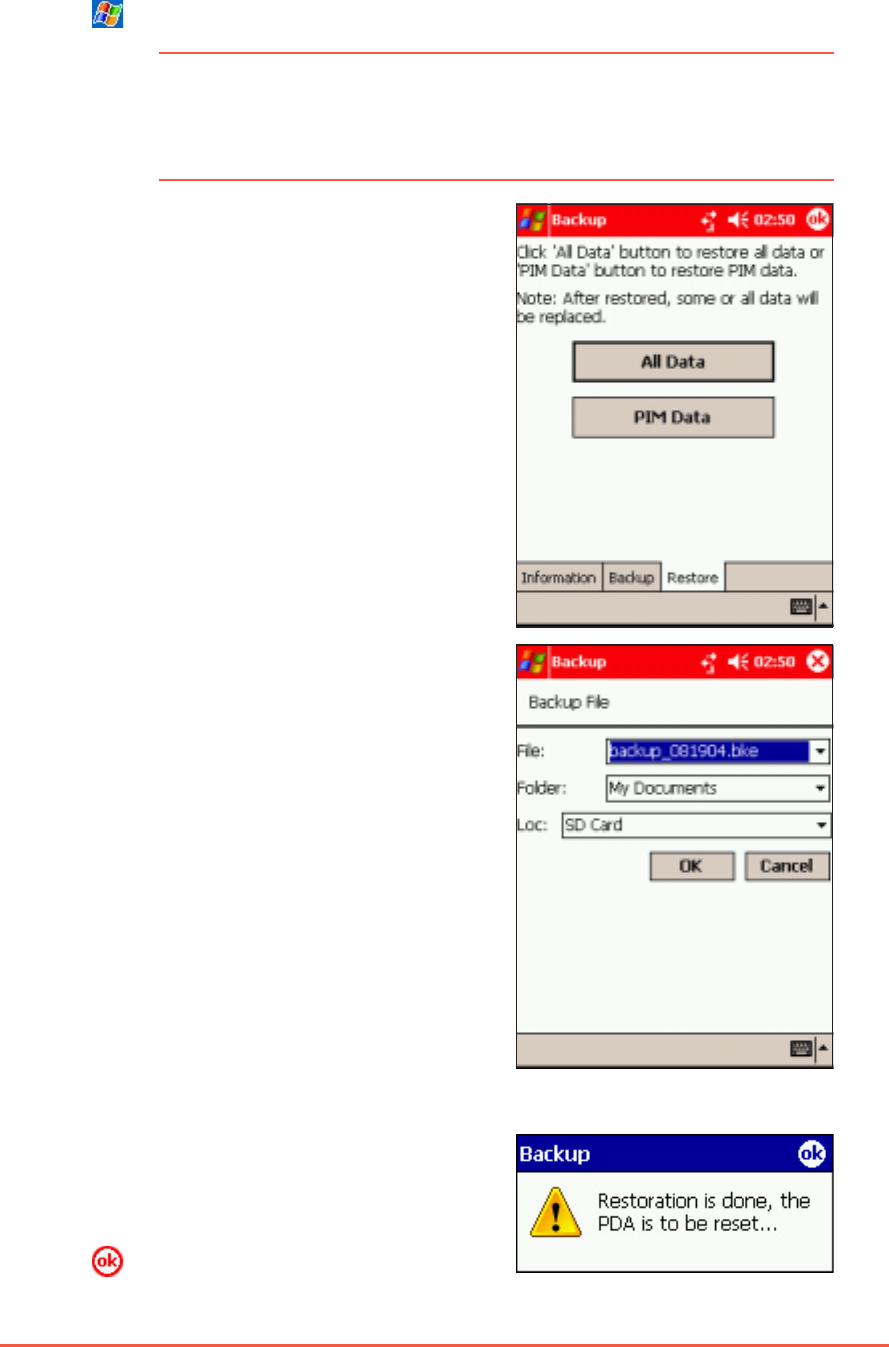
Chapter 2: Learning the Basics
2-35
To restore all data:To restore all data:
To restore all data:To restore all data:
To restore all data:
1. Tap , then tap ProgramsPrograms
ProgramsPrograms
Programs.
NOTENOTE
NOTENOTE
N O T E If you saved your backup file into an SD memory card, you
need to insert that SD memory card into the SD card slot
when restoring data. Otherwise, you will receive the message
“No storage devices are found!”
2. On the Programs screen, tap the
BackupBackup
BackupBackup
Backup icon.
When prompted, stop all running
programs.
3. Tap the RestoreRestore
RestoreRestore
Restore tab on the
Backup screen.
4. Tap All DataAll Data
All DataAll Data
All Data.
5. In the Backup File screen:
• select the backup file namefile name
file namefile name
file name
(tap the arrow to list down
other backup files, if any)
• select the folderfolder
folderfolder
folder that
contains your backup file
(optional)
• select the storage device
(Flash DiskFlash Disk
Flash DiskFlash Disk
Flash Disk or SD cardSD card
SD cardSD card
SD card)
where you stored your backup
file
6. Tap OKOK
OKOK
O K to start the restore
process.
7. When the restoration is done, a
message appears prompting you
to reset the device.
8. Tap to reset.
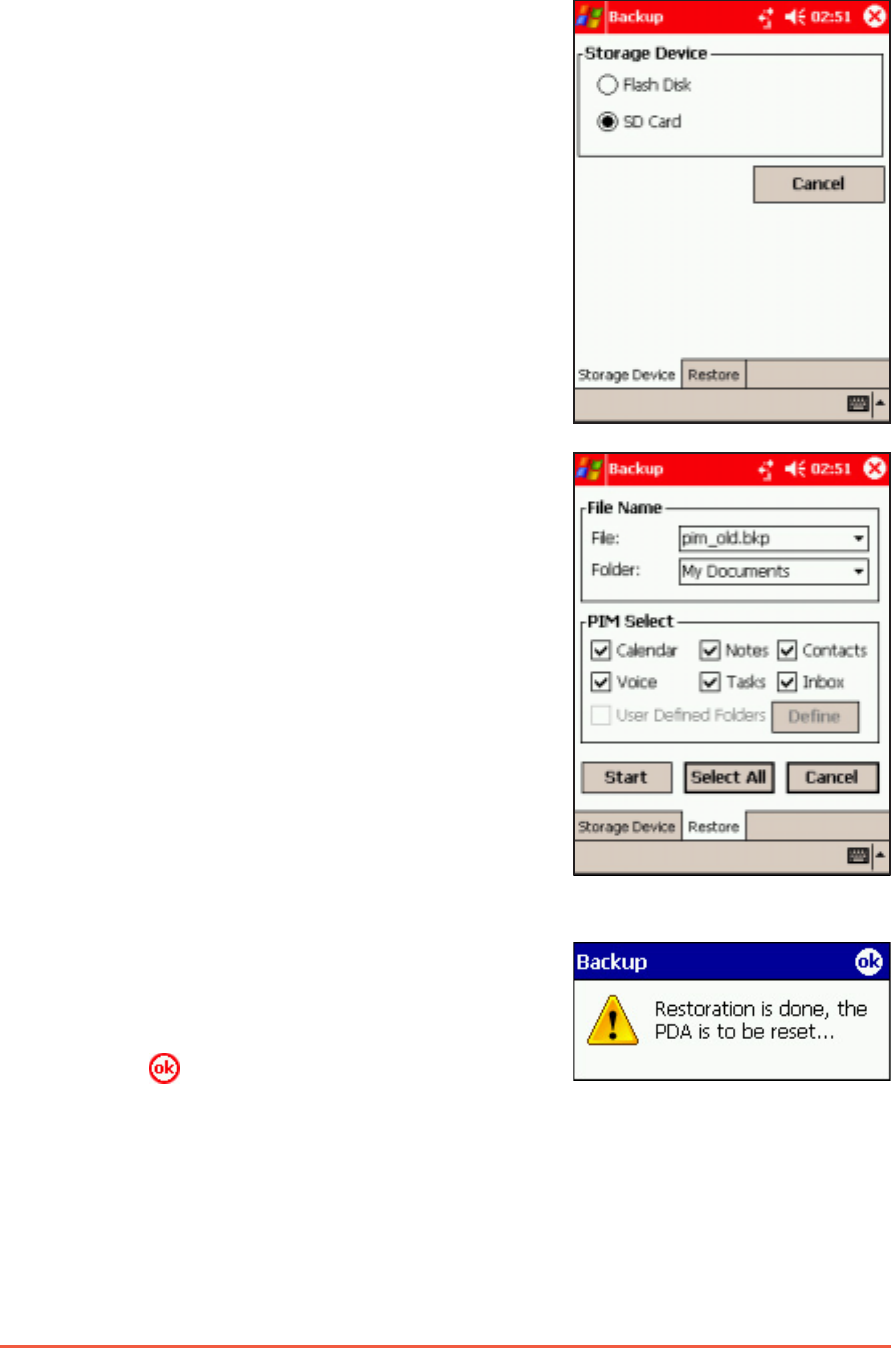
2-36
P505 Pocket PC
To restore PIM data:To restore PIM data:
To restore PIM data:To restore PIM data:
To restore PIM data:
1. On the Backup screen, tap PIMPIM
PIMPIM
PIM
DataData
DataData
Data.
2. When prompted, select the
storage device (Flash DiskFlash Disk
Flash DiskFlash Disk
Flash Disk or
SD cardSD card
SD cardSD card
SD card) where you stored
your backup file.
Tapping CancelCancel
CancelCancel
Canc el returns you to
the previous screen.
3. Tap the RestoreRestore
RestoreRestore
Restore tab.
4. Select the backup file namefile name
file namefile name
file name
(tap the arrow to list down other
backup files, if any).
5. Check the boxes opposite the
items that you wish to restore,
or tap Select All Select All
Select All Select All
Select All to select all
listed items.
If you checked the box UserUser
UserUser
User
Defined FoldersDefined Folders
Defined FoldersDefined Folders
Defined Folders, tap DefineDefine
DefineDefine
Define
to specify the folders that you
wish to restore, then tap OKOK
OKOK
OK.
6. Tap StartStart
StartStart
Sta rt to begin the restore
process.
7. When the restoration is done, a
message appears prompting you
to reset the device.
8. Tap to reset.
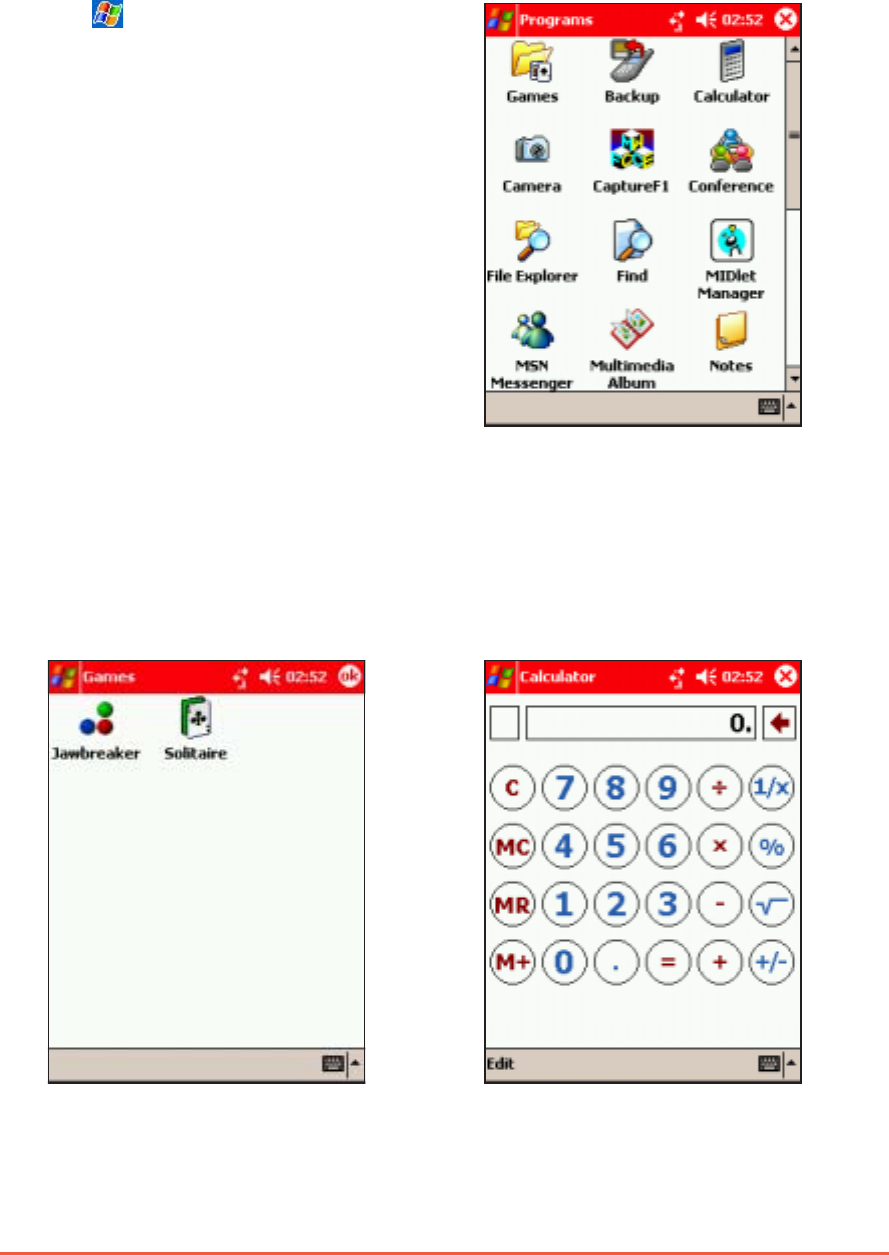
Chapter 2: Learning the Basics
2-37
Other applicationsOther applications
Other applicationsOther applications
Other applications
Your device includes the most common Windows
®
applications and
more.
To access programs:To access programs:
To access programs:To access programs:
To access programs:
1. Tap , then tap ProgramsPrograms
ProgramsPrograms
Programs.
2. Tap any of the icons to
launch a specific application
program.
GamesGames
GamesGames
Games
Tap the GamesGames
GamesGames
Games icon to display
the available games.
CalculatorCalculator
CalculatorCalculator
Calculator
Tap the CalculatorCalculator
CalculatorCalculator
Calculator icon to use
the calculator.
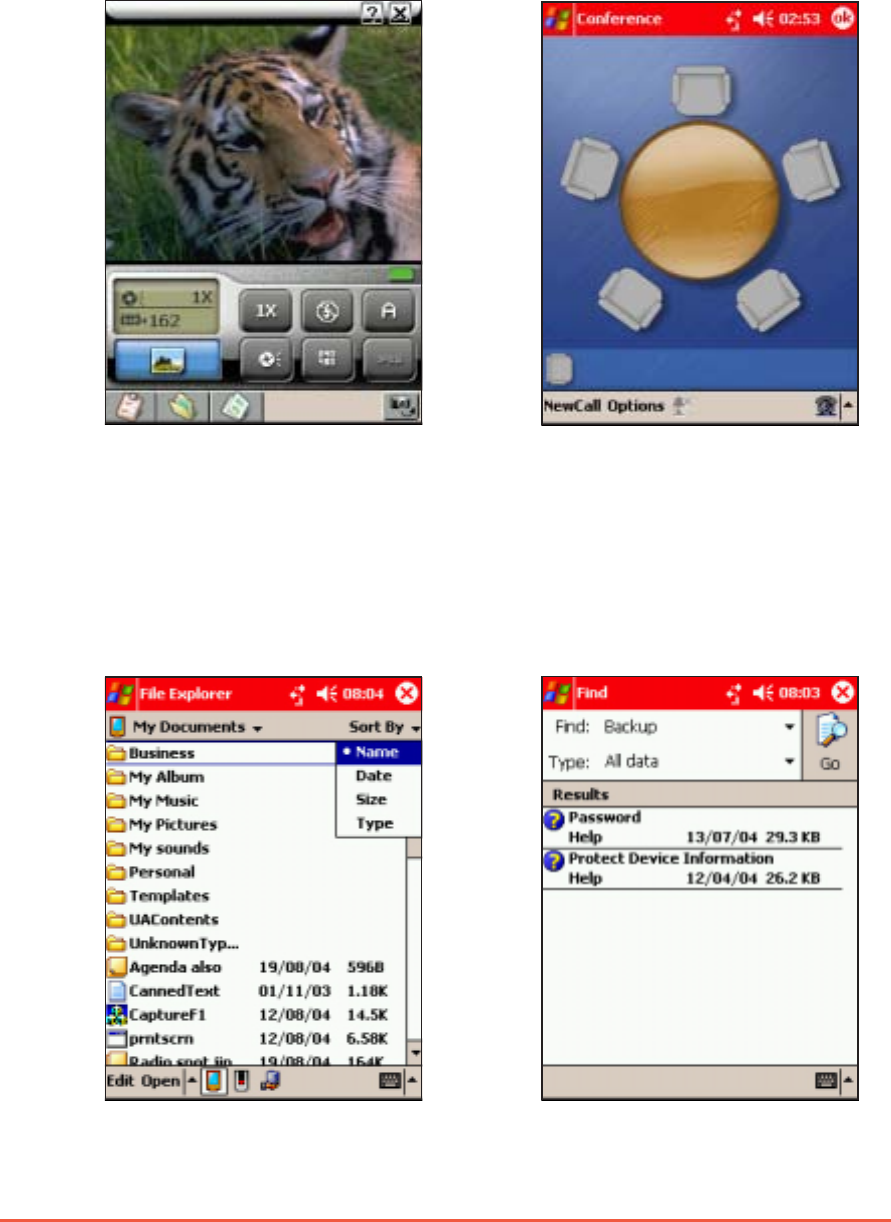
2-38
P505 Pocket PC
File ExplorerFile Explorer
File ExplorerFile Explorer
File Explorer
Tap the File Explorer File Explorer
File Explorer File Explorer
File Explorer icon to
access or find your files. See
page 2-19 for details.
FindFind
FindFind
Find
Tap the FindFind
FindFind
Find icon to find files,
folders, or programs in your Pocket
PC. See page 2-18 for details.
CameraCamera
CameraCamera
Camera
Tap the CameraCamera
CameraCamera
Camera icon to launch
and use the built-in camera. Refer
to the “Camera” section for
details.
ConferenceConference
ConferenceConference
Conference
Tap the ConferenceConference
ConferenceConference
Conference icon to
start a call conference. Refer to
the “Phone” section for details.
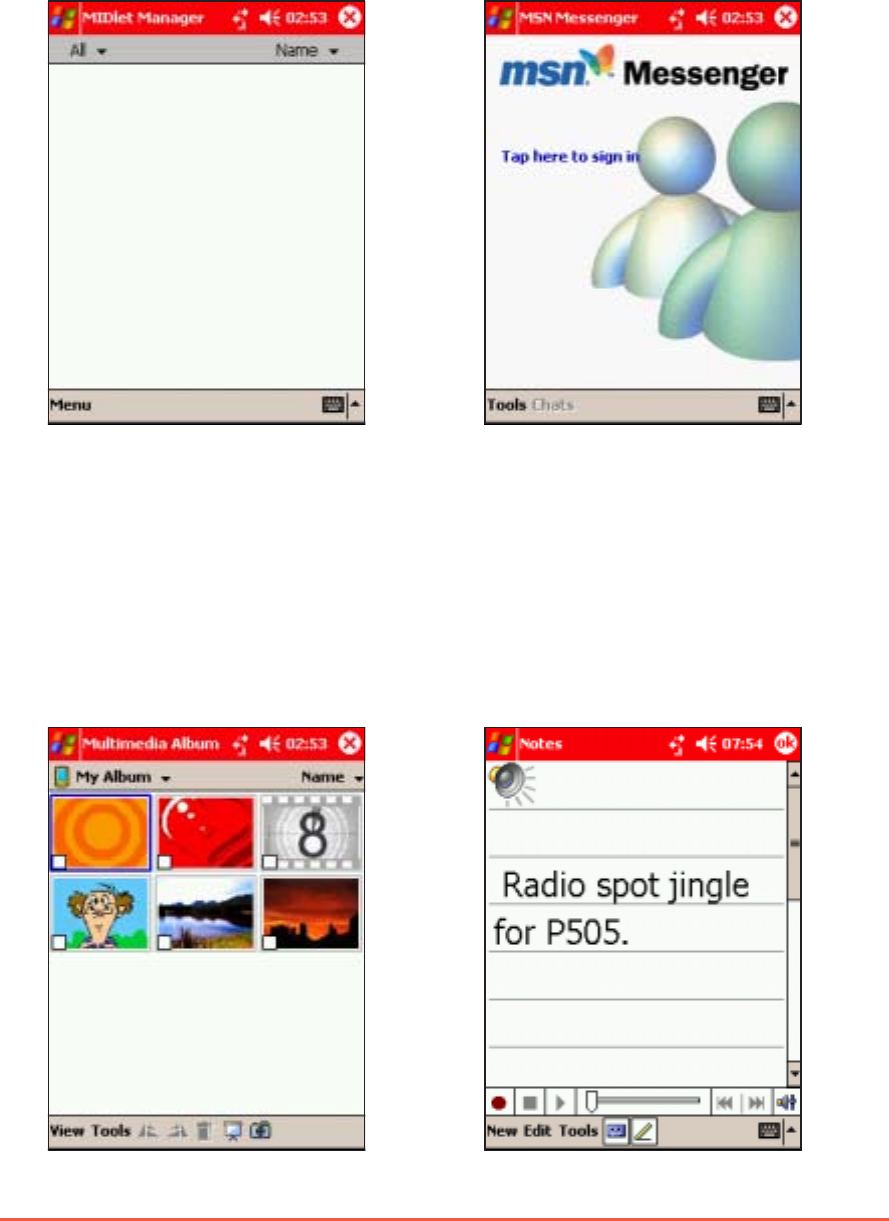
Chapter 2: Learning the Basics
2-39
MIDlet ManagerMIDlet Manager
MIDlet ManagerMIDlet Manager
MIDlet Manager
Tap the MIDlet Manager MIDlet Manager
MIDlet Manager MIDlet Manager
MIDlet Manager icon
to install, run, or display Java
programs and applications.
MSN MessengerMSN Messenger
MSN MessengerMSN Messenger
MSN Messenger
Tap the MSN Messenger MSN Messenger
MSN Messenger MSN Messenger
MSN Messenger icon
to set up the MSN Messenger.
Multimedia AlbumMultimedia Album
Multimedia AlbumMultimedia Album
Multimedia Album
The Multimedia Album Multimedia Album
Multimedia Album Multimedia Album
Multimedia Album allows
you to explore, display, or send
photos, graphics, audio, and
animations via e-mail, MMS, or
beam.
NotesNotes
NotesNotes
Notes
The NotesNotes
NotesNotes
Not es window allows you to
create or record notes and send
them via e-mail or beam.
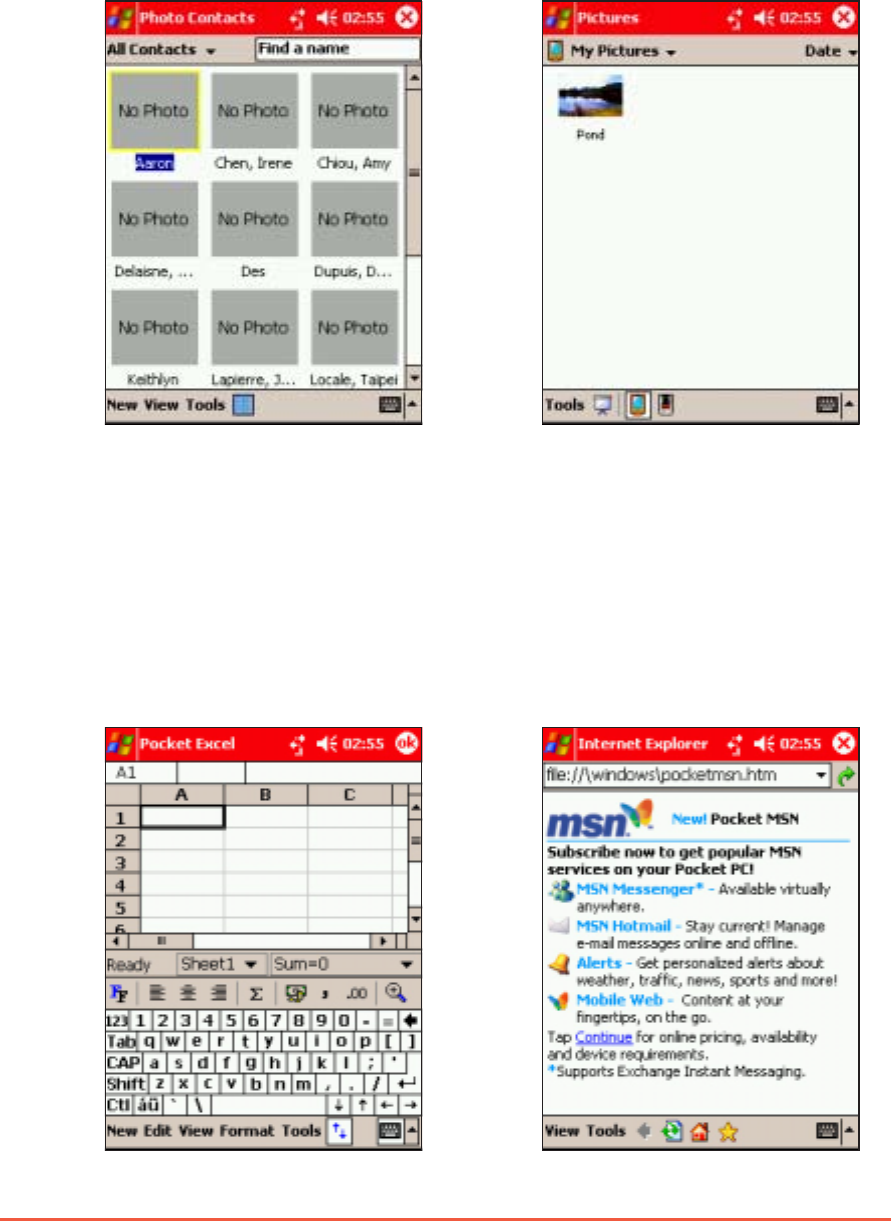
2-40
P505 Pocket PC
Photo ContactsPhoto Contacts
Photo ContactsPhoto Contacts
Photo Contacts
The Photo Contacts Photo Contacts
Photo Contacts Photo Contacts
Photo Contacts window
allows you to add photos to
contacts saved in your device or
SIM phonebook.
PicturesPictures
PicturesPictures
Pictures
This window allows you to view,
edit, and manage pictures saved
in your Pocket PC or SD memory
card.
Pocket ExcelPocket Excel
Pocket ExcelPocket Excel
Pocket Excel
The Pocket Excel Pocket Excel
Pocket Excel Pocket Excel
Pocket Excel application
allows you to create
spreadsheets in your Pocket PC.
Pocket MSNPocket MSN
Pocket MSNPocket MSN
Pocket MSN
The Pocket MSN Pocket MSN
Pocket MSN Pocket MSN
Pocket MSN allows you to
browse Internet pages and
connect to the Pocket MSN
website.
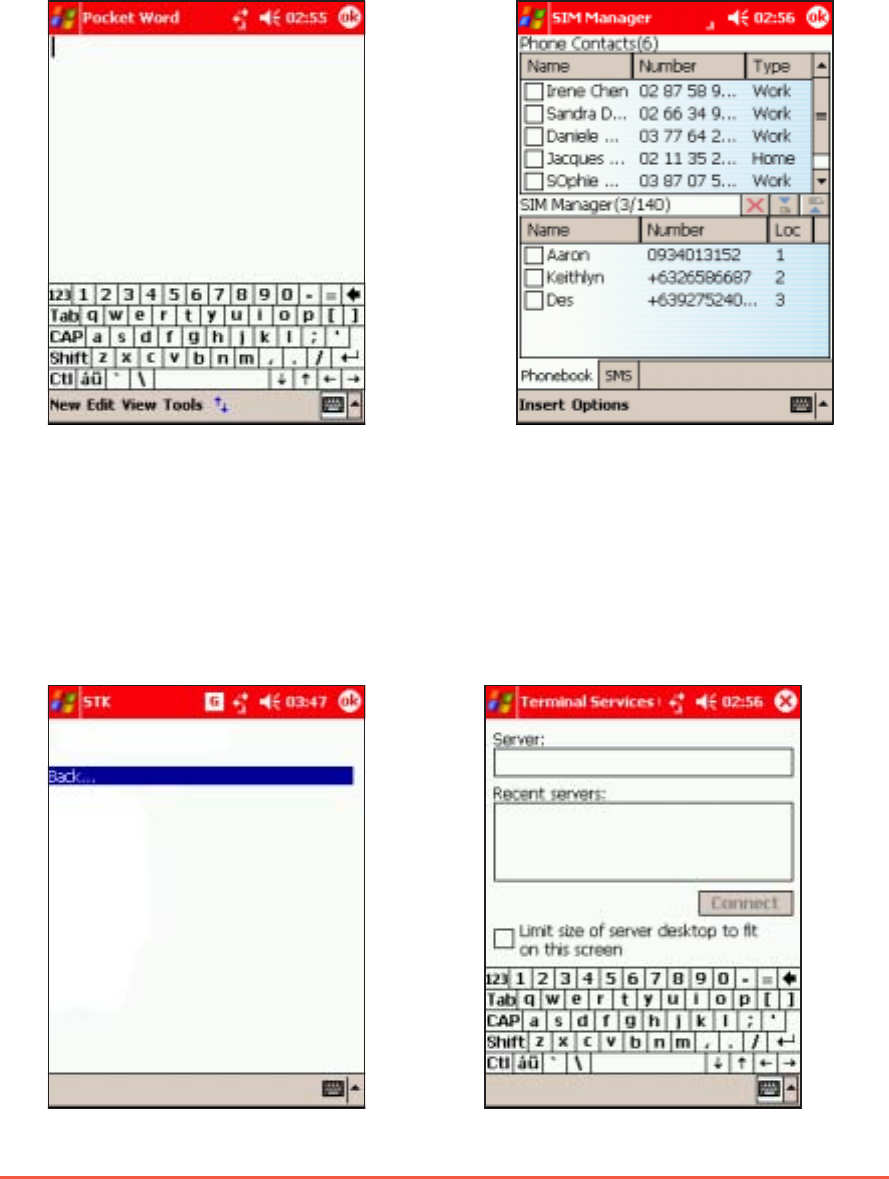
Chapter 2: Learning the Basics
2-41
Pocket WordPocket Word
Pocket WordPocket Word
Pocket Word
The Pocket Word Pocket Word
Pocket Word Pocket Word
Pocket Word application is
the PDA version of the
Microsoft
®
Word. Use this
application to create, share, or
send documents.
SIM ManagerSIM Manager
SIM ManagerSIM Manager
SIM Manager
The SIM ManagerSIM Manager
SIM ManagerSIM Manager
SIM Manager application
allows you to view, add, and
manage contacts in your device
or SIM phone book.
STKSTK
STKSTK
STK
The STKSTK
STKSTK
S T K window displays the
value-added services offered by
your phone operator.
Terminal ServicesTerminal Services
Terminal ServicesTerminal Services
Terminal Services
The Terminal Services ClientTerminal Services Client
Terminal Services ClientTerminal Services Client
Terminal Services Client
allows you to connect to a
terminal server.
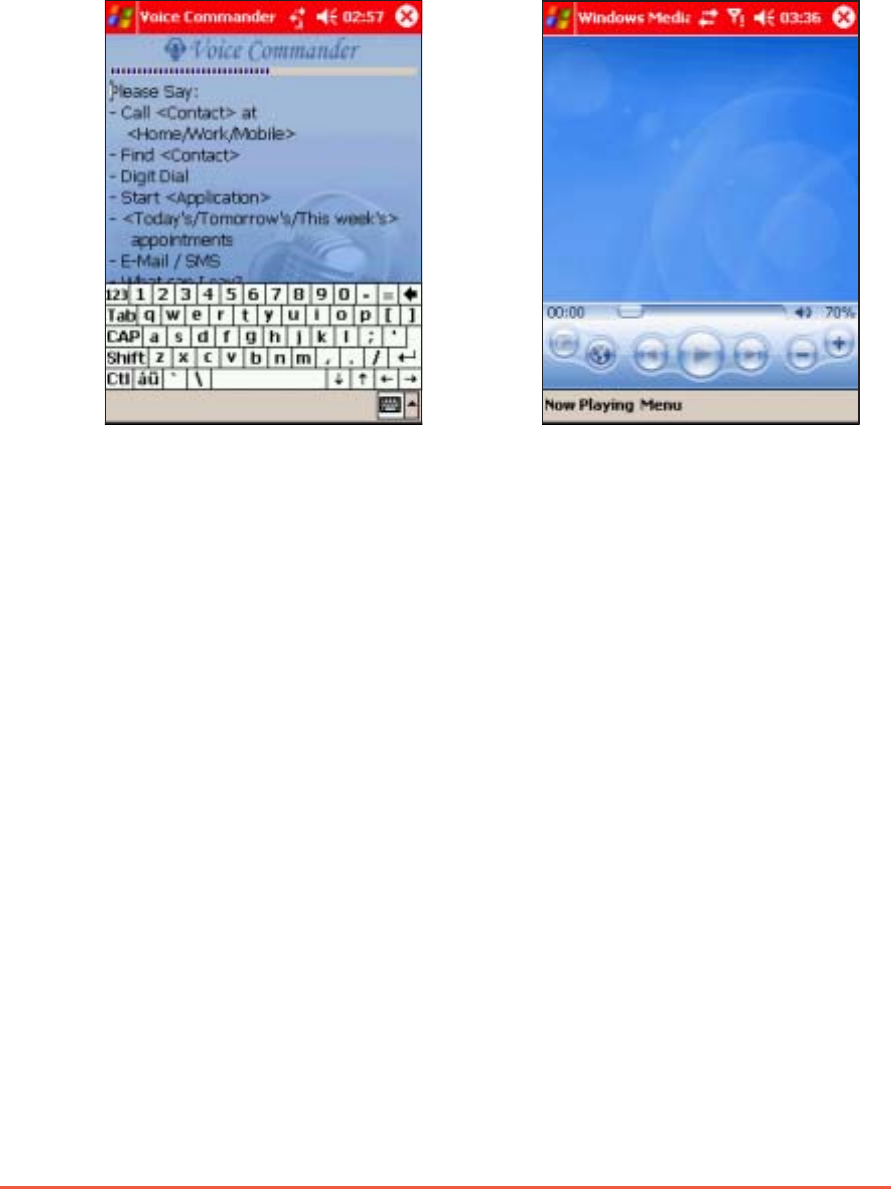
2-42
P505 Pocket PC
Windows MediaWindows Media
Windows MediaWindows Media
Windows Media
The Windows Media PlayerWindows Media Player
Windows Media PlayerWindows Media Player
Windows Media Player
allows you to play video and
audio files on your Pocket PC.
Voice RecognitionVoice Recognition
Voice RecognitionVoice Recognition
Voice Recognition
Tap the Voice RecognitionVoice Recognition
Voice RecognitionVoice Recognition
Voice Recognition
icon to launch the Voice
Commander application that
allows you to record voice
commands.

Chapter 2: Learning the Basics
2-43
Adding or removing programsAdding or removing programs
Adding or removing programsAdding or removing programs
Adding or removing programs
Programs added to your device at the factory are stored in ROM
(Read-Only Memory). You cannot remove this software, and you will
never accidentally lose ROM contents. ROM programs can be updated
using installation programs with a *.xip extension. All other programs
and data files added to your device after factory installation are
stored in RAM (Random Access Memory).
You can install any program created for your device, as long as it has
enough memory. The place to find software for your device is on the
Pocket PC web site (http://www.microsoft.com/mobile/pocketpc).
To add programs using ActiveSync:To add programs using ActiveSync:
To add programs using ActiveSync:To add programs using ActiveSync:
To add programs using ActiveSync:
NOTENOTE
NOTENOTE
N O T E You need to install the Microsoft ActiveSync on your desktop
computer before you can synchronise and/or add programs
to your device. Refer to “Chapter 5: Microsoft ActiveSync”
for installation instructions.
1. Determine your device and processor type so that you know
which version of the software to install. Tap , then tap
SettingsSettings
SettingsSettings
Settings. On the SystemSystem
SystemSystem
System tab, tap AboutAbout
AboutAbout
About. In the VersionVersion
VersionVersion
Version tab,
take note of the information in ProcessorProcessor
ProcessorProcessor
Processor.
2. Download the program to your desktop computer (or insert the
CD that contains the program into your desktop computer). You
may see a single *.xip*.xip
*.xip*.xip
*.xip, *.exe*.exe
*.exe*.exe
*.exe, or *.zip*.zip
*.zip*.zip
*. z ip file, a Setup.exeSetup.exe
Setup.exeSetup.exe
Setup.exe file, or
several versions of files for different device types and processors.
Be sure to select the program designed for the Pocket PC and
your device processor type.
3. Read any installation instructions, Read Me Read Me
Read Me Read Me
Read Me files, or
documentation that comes with the program. Many programs
provide special installation instructions.
4. Connect your device to your desktop computer.

2-44
P505 Pocket PC
5. Double-click the *.exe file.
• If the file is an installer, the installation wizard begins. Follow
the directions on the screen. Once the software is installed on
your desktop computer, the installer automatically transfers
the software to your device.
• If the file is not an installer, you will see an error message
stating that the program is valid but it is designed for a
different type of computer. You need to move this file to your
device. If you cannot find any installation instructions for the
program in the Read Me Read Me
Read Me Read Me
Read Me file or documentation, use
ActiveSync Explore ActiveSync Explore
ActiveSync Explore ActiveSync Explore
ActiveSync Explore to copy the program file to the
Program Files Program Files
Program Files Program Files
Program Files folder on your device. For more information
on copying files using ActiveSyncActiveSync
ActiveSyncActiveSync
ActiveSync, see ActiveSync HelpActiveSync Help
ActiveSync HelpActiveSync Help
ActiveSync Help.
6. When the installation is complete, tap , ProgramsPrograms
ProgramsPrograms
Programs, and the
program icon to switch to it.
To add a program directly from the Internet:To add a program directly from the Internet:
To add a program directly from the Internet:To add a program directly from the Internet:
To add a program directly from the Internet:
NOTENOTE
NOTENOTE
N O T E You need to be connected to the Internet through an optional
modem card or network card before you can add programs
directly from the Internet.
1. Determine your device and processor type so that you know
which version of the software to install. Tap , then tap
SettingsSettings
SettingsSettings
Settings. On the System tab, tap AboutAbout
AboutAbout
About. In the VersionVersion
VersionVersion
Version tab,
take note of the information in ProcessorProcessor
ProcessorProcessor
Processor.
2. Download the program to your device straight from the Internet
using the Pocket Internet ExplorerPocket Internet Explorer
Pocket Internet ExplorerPocket Internet Explorer
Pocket Internet Explorer. You may see a single
*.xip*.xip
*.xip*.xip
*.xip, *.exe*.exe
*.exe*.exe
*.exe, or *.zip*.zip
*.zip*.zip
*. z ip file, a Setup.exeSetup.exe
Setup.exeSetup.exe
Setup.exe file, or several versions
of files for different device types and processors. Be sure to
select the program designed for the Pocket PC and your device
processor type.
3. Read any installation instructions, Read Me Read Me
Read Me Read Me
Read Me files, or
documentation that comes with the program. Many programs
provide special installation instructions.
4. Tap the file, such as a *.xip*.xip
*.xip*.xip
*.xip or *.exe*.exe
*.exe*.exe
*. exe file. The installation wizard
begins. Follow the directions on the screen.

Chapter 2: Learning the Basics
2-45
To add a program to the Start menu:To add a program to the Start menu:
To add a program to the Start menu:To add a program to the Start menu:
To add a program to the Start menu:
1. Tap , tap SettingsSettings
SettingsSettings
Settings, tap MenusMenus
MenusMenus
Me n us, tap the Start MenuStart Menu
Start MenuStart Menu
Start Menu tab, and
tap the check box for the program. If you do not see the program
on the list, you can either use File Explorer File Explorer
File Explorer File Explorer
File Explorer on the device to
move the program to the Start Menu Start Menu
Start Menu Start Menu
Start Menu folder, or use
ActiveSyncActiveSync
ActiveSyncActiveSync
ActiveSync on the desktop computer to create a shortcut to
the program and place the shortcut in the Start Menu Start Menu
Start Menu Start Menu
Start Menu folder.
2. If you are using the File Explorer File Explorer
File Explorer File Explorer
File Explorer on the device:
a. Tap , tap ProgramsPrograms
ProgramsPrograms
Programs, tap File ExplorerFile Explorer
File ExplorerFile Explorer
File Explorer, and locate the
program (tap the folder list, labeled My Documents by default,
then tap My Device to see a list of all the folders on the
device).
b. Tap and hold the program, then tap CutCut
CutCut
Cut on the pop-up menu.
Open the Start Menu Start Menu
Start Menu Start Menu
Start Menu folder located in the WindowsWindows
WindowsWindows
Windows folder,
tap and hold a blank area of the window, then tap PastePaste
PastePaste
Paste in
the pop-up menu.
c. The program now appears on the menu. For more
information on using the File ExplorerFile Explorer
File ExplorerFile Explorer
File Explorer, see the section
“Finding and organising information” earlier in this chapter.
3. If you are using ActiveSyncActiveSync
ActiveSyncActiveSync
ActiveSync on the desktop computer:
a. Use the ExplorerExplorer
ExplorerExplorer
Explorer in ActiveSyncActiveSync
ActiveSyncActiveSync
ActiveSync to explore your device files
and locate the program. Right-click the program, then click
Create ShortcutCreate Shortcut
Create ShortcutCreate Shortcut
Create Shortcut.
b. Move the shortcut to the Start Menu Start Menu
Start Menu Start Menu
Start Menu folder in the WindowsWindows
WindowsWindows
Windows
folder. The shortcut now appears on the menu. For more
information, see ActiveSync HelpActiveSync Help
ActiveSync HelpActiveSync Help
ActiveSync Help.
To remove a program from the Start menu:To remove a program from the Start menu:
To remove a program from the Start menu:To remove a program from the Start menu:
To remove a program from the Start menu:
1. Tap , then tap SettingsSettings
SettingsSettings
Settings. On the SystemSystem
SystemSystem
Sys tem tab, tap RemoveRemove
RemoveRemove
Remove
ProgramsPrograms
ProgramsPrograms
Programs.
2. If the program does not appear in the list of installed programs,
use File Explorer File Explorer
File Explorer File Explorer
File Explorer on your device to locate the program, tap and
hold the program, then tap DeleteDelete
DeleteDelete
Delete on the pop-up menu.

2-46
P505 Pocket PC

Chapter 3
Synchronising Data
This chapter tells you how to
use the Microsoft
®
ActiveSync
®
application that synchronises
data between your Pocket PC
and your desktop or notebook
computer.

3-2
P505 Pocket PC
Chapter summaryChapter summary
Chapter summaryChapter summary
Chapter summary
••
••
•IntroductionIntroduction
IntroductionIntroduction
Introduction ................................................................................................
................................................................................................
................................................ 3-23-2
3-23-2
3-2
What is ActiveSync
®
? ...................................................... 3-2
••
••
•Installing ActiveSyncInstalling ActiveSync
Installing ActiveSyncInstalling ActiveSync
Installing ActiveSync
®®
®®
®
....................................................................
....................................................................
.................................. 3-33-3
3-33-3
3-3
Installing ActiveSync
®
on your computer ......................... 3-3
••
••
•Synchronising your deviceSynchronising your device
Synchronising your deviceSynchronising your device
Synchronising your device ........................................................
........................................................
............................ 3-53-5
3-53-5
3-5
Connecting your device to a computer ............................ 3-5
Setting up a partnership .................................................. 3-6
Checking synchronised information .................................. 3-8
Manually initiating synchronisation ................................... 3-9
Synchronisation options ................................................. 3-10

Chapter 3: Synchronising Data
3-3
IntroductionIntroduction
IntroductionIntroduction
Introduction
What is ActiveSyncWhat is ActiveSync
What is ActiveSyncWhat is ActiveSync
What is ActiveSync
®®
®®
®
??
??
?
The Microsoft
®
ActiveSync
®
is one of the most important bundled
programs in your Pocket PC. With ActiveSync
®
, you can synchronise
the information on your desktop computer with the information on
your device. Synchronisation compares the data on your device with
your desktop computer and updates both computers with the most
recent information.
For example:For example:
For example:For example:
For example:
• Keep Pocket Outlook data up-to-date by synchronising your Pocket
PC with Microsoft
®
Outlook data on your desktop computer.
• Synchronise Microsoft
®
Word and Microsoft
®
Excel files between
your device and desktop computer. Your files are automatically
converted to the correct format.
NOTENOTE
NOTENOTE
N O T E By default, ActiveSync® does not automatically synchronise
all types of information. Use the ActiveSync® options to turn
synchronisation on or off for specific information types.
With ActiveSyncWith ActiveSync
With ActiveSyncWith ActiveSync
With ActiveSync®®
®®
®, you can also:, you can also:
, you can also:, you can also:
, you can also:
• Back up and restore your device data
• Copy (rather than synchronise) files between your device and
desktop computer
• Schedule data synchronisation by selecting a synchronisation
mode. For example, you can synchronise continually while
connected to your desktop computer or only when you choose to
synchronise.
• Select which information types are synchronised and control how
much data is synchronised. For example, you can choose to
synchronise your appointments of the past two weeks only,
appointments older than two weeks are not synchronised.
For more information about using ActiveSyncFor more information about using ActiveSync
For more information about using ActiveSyncFor more information about using ActiveSync
For more information about using ActiveSync®®
®®
®::
::
:
1. Start ActiveSync
®
on your desktop computer.
2. From the Activesync
®
menu bar, click HelpHelp
HelpHelp
Help then on MicrosoftMicrosoft
MicrosoftMicrosoft
Microsoft
ActiveSync HelpActiveSync Help
ActiveSync HelpActiveSync Help
ActiveSync Help.
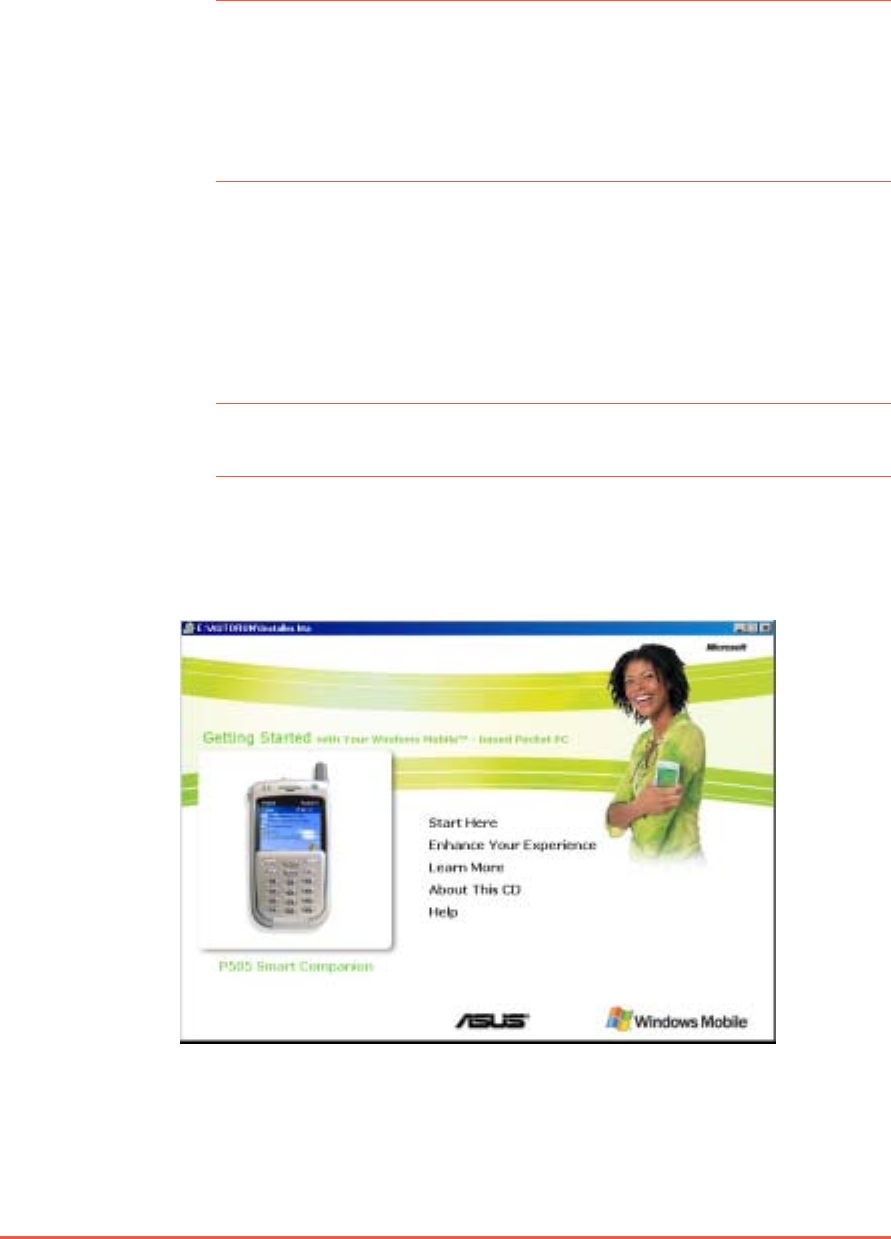
3-4
P505 Pocket PC
Installing ActiveSyncInstalling ActiveSync
Installing ActiveSyncInstalling ActiveSync
Installing ActiveSync®®
®®
®
The ActiveSync
®
application is already installed on your Pocket PC. To
synchronise information on your device with your computer, you
must also install ActiveSync
®
on your computer. Install ActiveSync
®
from the Companion CD that came with your device.
NOTENOTE
NOTENOTE
N O T E Before starting the ActiveSync® installation, make sure that
you have Microsoft® Outlook® installed on your computer. If
you do not have Outlook, install the Microsoft® Outlook®
2002 from the Companion CD. Even if you have Outlook 98
or Outlook 2000 installed, you are encouraged to update to
Outlook 2002.
2. Click Start HereStart Here
Start HereStart Here
Start Here from the Main Menu to begin.
Installing ActiveSyncInstalling ActiveSync
Installing ActiveSyncInstalling ActiveSync
Installing ActiveSync
®®
®®
®
on your computer on your computer
on your computer on your computer
on your computer
To install ActiveSyncTo install ActiveSync
To install ActiveSyncTo install ActiveSync
To install ActiveSync
®®
®®
® on your computer: on your computer:
on your computer: on your computer:
on your computer:
NOTENOTE
NOTENOTE
N O T E Do not connect the Pocket PC to your computer until you
have finished installing ActiveSync®.
1. Insert the Companion CD into your computer. The CD autoruns
and displays the initial screen, then the Main Menu from which you
can start the installation.
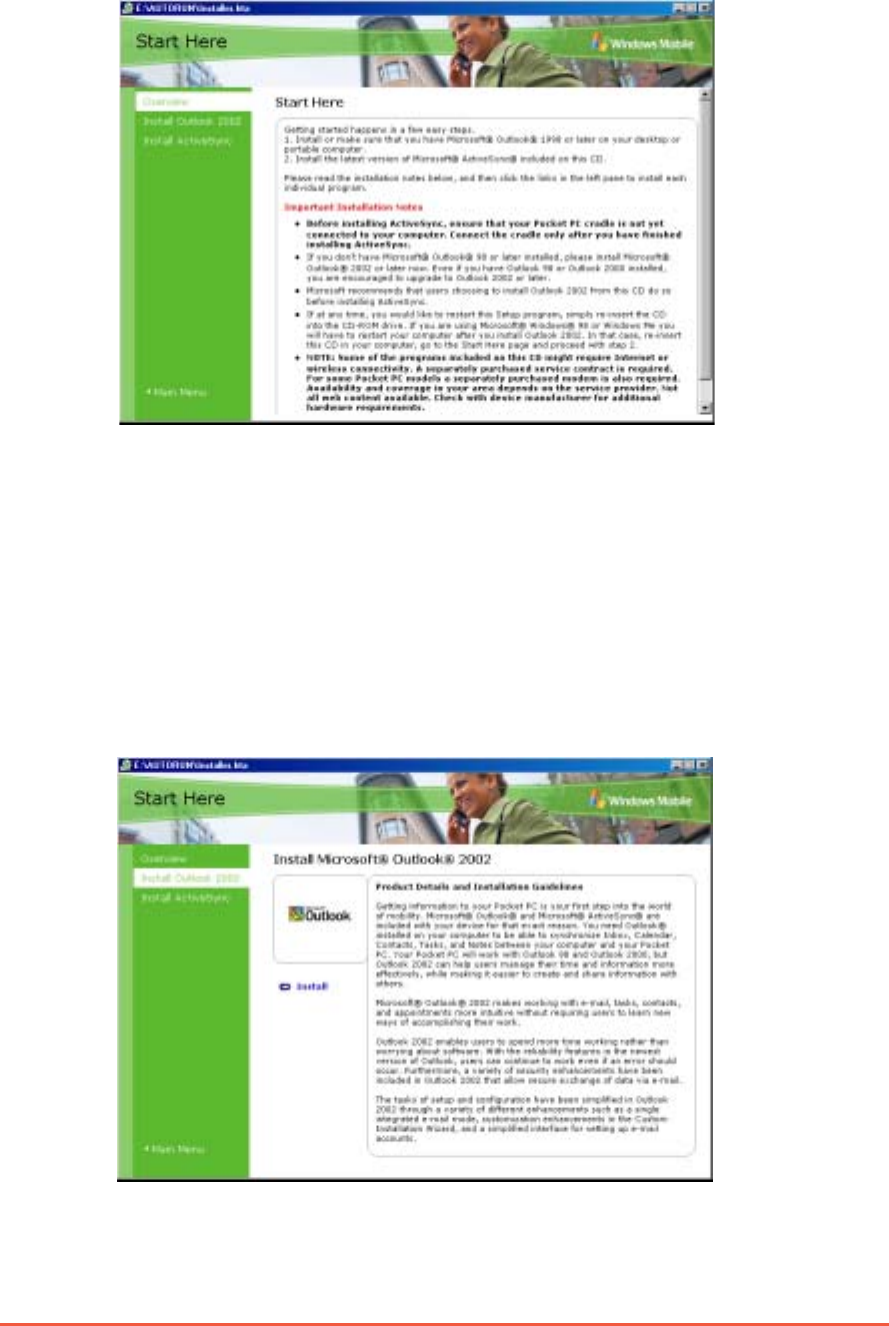
Chapter 3: Synchronising Data
3-5
3. Read the OverviewOverview
OverviewOverview
Overview before installing ActiveSync
®
3.7 to make
sure that you perform the installation sequence correctly.
4. If you have not installed Outlook, install it now. Click InstallInstall
InstallInstall
Install
Outlook 2002Outlook 2002
Outlook 2002Outlook 2002
Outlook 2002 and follow the screen instructions to complete
the installation.
5. Click Download Connection WizardDownload Connection Wizard
Download Connection WizardDownload Connection Wizard
Download Connection Wizard and read the overview to
see if you require the wizard. Follow the screen instructions to
install the wizard on your computer. Return to the Main Menu
when done.
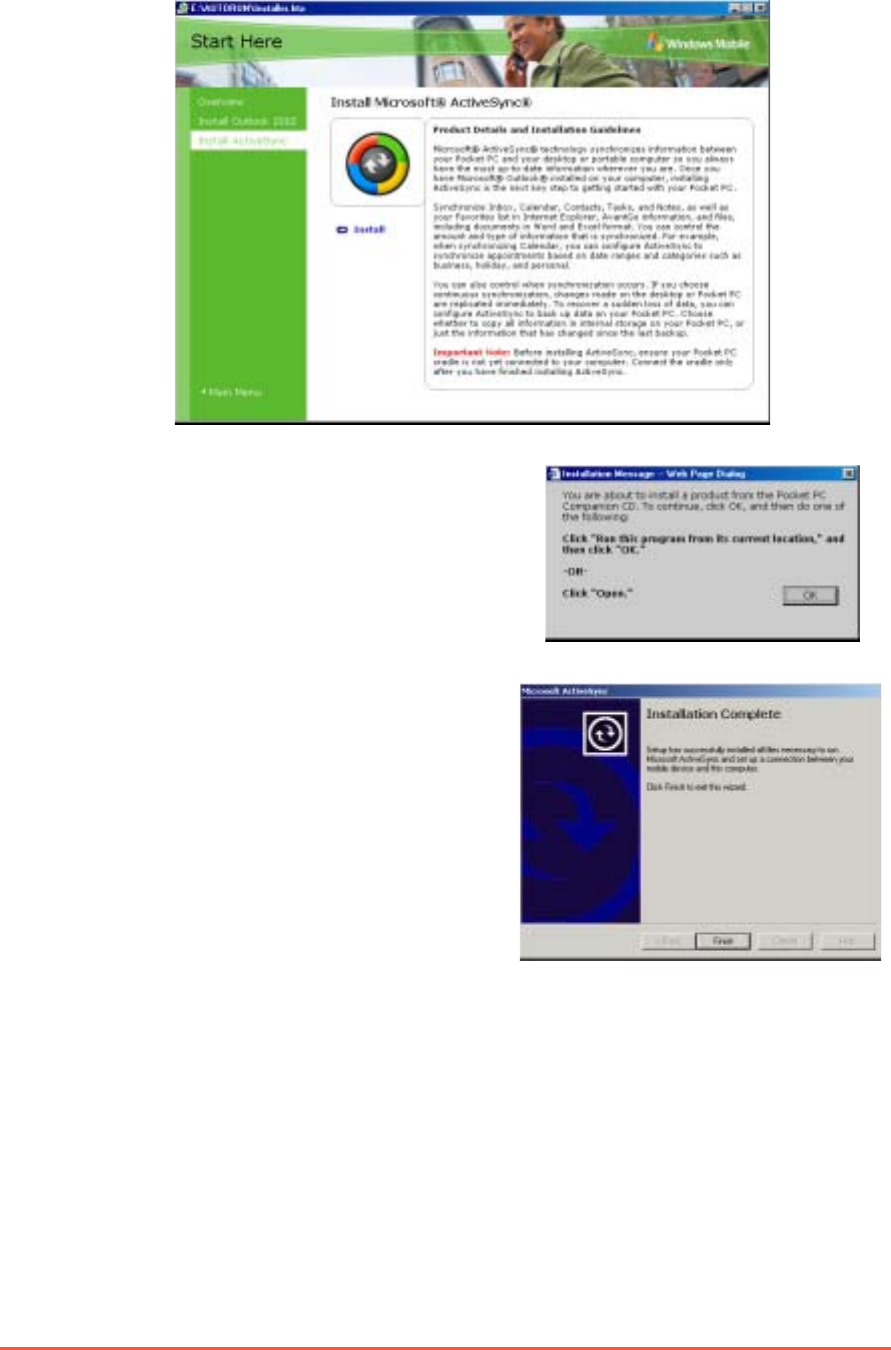
3-6
P505 Pocket PC
7. When prompted, select RunRun
RunRun
Run
this program from itsthis program from its
this program from itsthis program from its
this program from its
current locationcurrent location
current locationcurrent location
current location then click
OKOK
OKOK
OK.
8. Follow the succeeding screen
instructions. Click FinishFinish
FinishFinish
Finish to
complete the installation.
9. Restart Windows
®
when
prompted, then proceed to the
next section to connect your
device to your computer and
start synchronisation.
6. Click Install ActiveSyncInstall ActiveSync
Install ActiveSyncInstall ActiveSync
Install ActiveSync
®
3.7 3.7
3.7 3.7
3 . 7, then click InstallInstall
InstallInstall
Install.
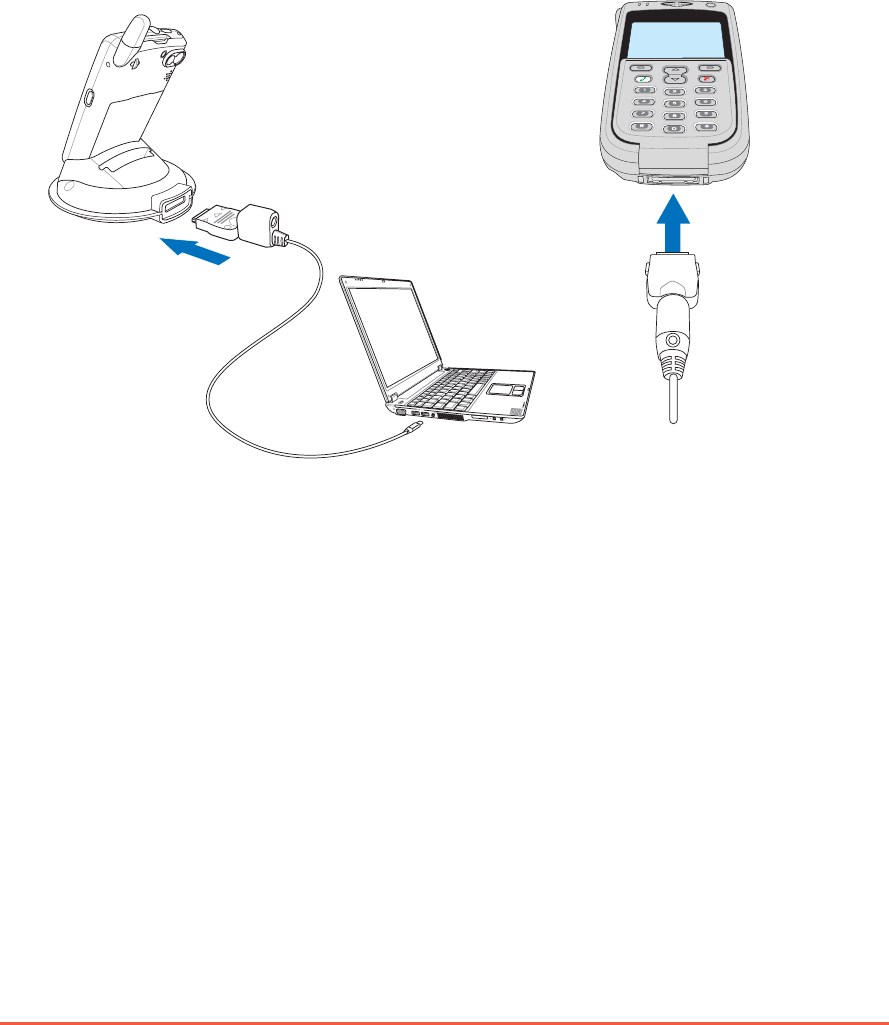
Chapter 3: Synchronising Data
3-7
Synchronising your deviceSynchronising your device
Synchronising your deviceSynchronising your device
Synchronising your device
Connecting your device to a computerConnecting your device to a computer
Connecting your device to a computerConnecting your device to a computer
Connecting your device to a computer
To connect your device to your computer:To connect your device to your computer:
To connect your device to your computer:To connect your device to your computer:
To connect your device to your computer:
1. Place the device on the cradle.
2. Connect the power/USB sync cable plug to the connector at the
back of the cradle.
3. Connect the other end of the power/USB sync cable to a USB port
on your computer. See Figure 1.
To connect your device without the cradle:To connect your device without the cradle:
To connect your device without the cradle:To connect your device without the cradle:
To connect your device without the cradle:
1. Connect the power/USB sync cable plug to the connector at the
bottom of the device.
2. Connect the other end of the cable to an available USB port on
your computer. See Figure 2.
Figure 1
Figure 2
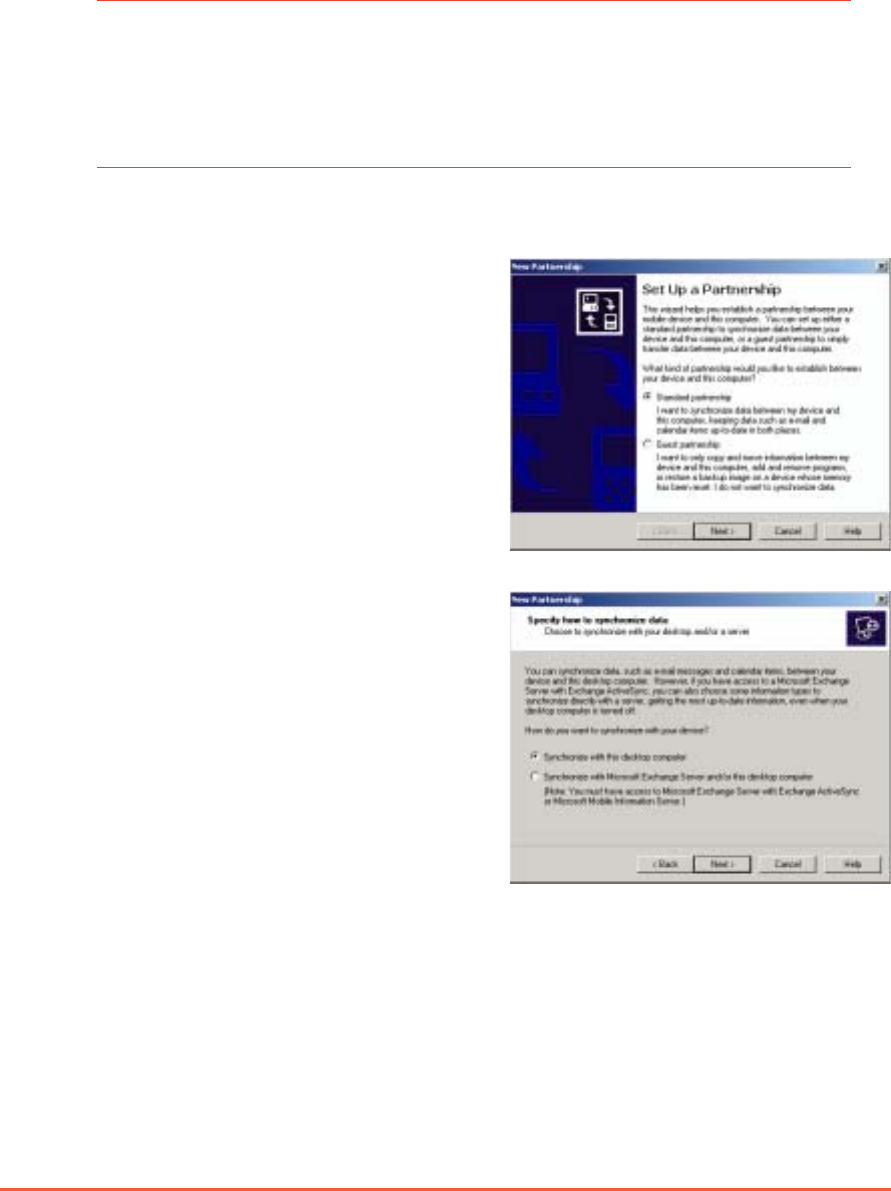
3-8
P505 Pocket PC
Setting up a partnershipSetting up a partnership
Setting up a partnershipSetting up a partnership
Setting up a partnership
Immediately after you have completed the installation, the NewNew
NewNew
New
PartnershipPartnership
PartnershipPartnership
Partnership wizard will start automatically to help you establish a
partnership and customise your synchronisation settings. At this
point, you can decide exactly which types of information you would
like to synchronise with your computer.
2. On the next screen, select
Synchronise with theSynchronise with the
Synchronise with theSynchronise with the
Synchronise with the
desktop computerdesktop computer
desktop computerdesktop computer
desktop computer. Click
NextNext
NextNext
Next.
To set up a partnership:To set up a partnership:
To set up a partnership:To set up a partnership:
To set up a partnership:
1. When the New PartnershipNew Partnership
New PartnershipNew Partnership
New Partnership
screen appears, select
Standard partnershipStandard partnership
Standard partnershipStandard partnership
Standard partnership for
the type of partnership to
establish between your device
and your computer. Click NextNext
NextNext
Next.
Apartnershippartnership
partnershippartnership
partn e r ship is a file that allows you to synchronise your
device with your desktop computer. This file is stored on your
desktop computer. An additional file that enables your
desktop computer to recognise your device is stored on your
device.
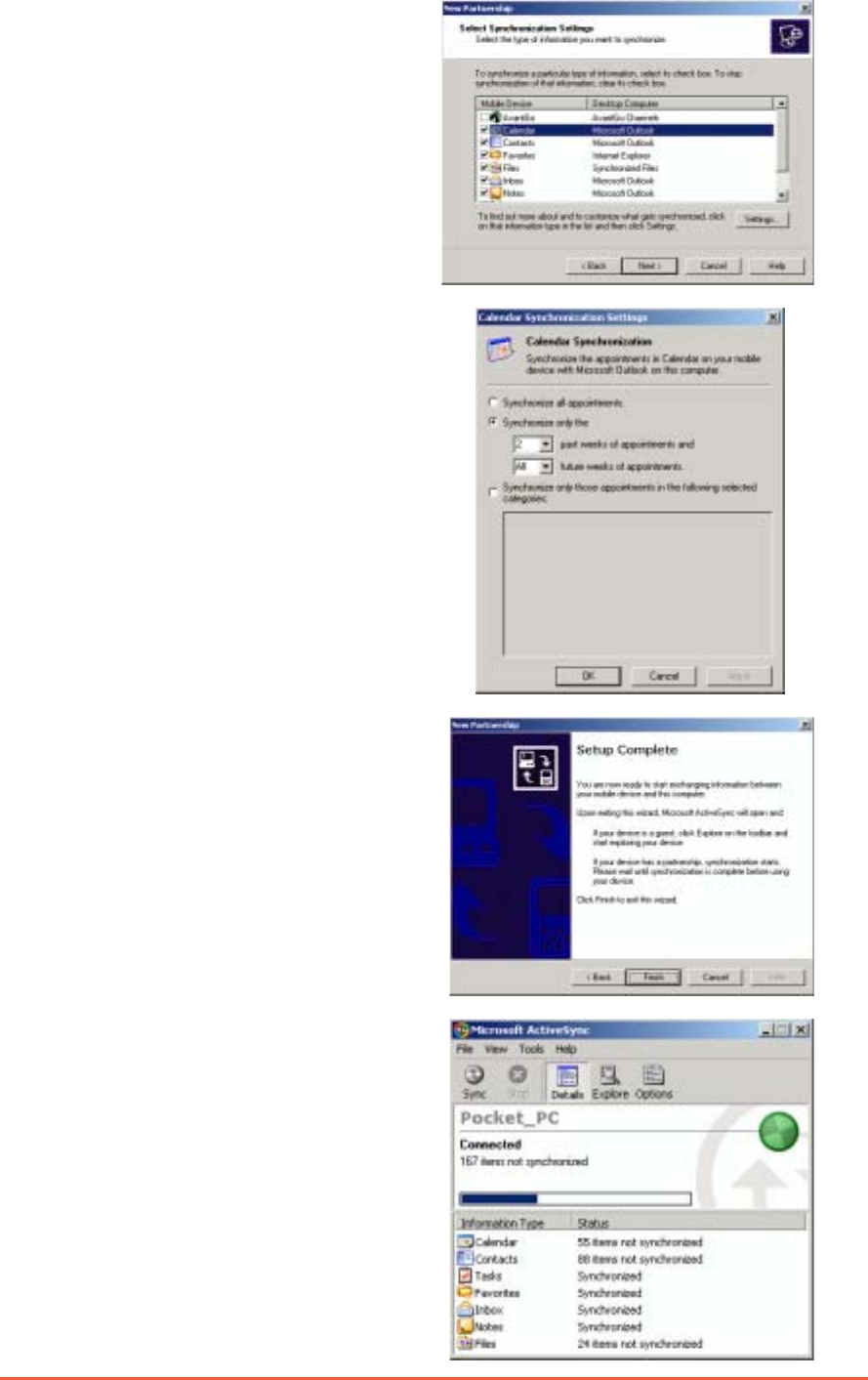
Chapter 3: Synchronising Data
3-9
On the CalendarCalendar
CalendarCalendar
Calendar
Synchronisation SettingsSynchronisation Settings
Synchronisation SettingsSynchronisation Settings
Synchronisation Settings
window, for example, select
from the options how you wish
to synchronise the
appointments on your device
with your computer. Click OKOK
OKOK
OK.
4. Click FinishFinish
FinishFinish
Finish to complete
setting a partnership.
Immediately after you set up a
partnership, ActiveSync
®
starts
automatically and initiates the
first synchronisation between
your device and your computer.
Refer to the succeeding
sections for more details on
synchronisation.
3. Select the type of information
that you wish to synchronise.
Click NextNext
NextNext
Next.
OROR
OROR
OR
If you wish to customise a
synchronised item, highlight
the item then click SettingsSettings
SettingsSettings
Settings.
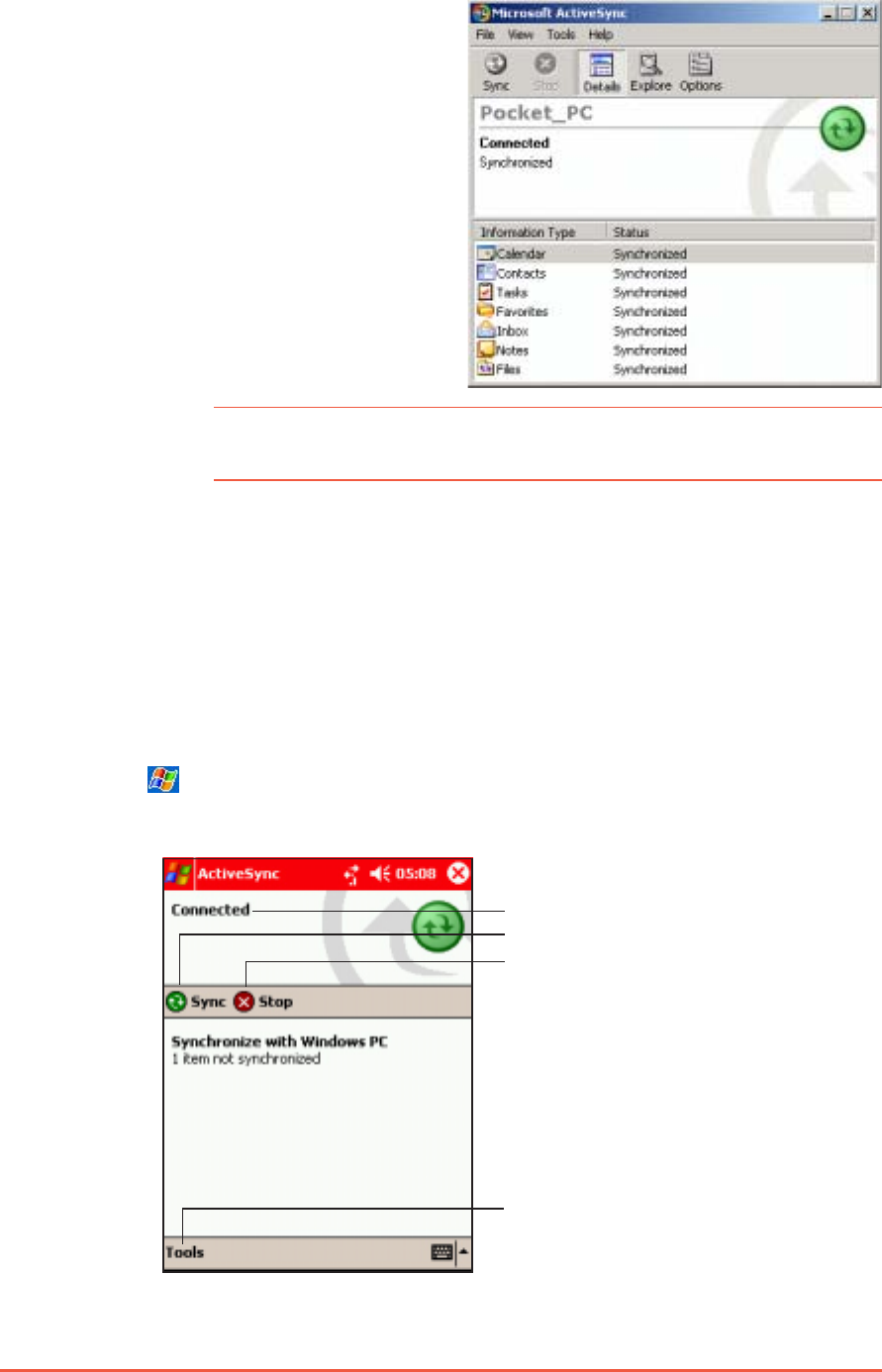
3-10
P505 Pocket PC
Manually initiating synchronisationManually initiating synchronisation
Manually initiating synchronisationManually initiating synchronisation
Manually initiating synchronisation
Once you have set up ActiveSync
®
and completed the first
synchronisation process, you can initiate synchronisation from your
device at any time.
To manually initiate synchronisation:To manually initiate synchronisation:
To manually initiate synchronisation:To manually initiate synchronisation:
To manually initiate synchronisation:
1. Tap , then tap ActiveSyncActiveSync
ActiveSyncActiveSync
ActiveSync
®
to display the ActiveSync
®
screen.
Connection status
Tap to connect and synchronise
Tap to stop synchronisation
Tap to synchronise via IR or change
synchronisation settings
Checking synchronised informationChecking synchronised information
Checking synchronised informationChecking synchronised information
Checking synchronised information
After your first synchronisation,
take a look at Calendar, Contacts,
and Tasks on your device. You
will notice that the calendar
information in Microsoft
®
Outlook
on your computer was copied to
your device, and the information
that you have on your device was
copied to your computer.
NOTENOTE
NOTENOTE
N O T E Open Microsoft® Outlook on your desktop computer to see
the details of copied information from your device.
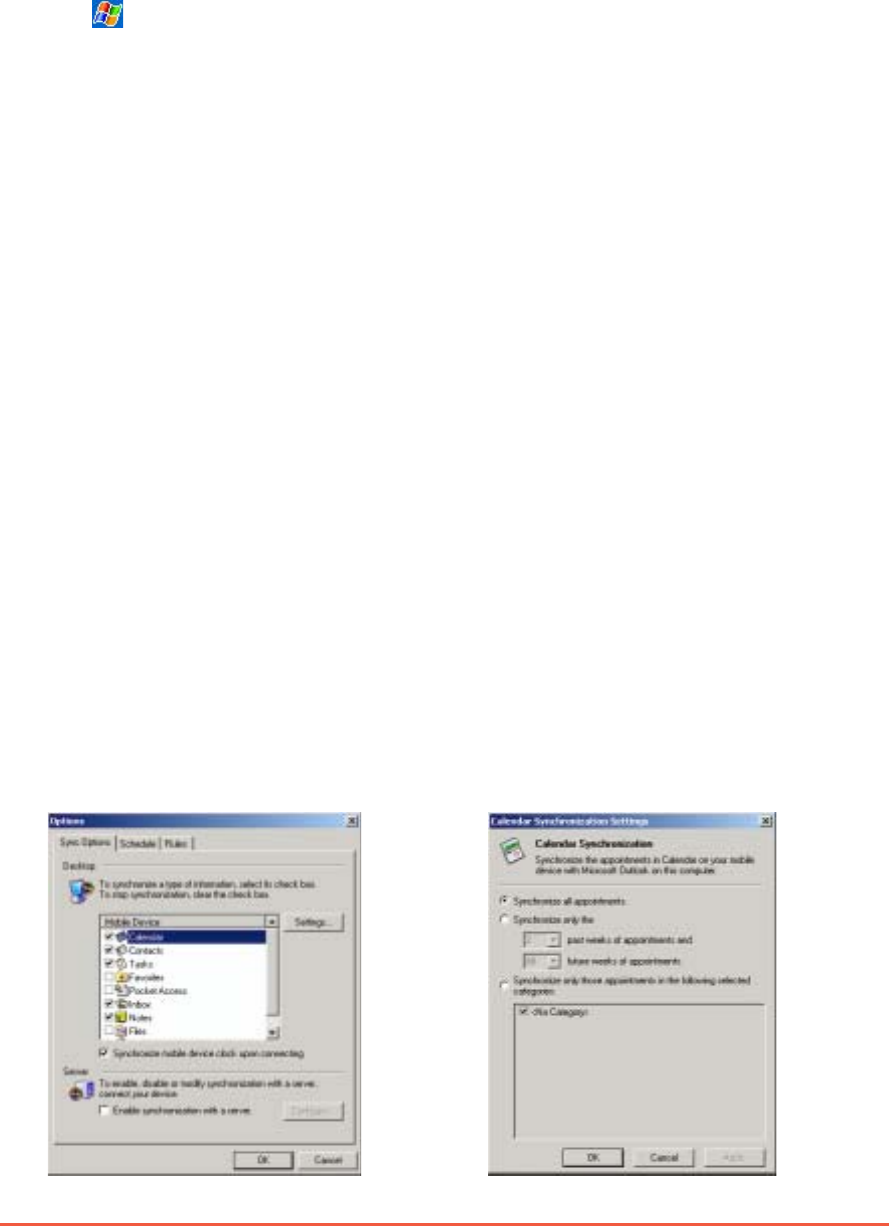
Chapter 3: Synchronising Data
3-11
2. To start synchronisation, make a connection between your device
and your computer, then tap SyncSync
SyncSync
Sync.
To end synchronisation, tap StopStop
StopStop
Stop.
For more information on synchronisation:For more information on synchronisation:
For more information on synchronisation:For more information on synchronisation:
For more information on synchronisation:
Tap while in the ActiveSync
®
screen, then tap HelpHelp
HelpHelp
Help.
Synchronisation optionsSynchronisation options
Synchronisation optionsSynchronisation options
Synchronisation options
The Microsoft
®
ActiveSync
®
program allows you to customise your
synchronisation settings at any time. You can select the items to
synchronise, set the synchronisation schedule, and specify the
synchronisation rules.
To display the synchronisation options:To display the synchronisation options:
To display the synchronisation options:To display the synchronisation options:
To display the synchronisation options:
• From the ActiveSync
®
window on your desktop computer, click on
the OptionsOptions
OptionsOptions
Options icon, or
• From the menu bar, click on ToolsTools
ToolsTools
Tools, then OptionsOptions
OptionsOptions
Options.
To select items to synchronise:To select items to synchronise:
To select items to synchronise:To select items to synchronise:
To select items to synchronise:
1. Check the box opposite the item that you wish to synchronise.
2. Highlight a checked item then click on SettingsSettings
SettingsSettings
Settings to specify
synchronisation options for the item.
For example, highlight CalendarCalendar
CalendarCalendar
Calendar then click on SettingsSettings
SettingsSettings
Settings to
display the Calendar Synchronisation SettingsCalendar Synchronisation Settings
Calendar Synchronisation SettingsCalendar Synchronisation Settings
Calendar Synchronisation Settings window.
Customise the available settings, then click OKOK
OKOK
OK when done.
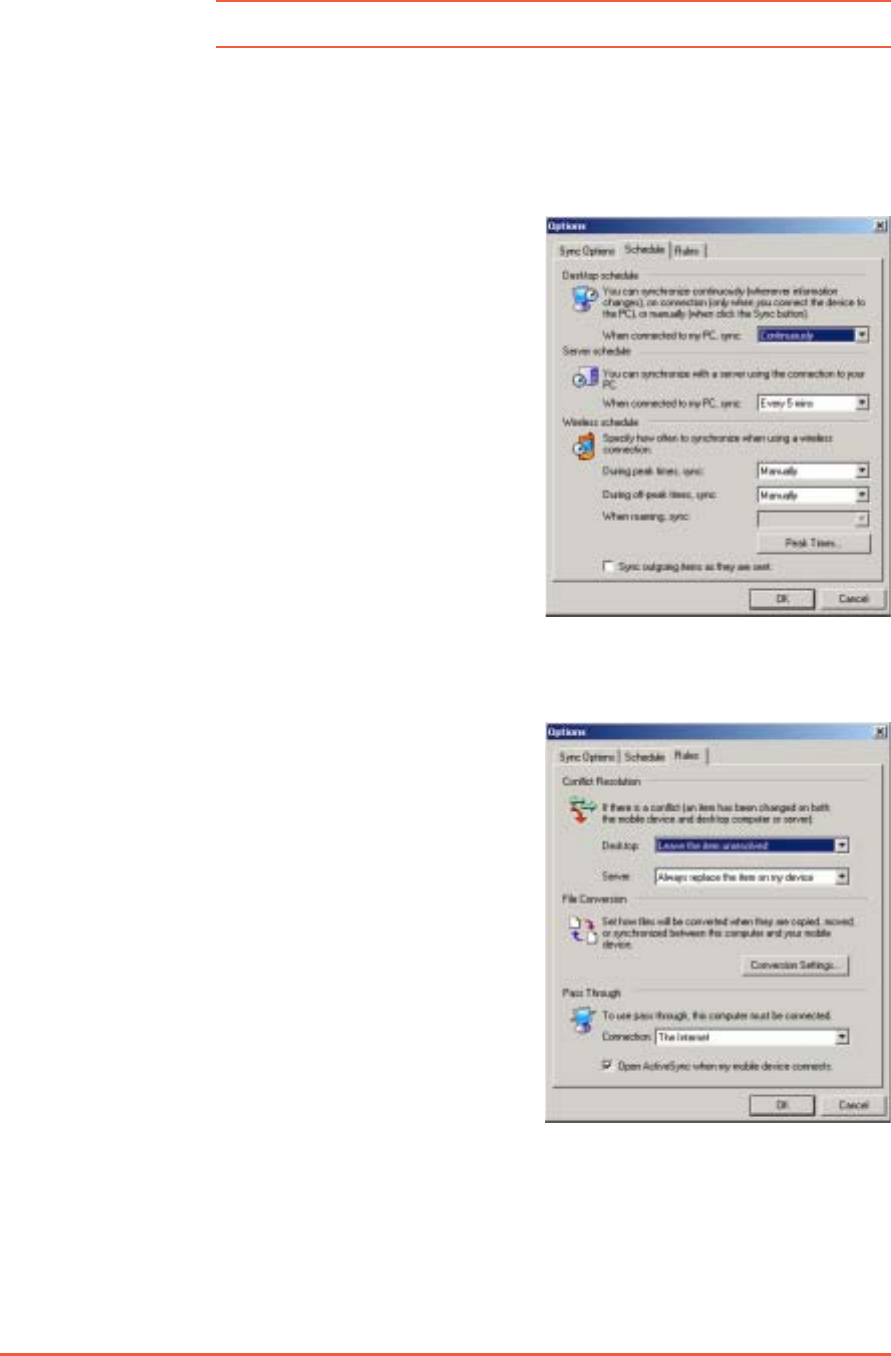
3-12
P505 Pocket PC
To set synchronisation schedule:To set synchronisation schedule:
To set synchronisation schedule:To set synchronisation schedule:
To set synchronisation schedule:
1. Click on the ScheduleSchedule
ScheduleSchedule
Schedule tab.
2. Select your desired
synchronisation schedule.
3. Click OKOK
OKOK
OK when done.
To specify synchronisation rules:To specify synchronisation rules:
To specify synchronisation rules:To specify synchronisation rules:
To specify synchronisation rules:
1. Click on the RulesRules
RulesRules
Rules tab.
2. Select your desired settings
from the available options.
3. Click OKOK
OKOK
OK when done.
3. Do the same for the other checked items.
NOTENOTE
NOTENOTE
N O T E You cannot set the options for unchecked items.
4. Click OKOK
OKOK
OK when done.

Chapter 4
Using Pocket Outlook
This chapter details the
procedures in using the
Microsoft
®
Pocket Outlook
Calendar, Tasks, Notes, and
Contacts.

4-2
P505 Pocket PC
Chapter summaryChapter summary
Chapter summaryChapter summary
Chapter summary
••
••
•IntroductionIntroduction
IntroductionIntroduction
Introduction ..................................................................................................
..................................................................................................
................................................. 4-3
••
••
•Calendar: Scheduling appointments and meetingsCalendar: Scheduling appointments and meetings
Calendar: Scheduling appointments and meetingsCalendar: Scheduling appointments and meetings
Calendar: Scheduling appointments and meetings
Creating appointments .................................................... 4-4
Using the summary screen ............................................... 4-5
Creating meeting requests ............................................... 4-5
Sending appointments ..................................................... 4-7
••
••
•Tasks: Keeping a to do listTasks: Keeping a to do list
Tasks: Keeping a to do listTasks: Keeping a to do list
Tasks: Keeping a to do list
Creating tasks.................................................................. 4-8
Using the summary screen ............................................. 4-10
Sending tasks ................................................................ 4-10
••
••
•Notes: Capturing thoughts and ideasNotes: Capturing thoughts and ideas
Notes: Capturing thoughts and ideasNotes: Capturing thoughts and ideas
Notes: Capturing thoughts and ideas
Creating notes ............................................................... 4-12
••
••
•Contacts: Tracking friends and colleaguesContacts: Tracking friends and colleagues
Contacts: Tracking friends and colleaguesContacts: Tracking friends and colleagues
Contacts: Tracking friends and colleagues
Creating contacts .......................................................... 4-14
Using the summary screen ............................................. 4-15
Changing a contact information display ......................... 4-15
Getting in touch with your contacts .............................. 4-16
Finding a contact ........................................................... 4-19
Adding a photo to a contact .......................................... 4-20